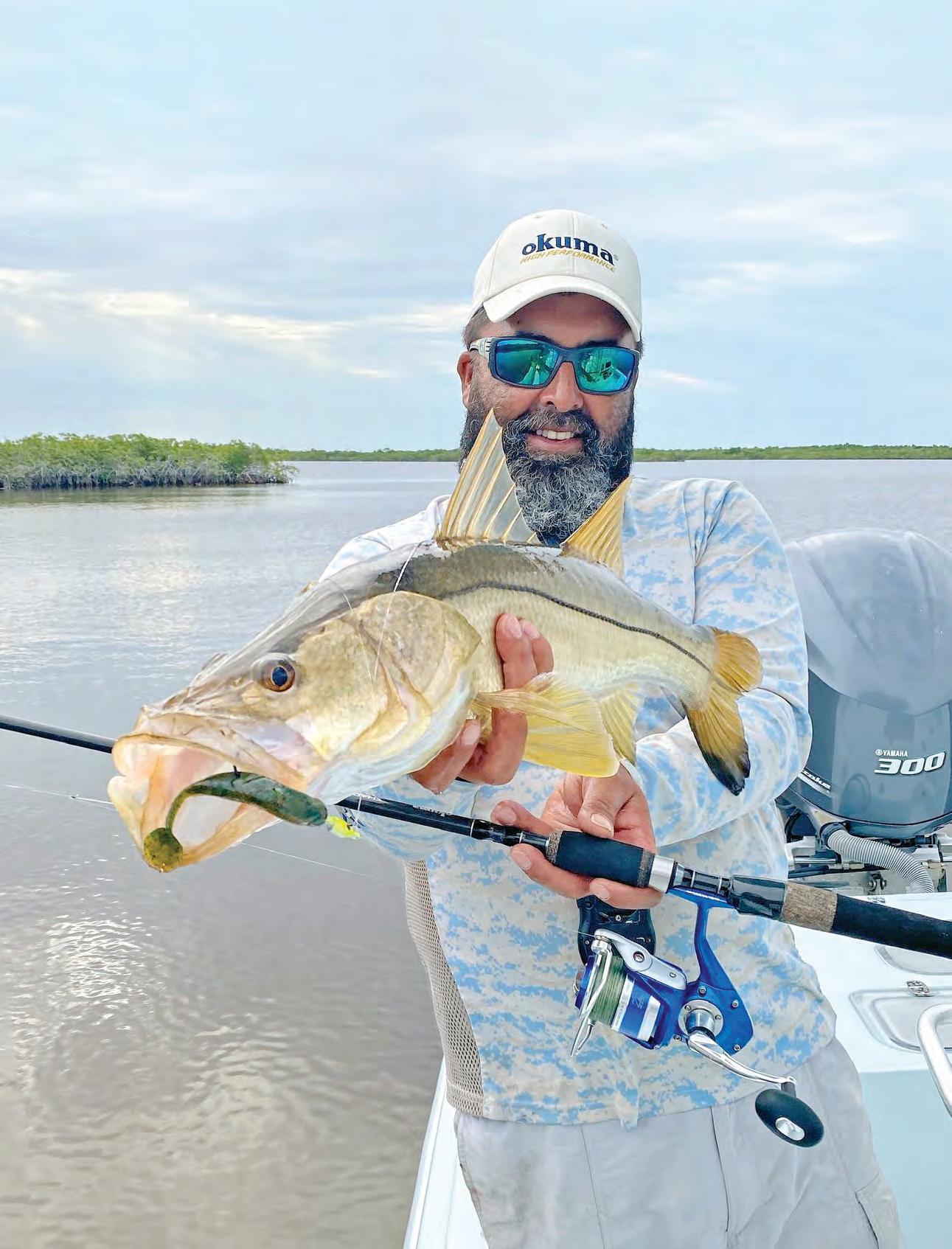



@CAMTAMagazine SEPTEMBER 2023 PHOTO COURTESY OF OKUMA WWW.OKUMAFISHINGUSA.COM IG: @OKUMAFISHINGUSA VOLUME 4 • ISSUE 2 FRANCHISE OPPORTUNITIES AVAILABLE WORLDWIDE WATCH VIDEO
SNOOK
BASS ON BUGS
FLORIDA
SEASON THE OFFSHORE TRANSITION
Love

If you are passionate about the outdoors and want to enjoy the freedom and benefits of owning your own business, come join our team of successful franchisees by publishing a Coastal Angler or The Angler Magazine in your area. Exclusive Territories Available Nationwide!

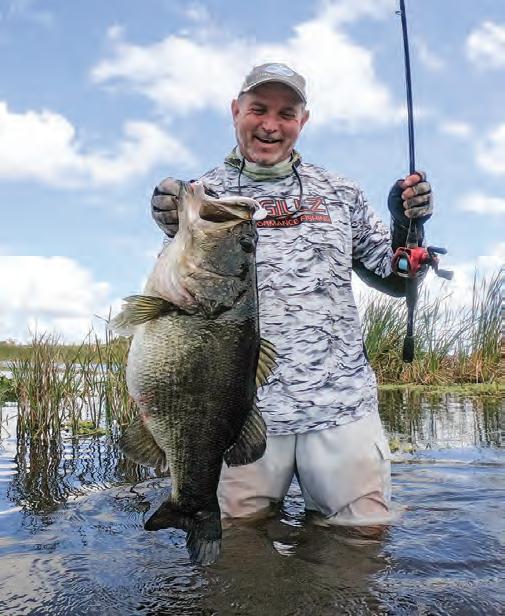


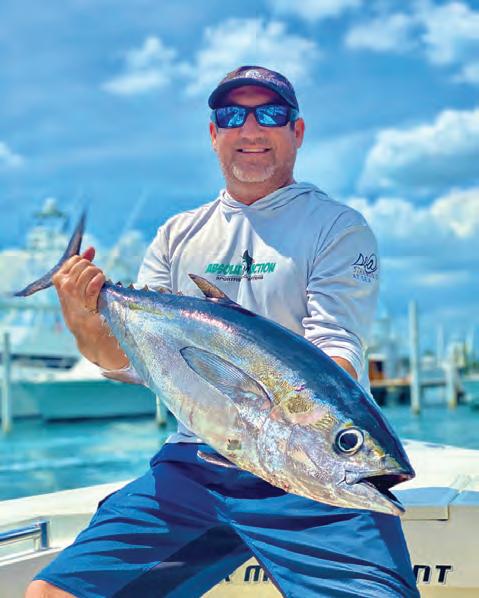


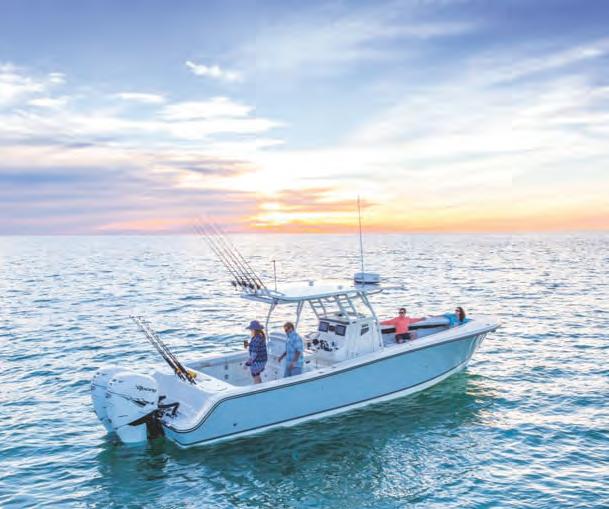

the outdoors? Self-motivated?
meeting new people?
Enjoy
Franchise Opportunities Available Nationwide! PUBLISH YOUR OWN FISHING MAGAZINE Established Brand • Proven Systems Complete Training & Ongoing Support Low Startup Costs and Overhead Work From Home • Be Your Own Boss FREE PHOTO COURTESY OF: ABSOLUTE ACTION SPORTFISHING CHARTERS ABSOLUTEACTIONFISHING.COM / IG: @ABSOLUTEACTIONFISHING @CAMTAMagazine LOCAL PHOTOS & FORECASTS SPRING OFFSHORE TUNAS,KINGSSAILS,& MORE! INSHORE TRANSITIONS BREVARD/VOLUSIA EDITION FREE @CAMTAMagazine FRANCHISE OPPORTUNITIES AVAILABLE WORLDWIDE THEANGLERMAG.COM MARCH 2022 VOLUME 27 • ISSUE 324 JURASSIC BASS! SPRING SPAWNING RUNS PHOTOSLOCAL FORECASTS& PHOTO CREDIT: PAUL MACINNIS IG: @RSOCFISHING
COME JOIN OUR TEAM!

Be a Part of the Largest Outdoor Publication in the U.S.
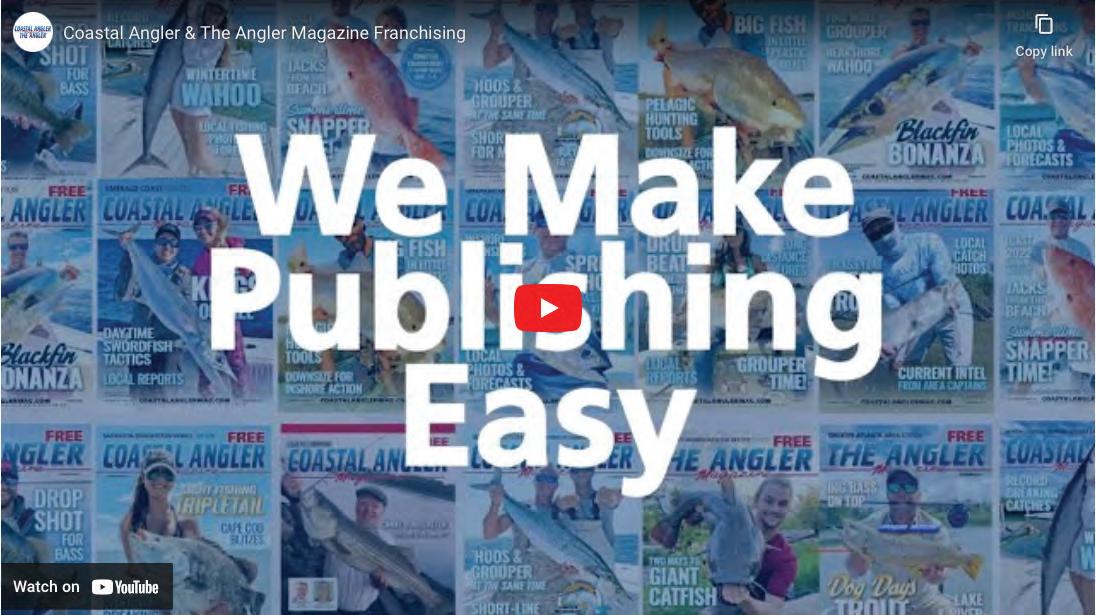
With a combined national readership of over a million per month and distribution to over 11,000 businesses in four regions, Coastal Angler Magazine and The Angler Magazine are the preferred resources for anglers and outdoor enthusiasts. Our brand is well known throughout the fishing world, and our free monthly magazines are recognized as well-designed, thoughtful publications that provide newsworthy and entertaining information pertinent to the marine and fishing industries.
Be in Business For Yourself...But Not By Yourself. An exceptionally rewarding and fulfilling business opportunity, as a co-publisher of your area’s Coastal Angler or The Angler Magazine, you’ll enjoy the benefits of controlling your own time and future. Our proven franchise publishing system enables individuals with no prior publishing experience to publish a credible and profitable localized version of our award winning magazine. We provide complete training and on-going support to ensure your success.
For more information visit: www.franchise.coastalanglermag.com 321-777-2773 • info@coastalanglermagazine.com
MAXIMIZE YOUR OUTPUT

With Dometic’s Mega Jackplate

ENGINEERED TO HANDLE THE STRONGEST OUTBOARD ENGINES ON THE MARKET
Today’s engine manufacturers are building engines that are more powerful and heavier than ever before. Dometic’s new Mega Jackplate has been developed to withstand the power of high performance engines and provide boaters with the ability to maximize the output of their engines while offering more flexibility in shallow water. The Mega Jackplate is rated to 600 HP and is an extension of our existing product line. It will be offered in 6”, 8” and 10” setbacks. There will be 2 versions available, a standard bolt pattern designed to fit engines like Yamaha XTO and a wide bolt pattern designed to fit Merc 500/600.
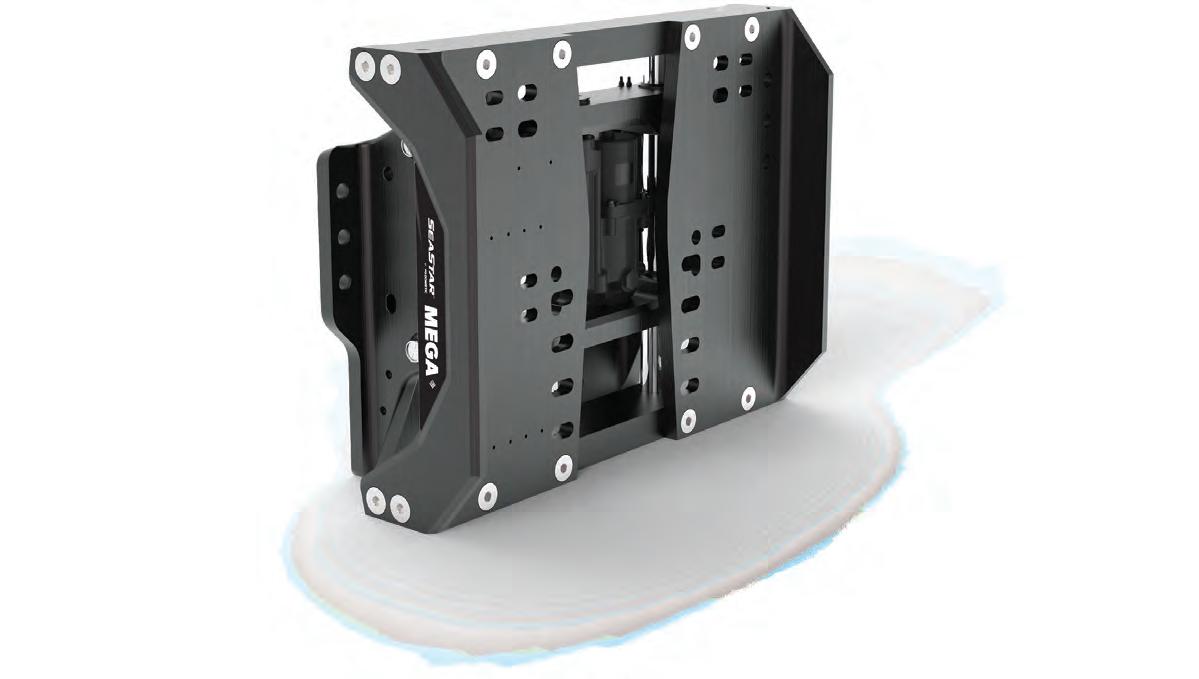
www.dometic.com
JACKED UP!
The Benefits of Precision Outboard Height Adjustment

Electro-hydraulic jack plates give owners of outboard-powered fishing boats a couple of key performance advantages. For one, installing a jack plate on an outboard boat provides some setback between the motor and the transom. This allows the propeller to operate in less turbulent water, and can help increase performance and reduce cavitation, which occurs when the prop is spinning in aerated water and begins to “break loose.”
The second and perhaps more important advantage is the ability to precisely adjust the height of the motor on the transom with the touch of a button—independent of the outboard’s trim angle. You’re most likely to find jack plates installed on freshwater bass boats, bay boats, hybrid bay/offshore boats, flats skiffs and tunnel hulls. In these applications, adjusting the engine

can help a boat’s “hole shot,” which is when you punch it from standing still to get the boat up onto plane. What you don’t want — especially in shallow water — is for the boat to rise too much in the bow and squat in the rear as it climbs out of “the hole.” Finding just the right motor height to provide the propeller with the ideal combination of grip and slip can push the boat quickly onto plane. This is important, as too much bite will make the boat bog down, and too much slip will cause the propeller to break loose and lose thrust.
Another benefit of electro-hydraulic jack plates is the ability to run a boat in shallower water. This holds true whether you’re on plane jetting across a flat or inching a large center console up onto a shelf to throw a castnet.
Dometic’s newest entry into the jack plate market is its new Mega Plate. This electro-hydraulic system is engineered specifically for today’s breed of large, hi-horsepower outboard motors. In fact, Mega Plate is designed for use with motors ranging from 400HP all the way up to the new V-12 600HP outboard from Mercury. It is offered in 6-inch, 8-inch and 10-inch setbacks to accommodate a range of vessel types and installations. Mega Plate is offered in two versions — a standard bolt pattern for Yamaha XTO and Mercury 450R engines, and a wide bold pattern for Mercury 500 and 600HP motors.
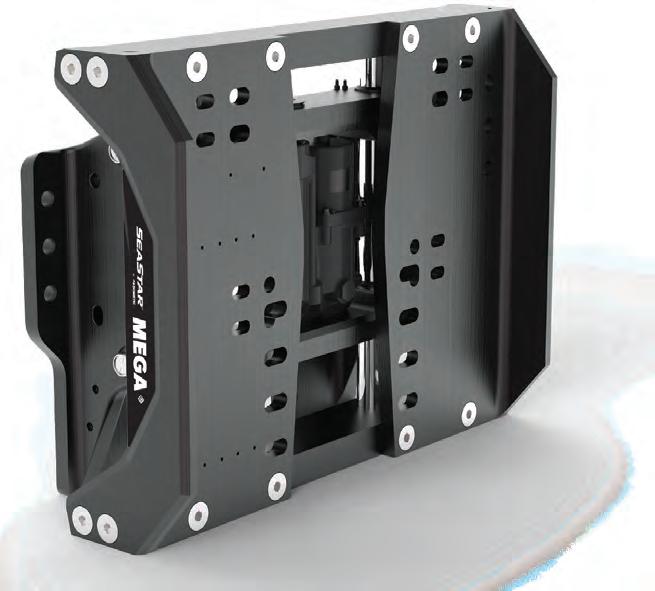
Dometic’s built-in Smartstick Linear Position Sensor and ability to integrate with Dometic Digital Switching technology compatible with all HTML5 capable MFDs give boaters complete control of multiple engine height positions with the touch of a finger.

THE ANGLER VIDEO MAGAZINE SEPTEMBER 2023 5
To learn more about premium quality jack plates from Dometic Marine, visit www.dometic.com
LAST-DAY MARLIN WINS $6.2 MILLION
WATCH VIDEO

Let’s talk about high stakes.
On Aug. 11, the final day of the 50th Annual White Marlin Open out of Ocean City, Maryland, a 640.5-pound blue marlin was brought to the scales that earned the winning boat $6.2 million. Tournament organizers are calling it the largest payout for a single fish in history.

The Floor Real, out of Ocean City, was the only boat to land a billfish that qualified for weigh-ins. In the tournament, blue marlin must be 114 inches and whites must be 70 pounds to qualify for the scales. Angler John Ols’ 118-inch,
640.5-pound blue left no doubt on the fourth and final day and electrified the crowd at the scales before taking most of the tournament’s $10.5 million total purse.
But let’s back up the timeline. Before Ols’ fish came to the scales, another Ocean City boat, the Ro Sham Bo, was looking at a potential $7.1 million payday. In the $50k Winner Take All level, Angler Rusty Shriver, of Leonardtown, Maryland, had caught a 215-pound big eye tuna that was the heaviest tuna in the division. The crew of Ro Sham Bo must have been on pins and needles before the big marlin made it back
to the docks. According to tournament rules, their tuna would have taken the marlin money if no qualifying marlin had made it to the scales. Ro Sham Bo ended up earning $1.7 million, and although it’s hard to fathom being disappointed with $1.7 million in winnings, the crew must be haunted by thoughts of what could have been.
Overall, 400 boats registered to fish the tournament. Unofficially, 551 white marlin and 46 blue marlin were caught, but only three were brought in, and only two were weighed.
For complete results, visit whitemarlinopen.com.



THE ANGLER VIDEO MAGAZINE SEPTEMBER 2023 7
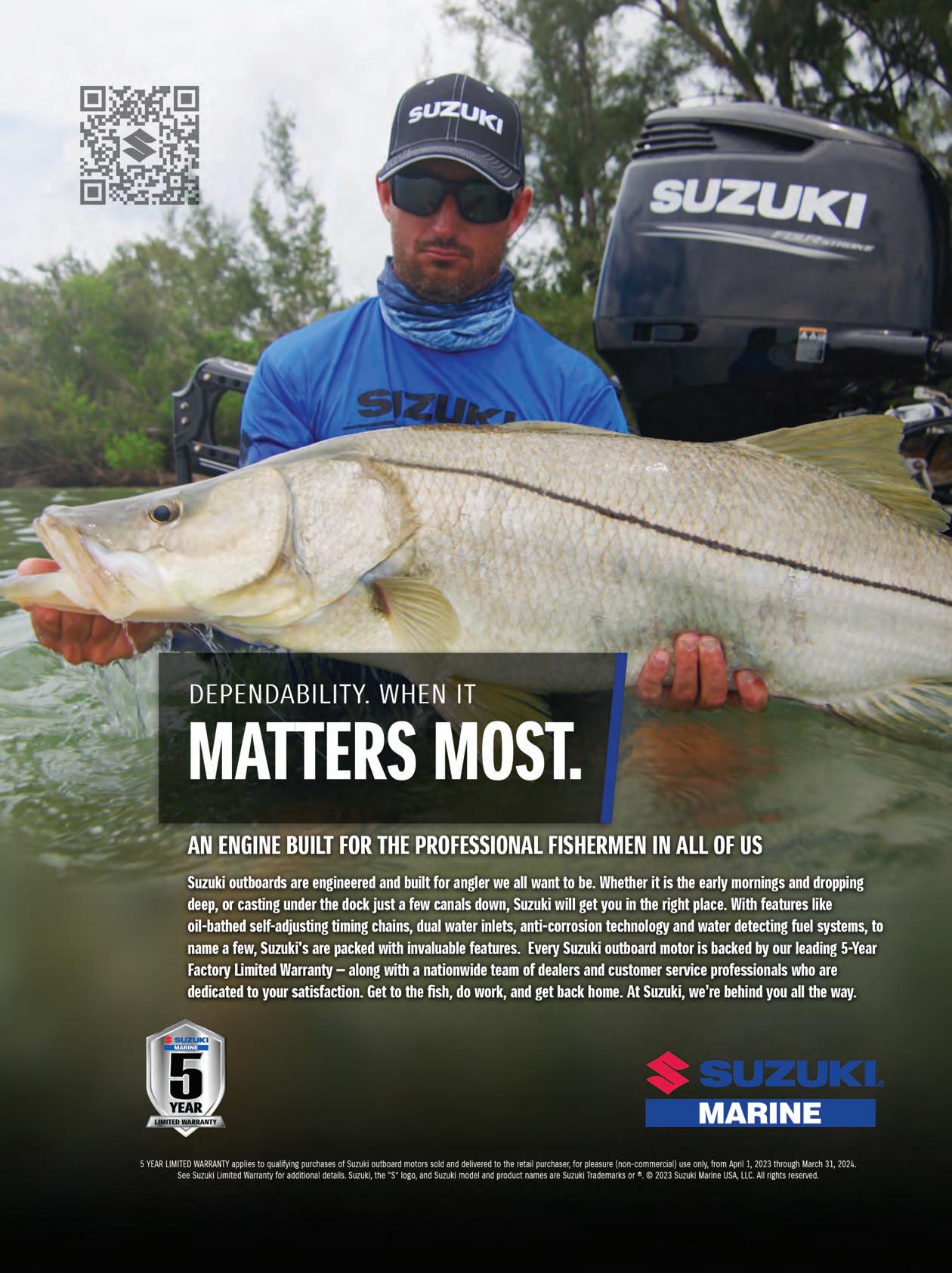
SUZUKI MARINE USA INTRODUCES NEW DF350AMD/ DF300BMD OUTBOARDS
Suzuki’s Flagship V6 Outboards First to Feature Integrated Steering, New Streamlined Lower Gear Case
Suzuki Marine, USA LLC has launched two new additions to its powerful lineup of outboard motors — the newfor-2023 DF350AMD and DF300BMD V6 4-strokes.
These 350 and 300 horsepower models with contra-rotating twin propellers are the first Suzuki outboards to offer the benefits of advanced integrated steering. Integrated steering allows for more streamlined rigging of these V6 outboards on a range of inshore, offshore and freshwater boats, while also providing a cleaner appearance in the motor well. Because integrated steering eliminates concerns about interference and clearance issues created by external steering cylinders, boat builders can more easily rig these popular outboards on a variety of hull types in single or multiple engine configurations. Integrated steering also reduces the possibility of the steering cylinder hitting the motor well if the outboard is tilted too far forward.
Suzuki has also engineered a new lower gear case for the DF350AMD and DF300BMD (also available on all five series 350A/300B models), designed to enhance durability,
increase top-speed performance, improve fuel efficiency and make maintenance and service easier. The new design delivers superior gear lubrication and maintains the gear oil at a lower temperature, increasing durability and reliability over the long run — even in the toughest operating conditions.
The external surface area of this new gear case has also been reduced and reshaped, allowing the lower unit to slice through the water with less resistance. By doing this, Suzuki is able to deliver a marked improvement in both fuel efficiency and top-end performance for today’s boats. This streamlined gear case has the added benefit of reducing the amount of gear oil required from 3.2L to 2.8L. This new gear case also features a new oil passage that allows users to easily change the gear oil with Suzuki’s gear oil changer without having to lift the boat. This improvement will make it easier for boaters to stay on top of scheduled maintenance and keep their new Suzuki’s running strong season after season.
These new flagship models offer all the advanced technology and performance boaters expect from Suzuki’s popular
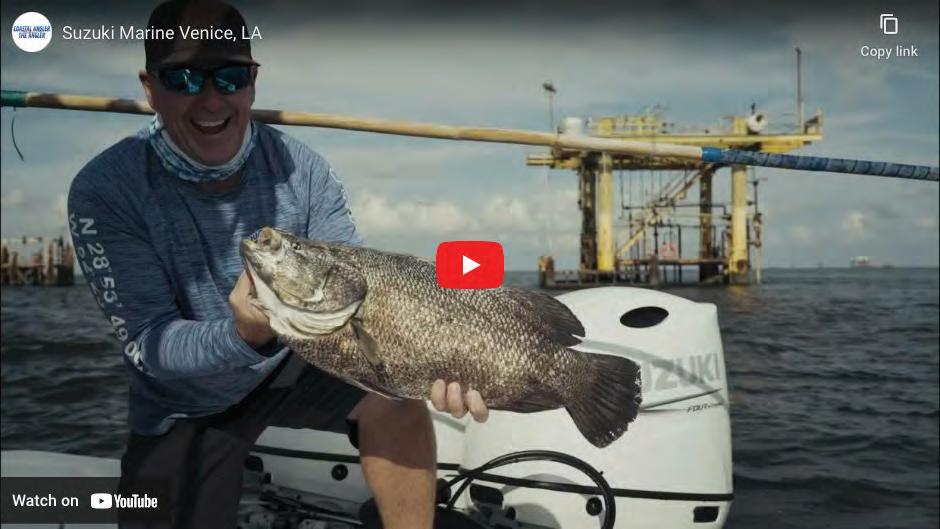
DF350A and DF300B models (which will still be available in their original configuration). In addition to the proven performance and efficiency benefits of Suzuki’s dual-prop system, these motors boast a long list of features including a unique dual-louver air intake system, dual fuel injectors, variable valve timing, a self-adjusting timing chain, offset driveshaft design, Suzuki Lean Burn Technology, and more.
To learn more about the new DF350AMD and DF300BMD V6 4-strokes, or Suzuki Marine’s industry leading line-up of outboard motors from 2.5 to 350 horsepower, contact Suzuki Marine USA headquarters at (813) 687-7200 or visit www.suzukimarine.com.


THE ANGLER VIDEO MAGAZINE SEPTEMBER 2023 9
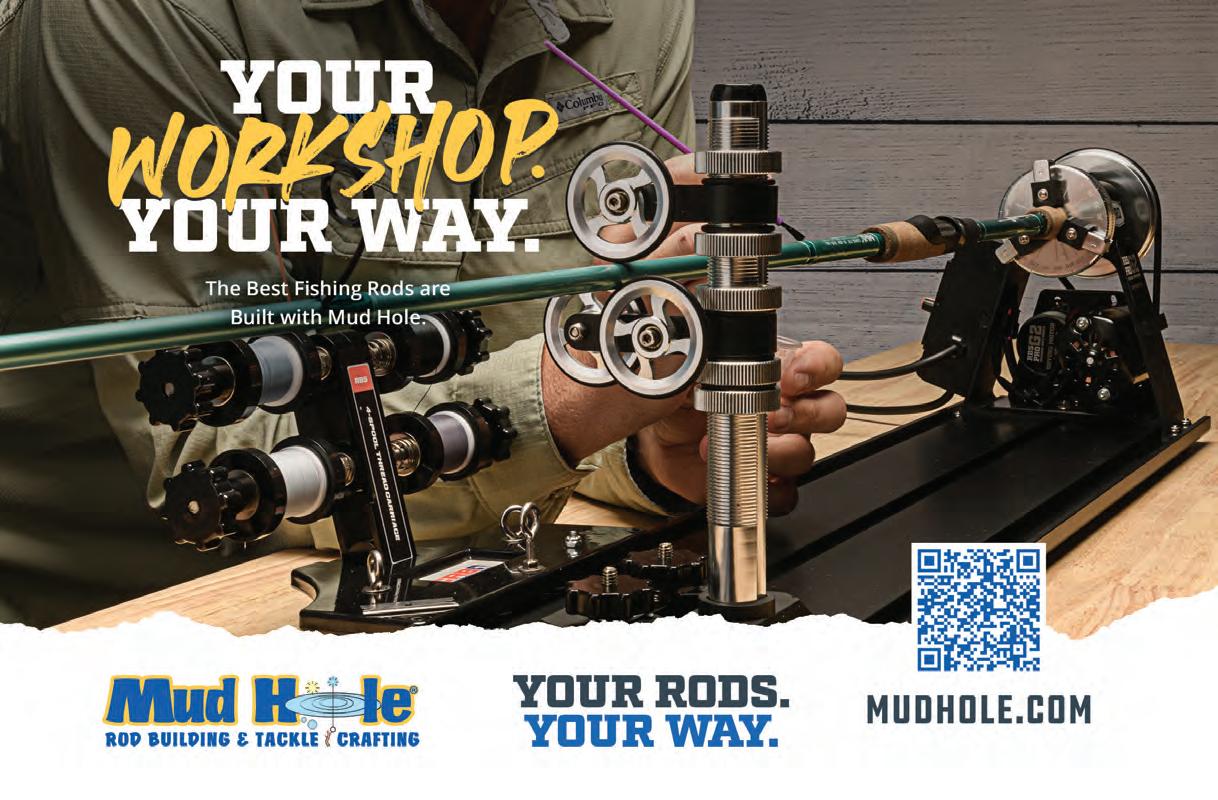
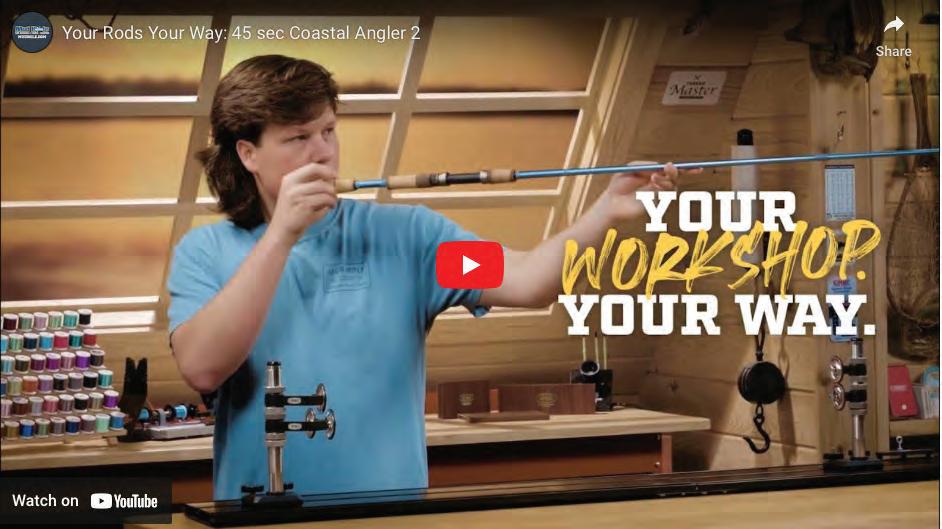
10 SEPTEMBER 2023 THE ANGLER VIDEO MAGAZINE
FLOUNDER LATE SUMMER’SForgotten

September is a new beginning of sorts when it comes to saltwater fishing on the Gulf Coast. First, it is somewhat cooler, although some of our visiting northern neighbors might not agree. Many anglers find themselves torn between other passions and obligations, some of which include school in session, weekend sporting events, dove and deer hunting, and the list goes on. These activities thin the herd of boats on the water and opens the bays back up for those of us who focus all of our free time on the water.
This is definitely noticeable at the boat ramp the first weekend after Labor Day, and I can’t wait!
Less boat traffic means fishing the mouths of bayou drains is wide open. I avoid these areas for safety reasons when there’s heavy boat traffic. I just don’t like boats driving over my lines or waking me, which is what happens if you fish in a boat lane during peak season. I like drains in back lakes this time of the year, because they hold “the big three”: trout, redfish and flounder.
I will specifically target flounder in these areas in September and early October. Since the spring migration, these tasty morsels have been working their way as far back in the marsh as they could get. With autumn around the corner, they start to congregate in these drains. Outside of the fall run, many anglers do not target these ground huggers. With the pressure light, the flounder bite can be lights out for those who know where and how to target them. The best part is you might not see another boat all day!
An outgoing tide is optimal to stake out one of these drains. The tide carries baitfish out of the deeper bayou and adjacent marsh grass and sends it on a deadly path with hungry flounder fattening up for their winter spawn. When the bite is on, it is not uncommon to see flounder breaking free of the water’s surface chasing a meal. The first time I witnessed this years ago, it took me awhile to figure out what was jumping. I will never forget that day!

Paddletail soft plastics are my go-to in this situation. I like bright colors such as white lightning, chartreuse with glitter, or pearl with a chartreuse tail in a 4-inch or 3.25-inch bait. Keep the lure twitching along the bottom. Quick jerks with the rod tip pointing down activates the tail vibration and kicks up clouds of mud, which really grabs their attention. A soft plastic with a tail rattle adds an extra attractant.
Get a jump start on your flounder fix before the first cold front and the long lines of anglers targeting them during the fall run.
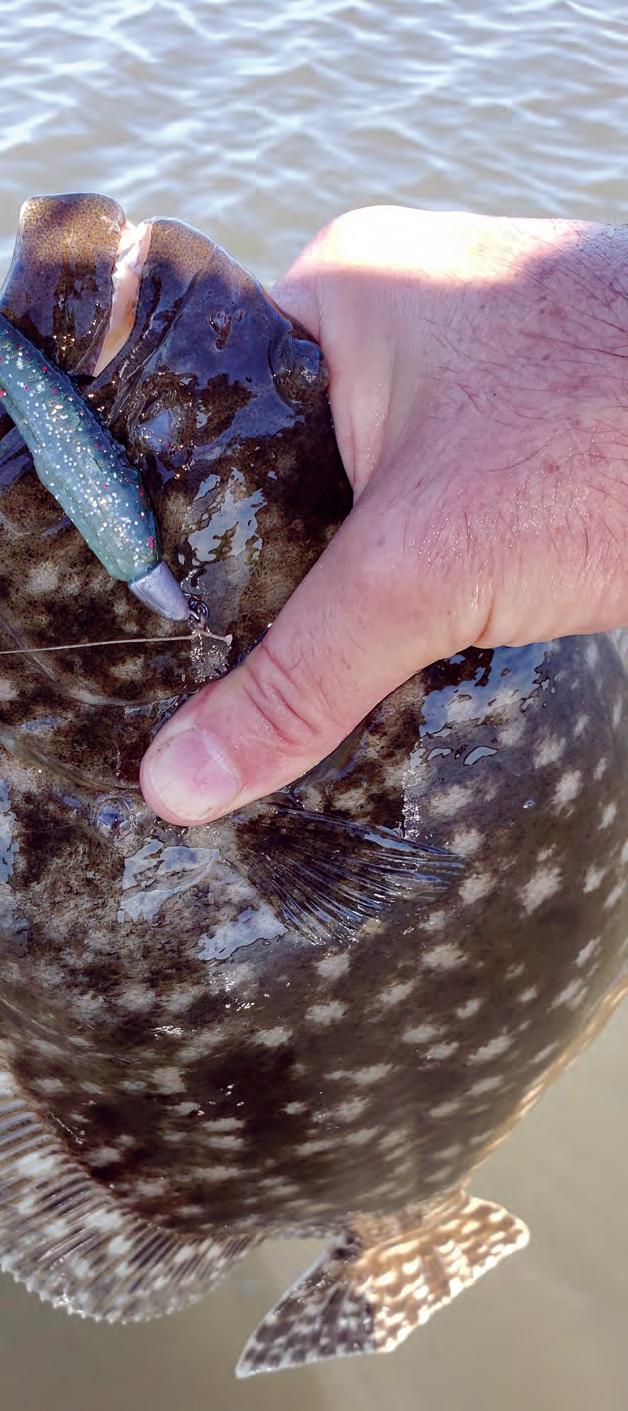
 Capt. Michael Okruhlik is the inventor of Knockin Tail Lures®, and the owner of www.MyCoastOutdoors.com.
Capt. Michael Okruhlik is the inventor of Knockin Tail Lures®, and the owner of www.MyCoastOutdoors.com.
PHOTO COURTESY OF KNOCKIN TAIL LURES® WATCH VIDEO
By Capt. Michael Okruhlik




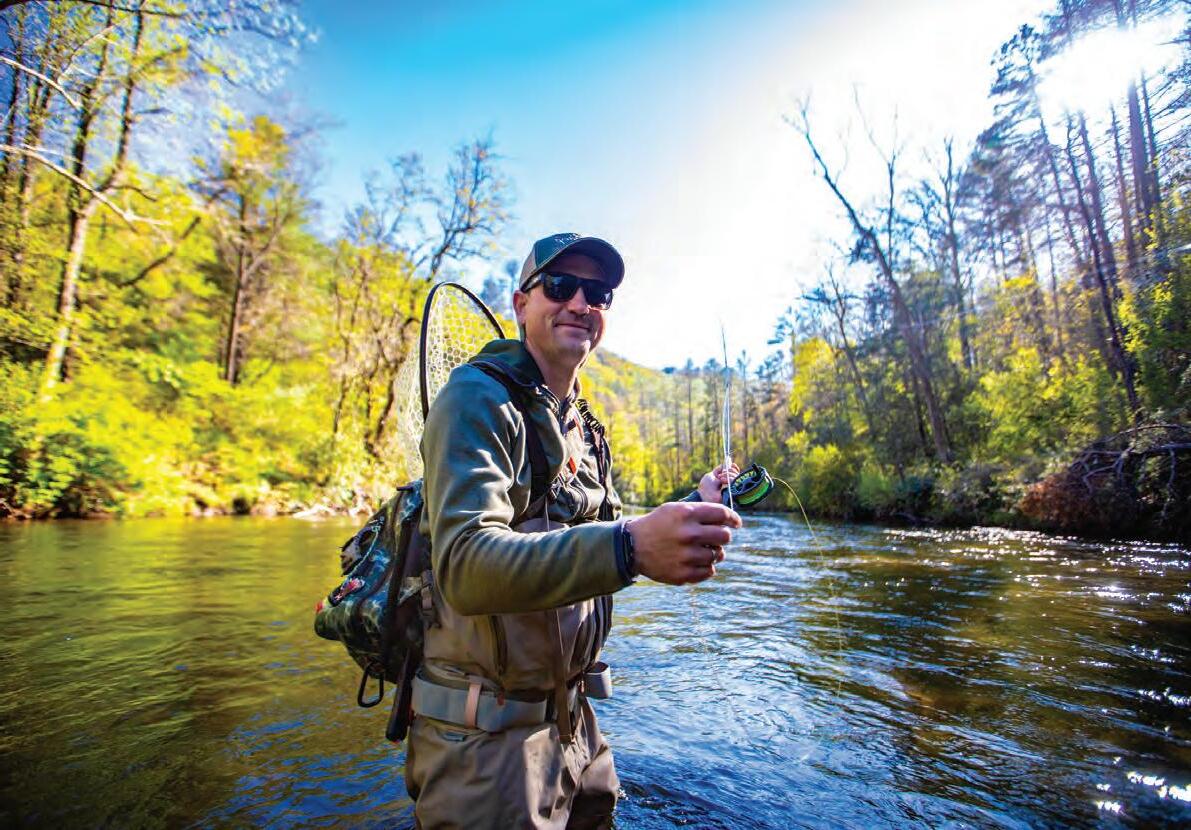
LakeHartwellCountry.com Visit LHC to plan your next fishing getaway. The art of going fishing when you should be doing something else.
CATCH THE


f eeling. feeling.
Located in the heart of Upstate South Carolina, is Lake Hartwell, a vast reservoir spanning over 56,000 acres, surrounded by the foothills of the majestic Blue Ridge Mountains. With an abundance of wildlife and scenic beauty, it’s no secret why this lake is a popular destination for anglers of all skill levels.
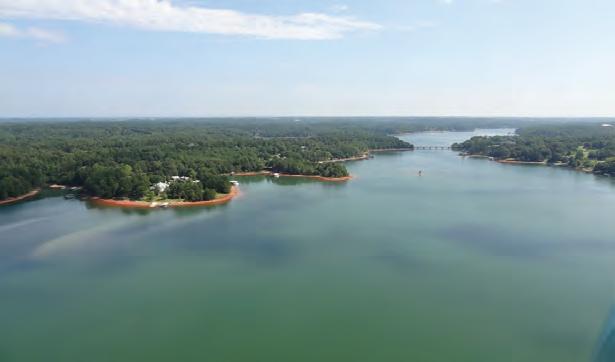

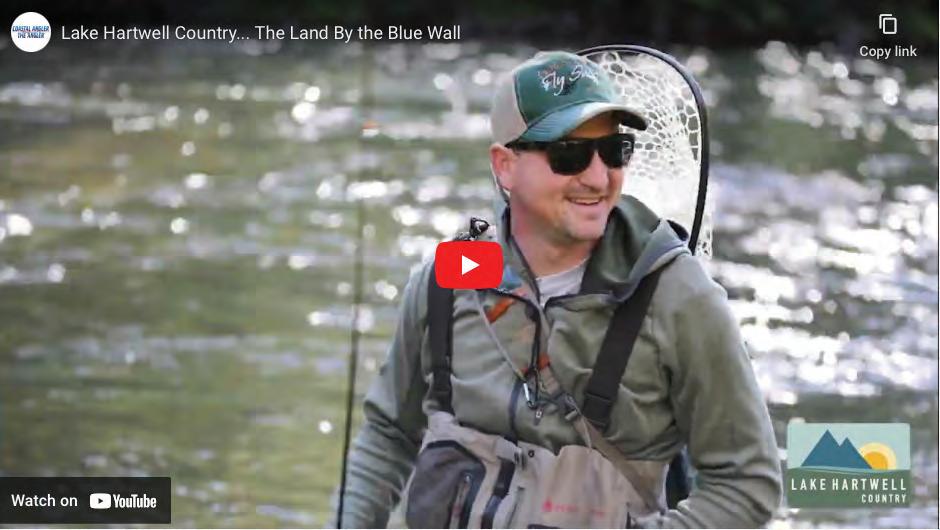
Lake Hartwell boasts a diverse range of fish species, including largemouth and striped bass, crappie, catfish, and bream. The quality and size of the fish attract many seasoned anglers for tournaments like the Bassmaster Classic, which was held on Lake Hartwell in 2022. These events contribute to the area's reputation as a popular fishing destination and provide opportunities for anglers to test their skills against others. Due to the mild climate of the Upstate, fishing is welcome year-round, with each season offering a unique experience for anglers. The lake has several public access points, marinas, and boat ramps, making it convenient for anglers to launch their boats and reach their favorite fishing spots easily. For those unfamiliar with Lake Hartwell and its surrounding area, there are many experienced fishing guides and professional services available to elevate your fishing experience.
Lake Hartwell Country’s Freshwater Species
If you are looking to get off the boat and into some waders, journey a few miles north of Lake Hartwell into the Chattooga and Chauga Rivers. Located in Mountain Rest is Chattooga River Fly Shop, a full-service fly shop with a variety of gear and knowledgeable guides. Travelers can book a full or half-day guided wade trip on either river and experience the best fly fishing nature can provide in the heart of the mountains. For more information please visit www.LakeHartwellCountry.com


LARGEMOUTH BASS REDEYE BASS BLACK CRAPPIE REDBREAST SUNFISH CHANNEL CATFISH RAINBOW TROUT BROOK TROUT BROWN TROUT STRIPED BASS HYBRID BASS
By Nick Carter













AND THE MULLET MIGRATION
Fall is a fine time to be an angler on the Florida coast. The summer crowds dwindle as the summer heat begins to taper off, and snook season opens Sept. 1 ahead of the mullet run.
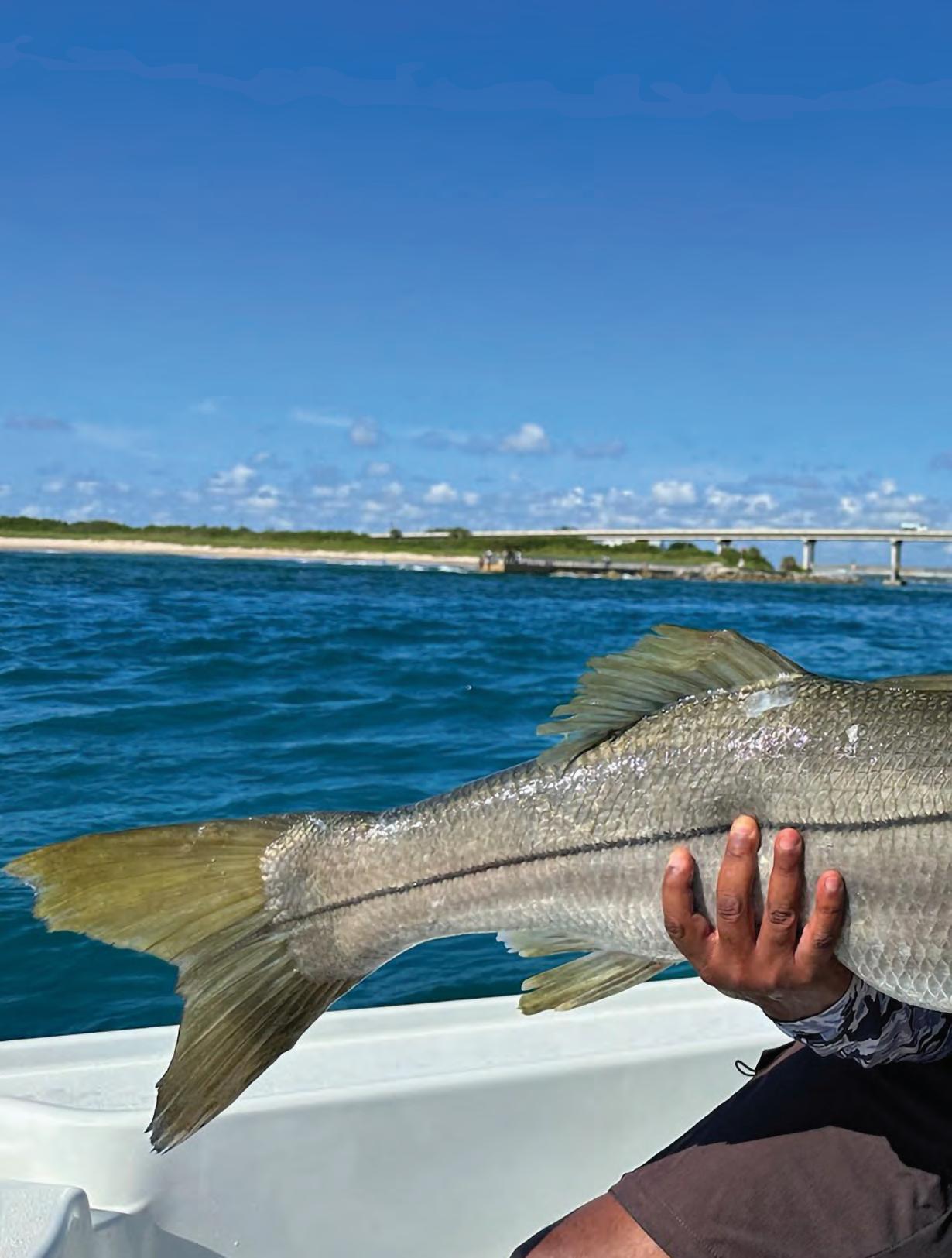
Capt. Adam White, of St. Lucie Flats Fishing on Florida’s Treasure Coast, said this time of year offers good snook and tarpon fishing in his area. Whether he’s fishing bridges at night or inshore structure during the day, there are a lot of snook to be caught around Fort Pierce and a lot of places to catch them.
“From the beach to the inlet, the bridges at night and the seawalls during the day, there’s a lot of different places to fish for
PHOTO CREDIT: WALT LAUREL
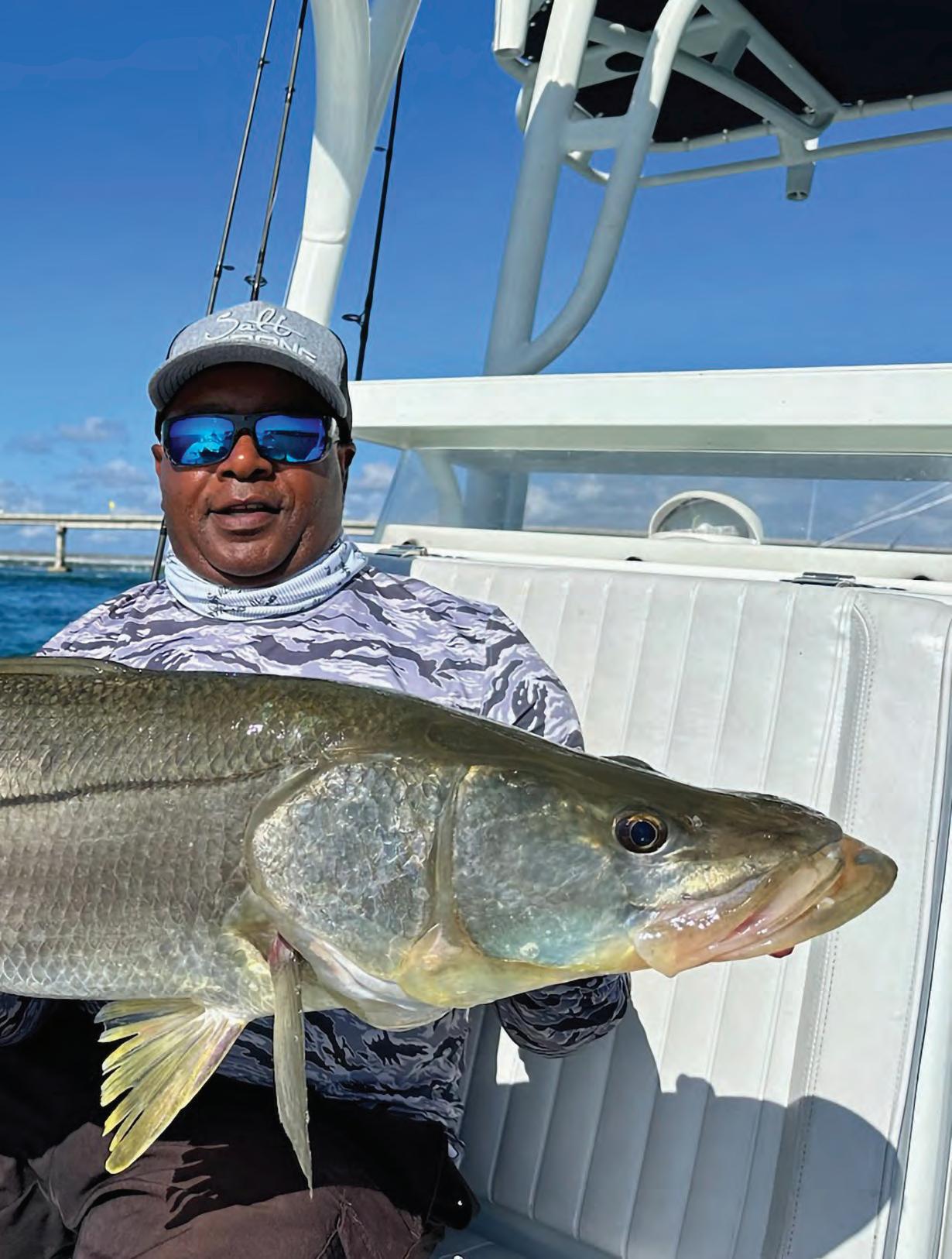
them,” he said. “You’ll only get four or five bites per spot, and if you don’t get a bite in 10 minutes or so, leave. I don’t let grass grow under my feet.”
Run-and-gun tactics make for fun fishing, with spurts of activity between quick boat rides. Capt. White said he can’t guarantee a one-fish-perperson snook limit because the 28- to 32-inch slot is a small window, but he said anglers can expect consistent action from under-slot snook or a shot at a big over-slot fish.

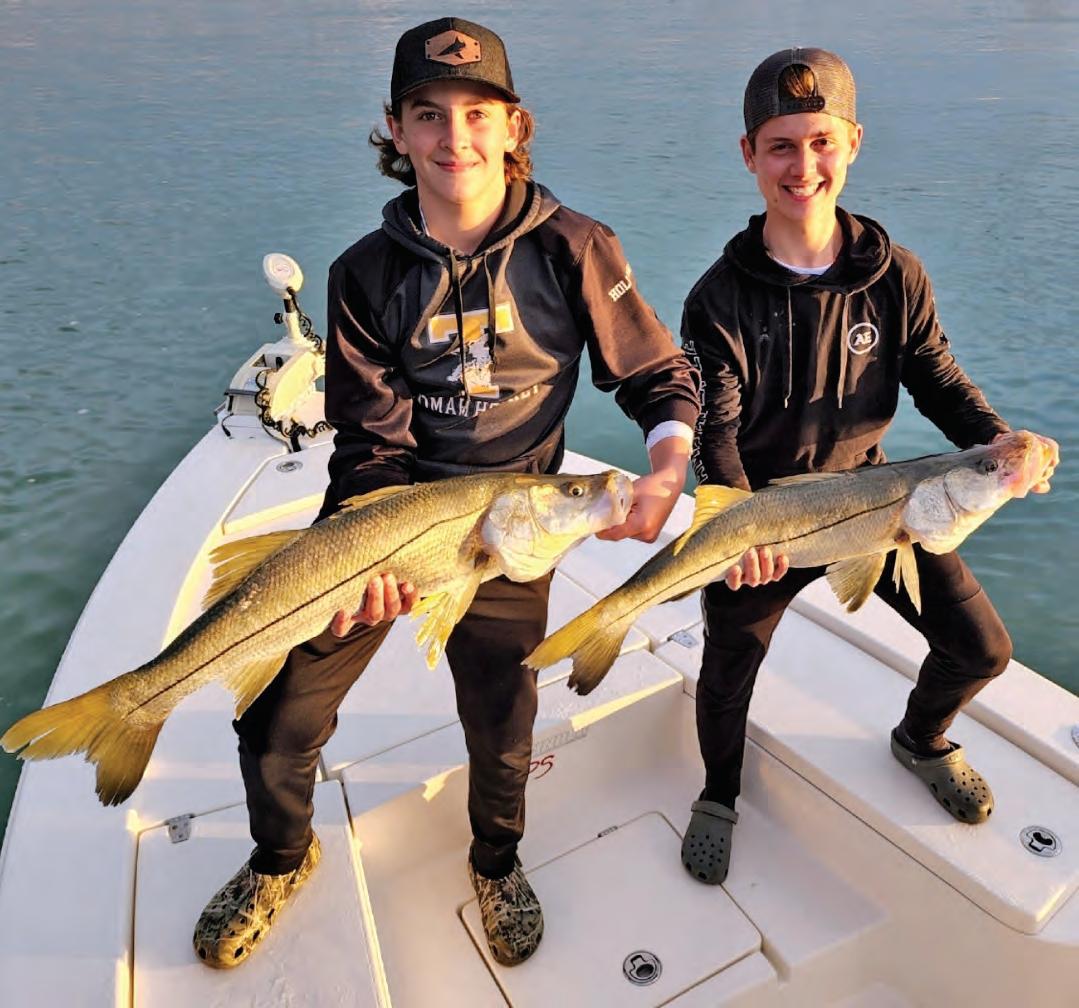
Inshore, White likes light (up to 15-pound) spinning rigs for pitching live baits to current-swept structure, such as mangrove islands, spoil bars and docks. Snook are strong, and a decent one will take you for a ride on light tackle.
The best shot at a big snook is out in the inlet, where White will anchor up and drop baits to the bottom in hopes of just three or four bites over the course of a trip. The payoff
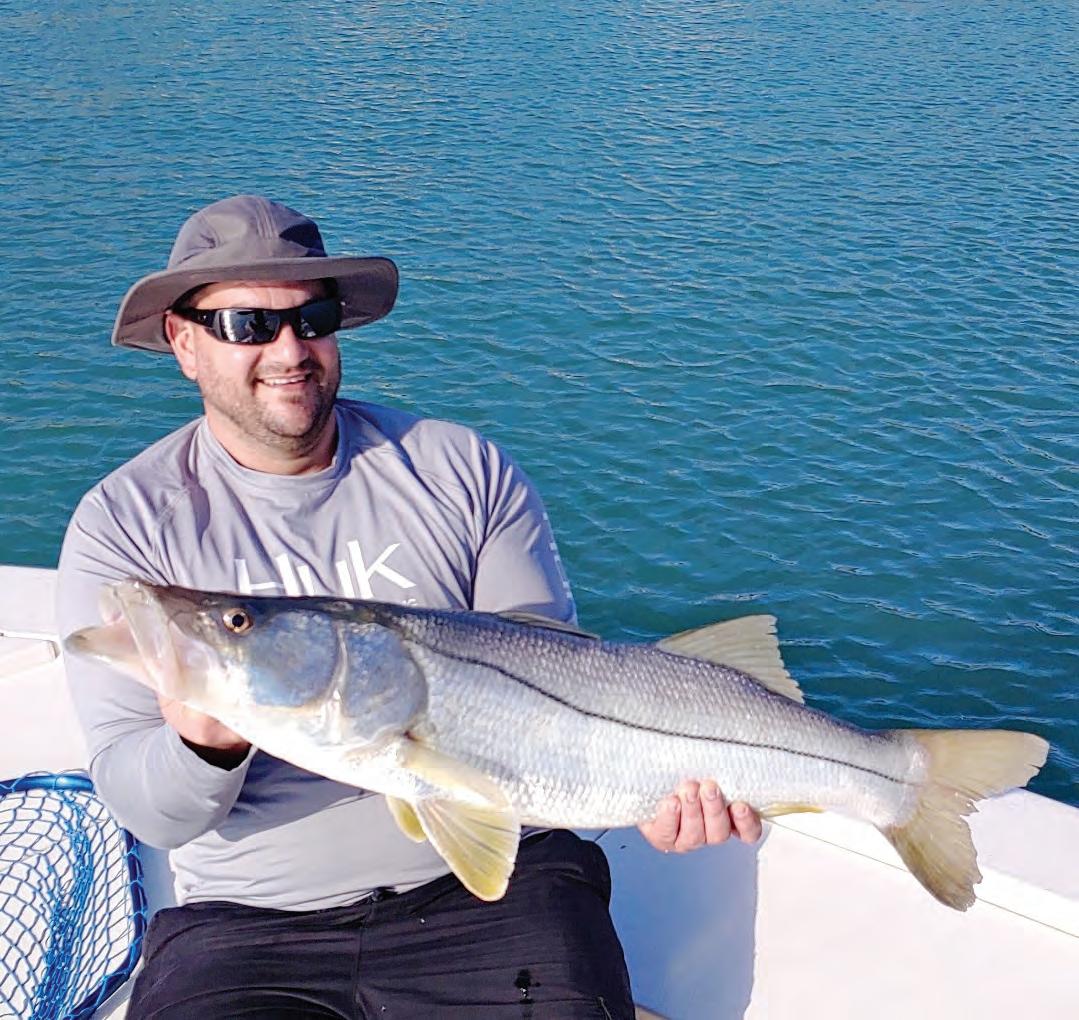
16 SEPTEMBER 2023 THE ANGLER VIDEO MAGAZINE
might be a snook in the 35- to 38inch range with an outside shot at a 40-incher. These fish might weigh 15 to 20-plus pounds.
Live bait is the best bet, and snook will eat whatever is available at the time. Live mullet or croakers are White’s preferred baits, and he doesn’t shy away from using bigger 5- to 8-inch baits, which even small snook will hammer.
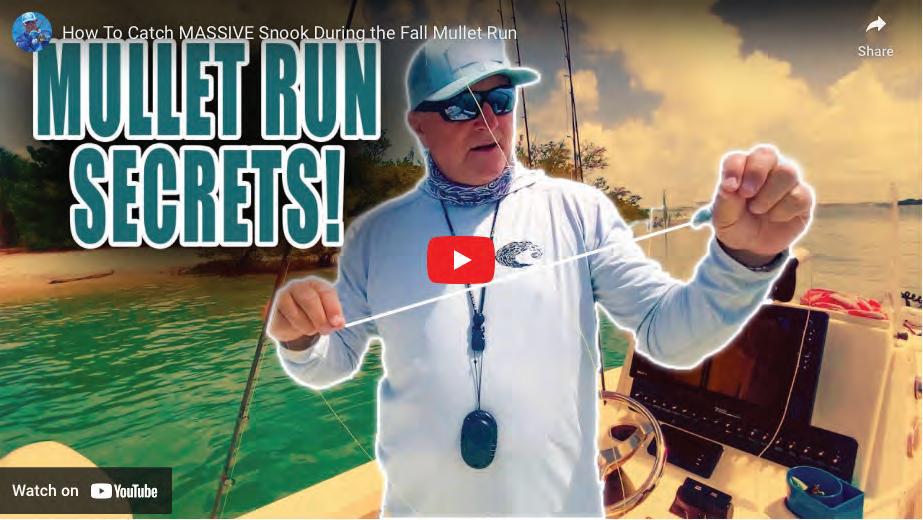
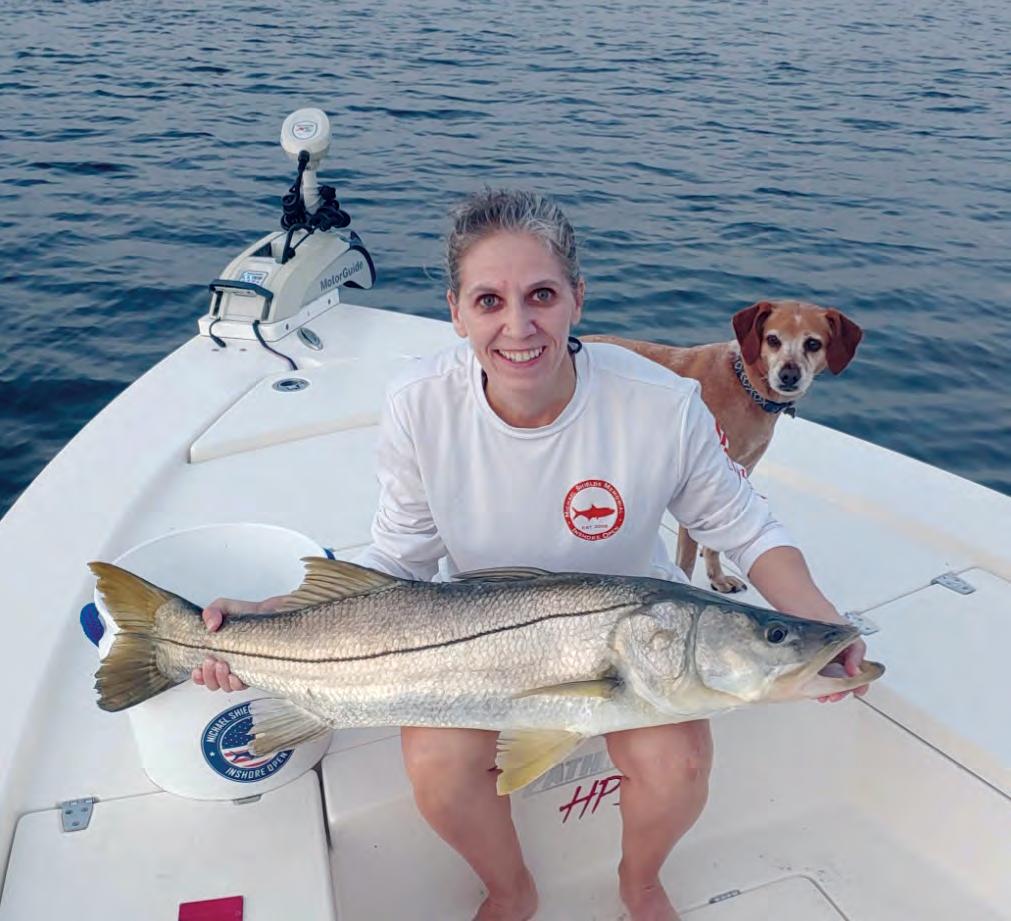
Anglers who prefer artificials will find good action at night at the bridges. White suggested lippedplugs like the Bomber Windcheater, which has a good mullet-like profile in the 4 ½-inch size. Another great lure is the locally made soft-plastic Thumper Shrimp. Rig one on a jig head with enough weight to get it
down and work it slowly across the bottom.
As for the annual mullet run, when predators hound millions of mullet pushing south to spawning grounds off south Florida, White said he likes the front end of the migration. Off St. Lucie County, the fishing is best around the second week of September, when mullet begin trickling into the fishery. Once the migration is full-blown, there are so many baitfish in the water that it’s hard to get fish to notice your bait.
Contact Capt. Adam White through his website at stlucieflatsfishing.com, or call (609) 820-6257.
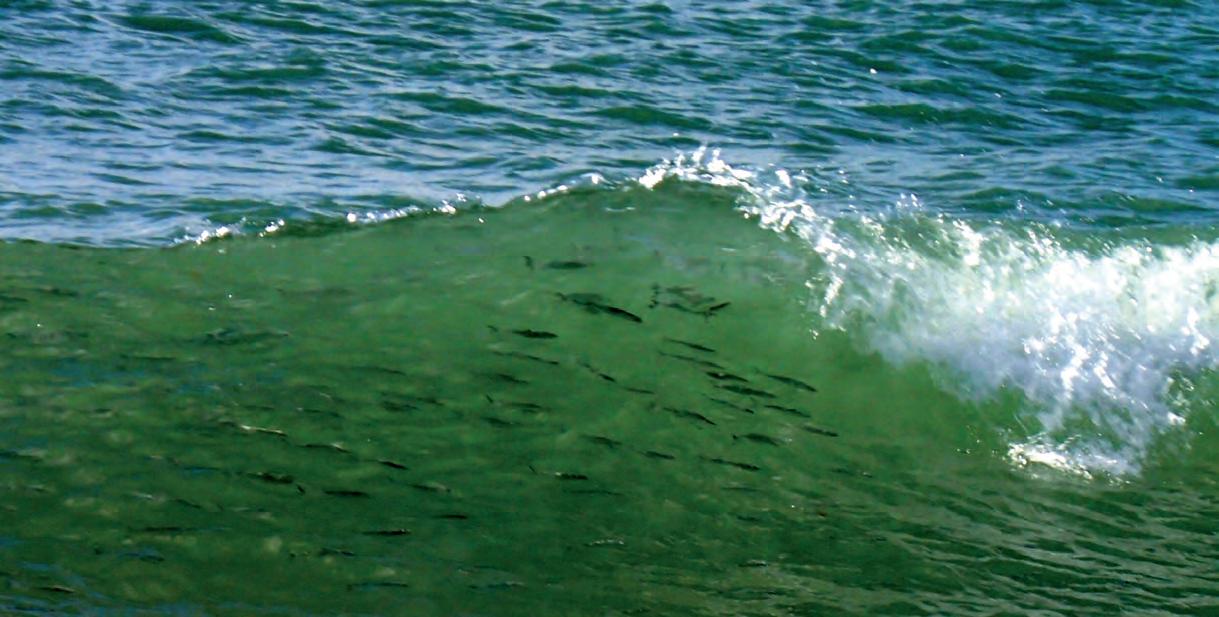

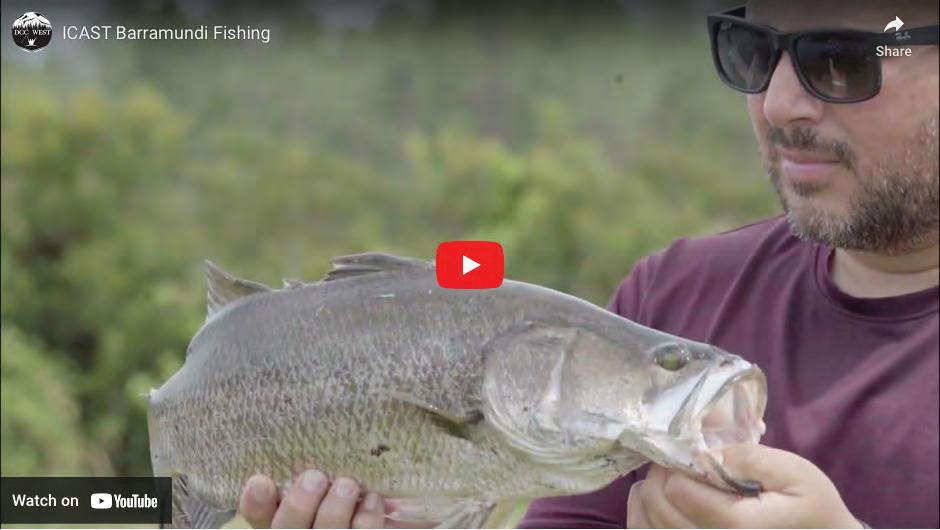

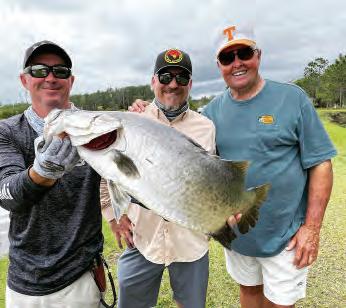
FLORIDA BARRAMUNDI FISHING! OSCEOLAOUTBACK.COM | 407.908.3216 The only location in North America to catch Barramundi! Capt. Byron Hennecy bkhennecy@gmail.com 800 Hennecy Lane St Cloud, FL • 34773 Osceola Outback is a full time guide service offering you some of Florida's most unique fishing adventures.
RELEASING FISH THE RIGHT WAY

With so many species closed to harvest, releasing fish properly is more important than ever as we need these fish to thrive and spawn. There are some very simple rules to follow that will help ensure the vitality of a released fish.
First and foremost, keep them wet. A fish out of water is going through a major amount of stress. This is especially true after a long fight. It’s like running a race and then having to hold your breath. The best-case scenario is to use a dehooker that allows you to release the fish without ever taking it out of the water. Long pliers or dehookers that slide down the line and allow you to flip the fish off work great. If you do need to lift the fish, work fast and get the fish back in the water before it stops dripping water. When taking pictures, keep the fish in the water until you are completely ready. Also consider a more creative angle other than the traditional hero
pose so the fish stays in the water.
The way you handle the fish out of water makes a huge difference. Keeping them wet also preserves the vital slime on the fish which is crucial. Make sure your hands are wet. Avoid putting fish on dry surfaces. Rough dry surfaces like boat decks and rocks remove much of the vital slime from a fish. Never use a dry towel to handle a fish; that can be the kiss of death. Using a rubber net versus a nylon net also greatly reduces the amount of slime removed.
Bottom fishing in deep water creates another issue, barotrauma, or the expansion of gas inside a fish as it ascends from the deep. You know the bulging stomach and eyes. Descending devices are easy ways to ensure fish suffering barotrauma make it safely back to the bottom. They are required by law now in many areas for many species. While venting tools work well, most people do not use them properly and often don’t have the proper tool.
By Will Schmidt

Ice picks are not proper devices.
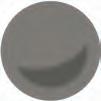
Lip clamps and inverted hook style release techniques are simple and work great. Here’s a bonus: if you visit Return ‘Em Right (https:// returnemright.org), you can get the equipment you need for free. It’s a $100 value.
Have a rod rigged and ready with your descending device so you get the fish back in the water and down as quickly as possible. I’ve also found that the using a lighter weight than provided by Return ‘Em Right is much easier to retrieve and works on smaller snapper and such. That said, with many grouper out of season, make sure you keep a heavier weight with you for when you get a big one.
Helping fish survive being caught today is the key to having fish to catch tomorrow.
Schmidt is a seasoned tournament angler who has been writing about fishing from more than two decades.
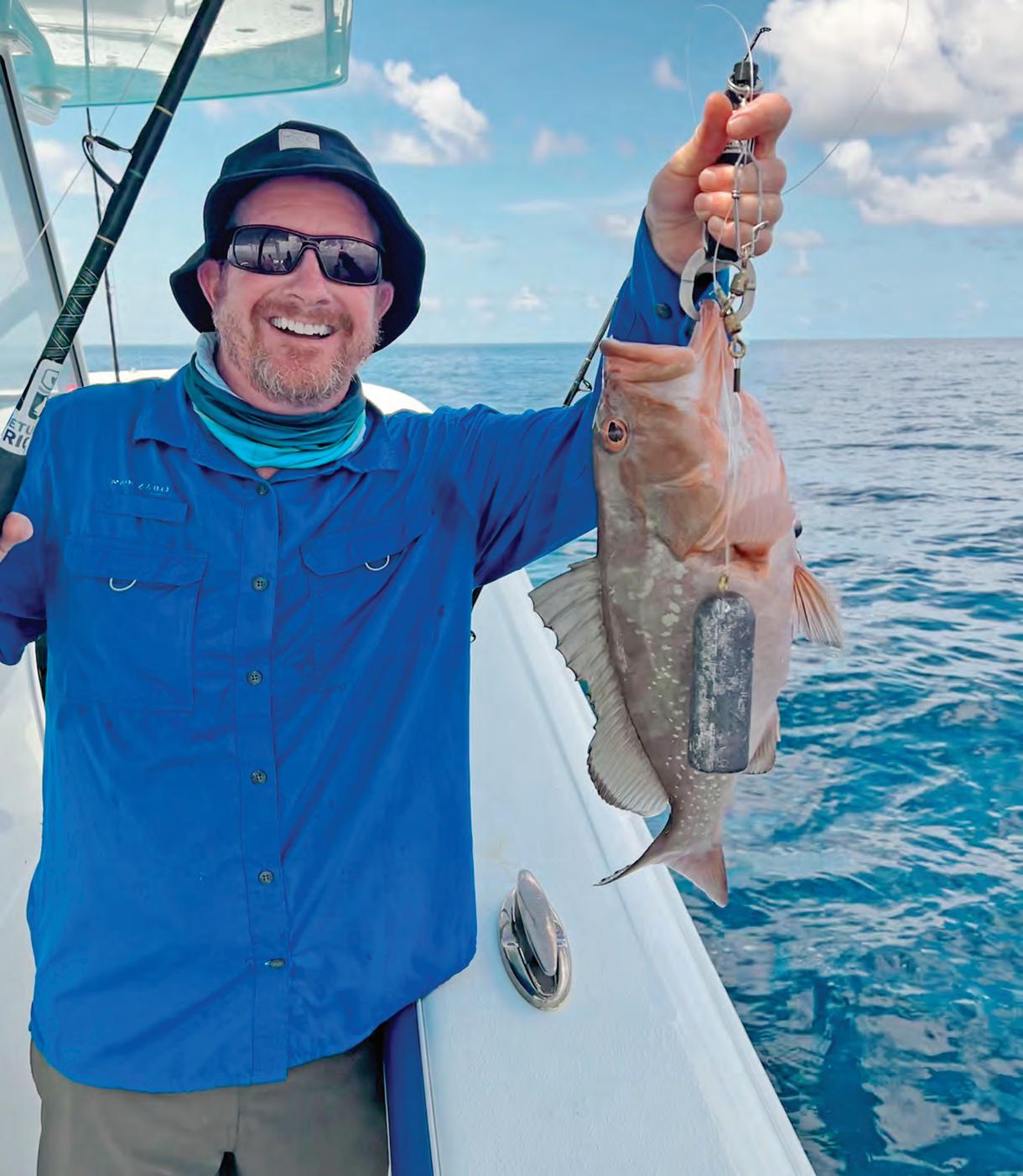 Will
Will
WATCH VIDEO
THEY KNOW FALL IS COMING
Fish know fall is coming because of the reduction of daylight minutes in a day. The shorter days make a lot of species start a whole new pattern of activities. For example, the grouper complex will start the process of moving into traditional spawning areas. That migration mirrors the cigar minnows, sardines and squid. I’ve always said this and will say it again: Find the bait, find the fish!
The cigs and sardines form large schools that attract a number of predators including kings and sailfish on the surface, and the big snappers and grouper will be on them as well. The shortened daylight hours become obvious during the middle of this month, when it triggers the “feed” to fatten up for winter and the spawn. Go to the traditional areas you’ve found bait in the past, and that’s a great place to start fishing.
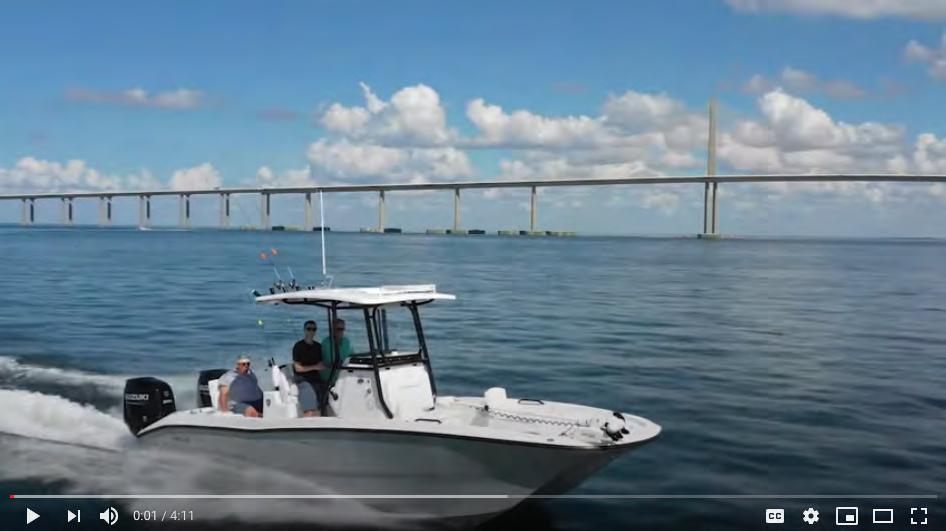
Another thing I’ve said in the past is: don’t go to a Chinese restaurant and order a pizza, meaning don’t drop baits that are foreign to fish that are working a school of cigs and sardines. Always have a couple boxes of frozen cigs and/or sardines just in case you can’t find the bait. At least you’ll have bait that “matches the hatch” of what they normally eat.
I try to stay on the sabiki catching baits while everyone else on the boat is fishing with grass grunts, sailors choice, cigs/sardines, etc. If you get on a big knot of cigs or sardines, it might be helpful to have two people on the sabiki filling the livewell. The best bait of all is whatever is there. Just put it right back down.
This is also the time of year to find squid inshore, mixed in with cigs and sardines. If you have a live squid for bait, its life expectancy is under 10 seconds once it touches the bottom on a jig. It’s an instant bite, just like several other baits mentioned above.

The only problem I have with the live or frozen minnows is everything on the bottom will give them a whack, and you wind up catching a lot more snapper and smaller bass than if you use a larger live bait. We almost always have live pinfish from the marina that eliminate most of the trash bites. If you have a larger pinfish, grass grunt or sailor’s choice on the jig, nothing but larger bass, grouper, jacks and big snapper can put it in their mouth.
I like to specifically target grouper by putting the larger live baits down on the jig that eliminate the undesirable bites. Of course, this is a very attractive bait to the sharks, also. Every now and then you have to pay the “tax man” in a grey suit, but that’s just the chance I take. Check out some of the rigging and fishing videos on the website or on youtube to see what I’m talking about.
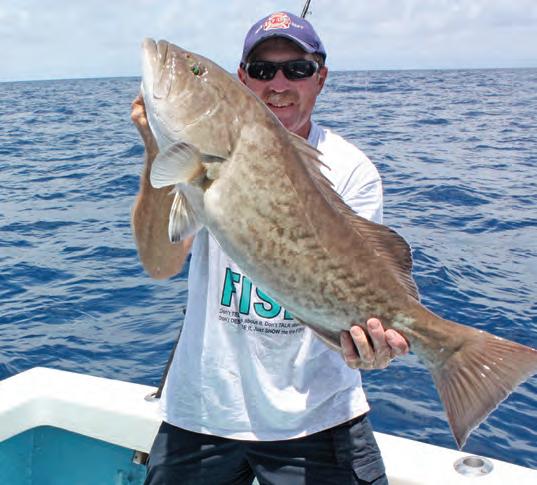
See more from Tim Barefoot at Barefootcatsandtackle.com.


20 SEPTEMBER 2023 THE ANGLER VIDEO MAGAZINE
WATCH VIDEO
Tim Barefoot
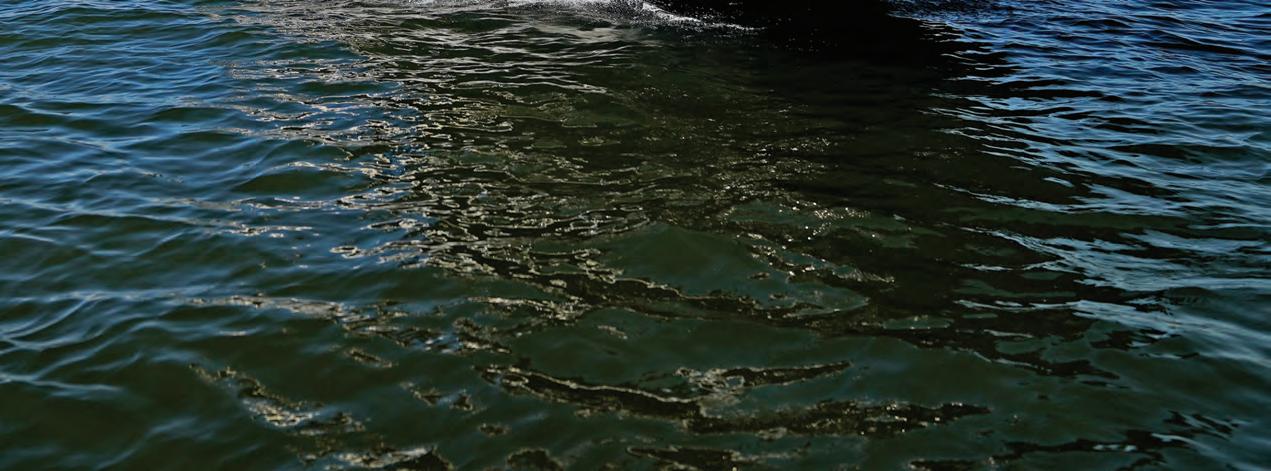

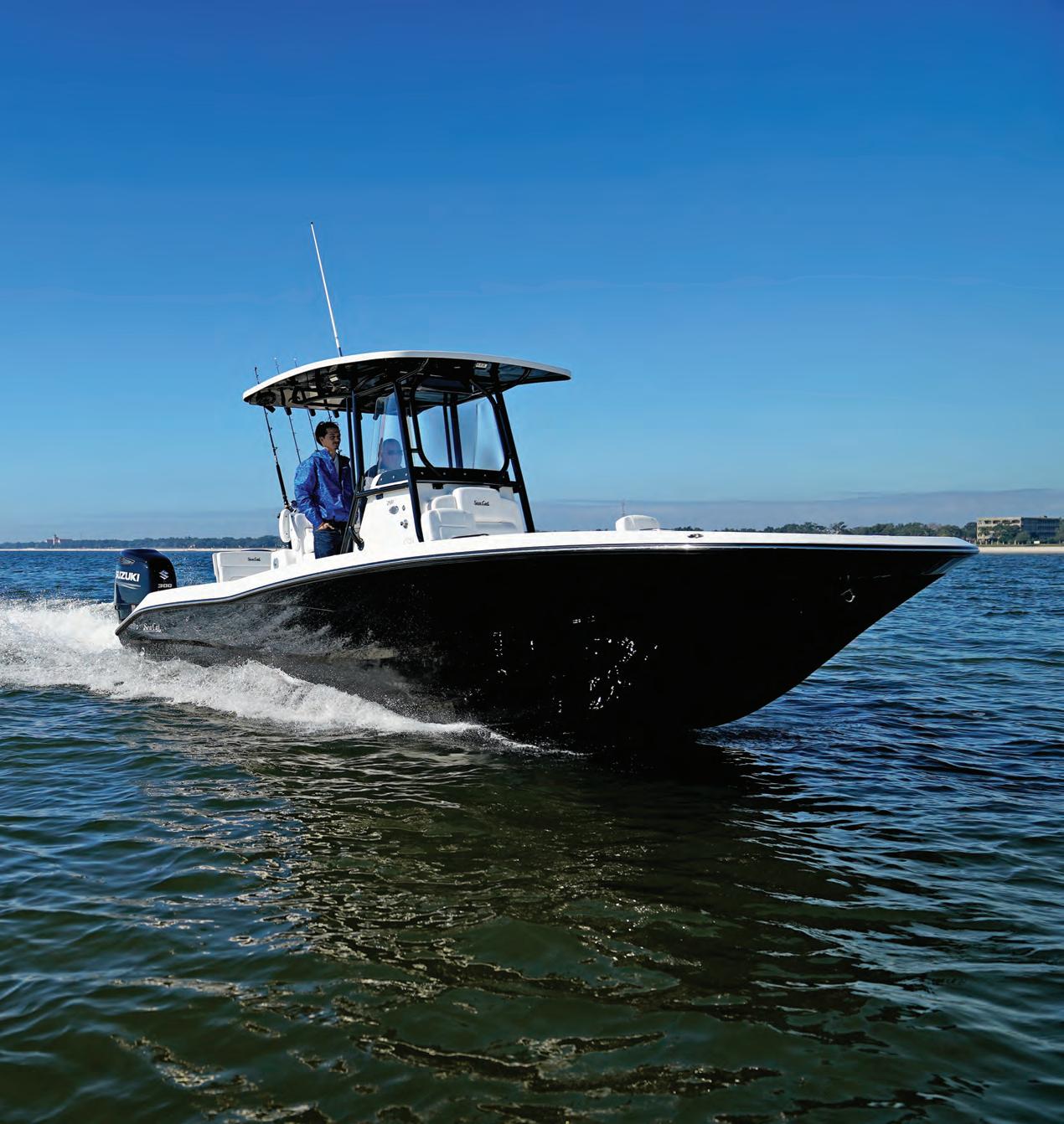

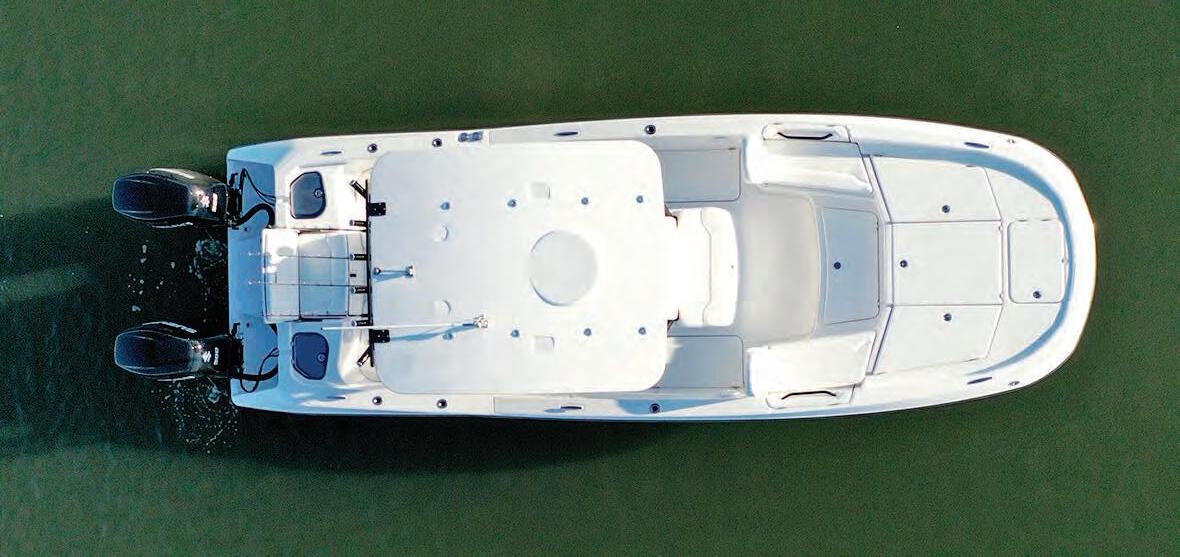
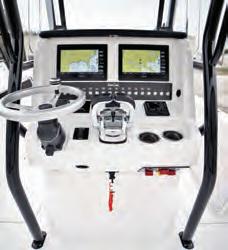

SeaCatBoats.com . 228-206-4042 Designed To Last Warranted for Life

Forty-nine reservoirs stretch across the Tennessee Valley like a string of pearls. And for those who love to fish, those lakes are just as valuable. Whether it’s bass, crappie, walleye, or catfish, whether for sport, food, or just fun, you can find world-class lake fishing only hours away from any spot in the Tennessee Valley. From more than 11,000 miles of shoreline or while floating on more than 700,000 acres of water, residents and visitors will quickly learn why this area is considered one of the best fishing destinations in the U.S. and, some would say, the world.
Find Your Own Fishing Hole
Fishing from the shore can be restful and rewarding—and anyone can do it. All you need is a little intel about how to find a spot where the fish might be biting. Here are a few tips for successful shore fishing from the Tennessee Wildlife Resources Agency:
• Fish are often swimming near the shore in the spring and fall. If you’re fishing from the shore in the heat of summer, do it in the evening or early morning—or even after dark.
• Fish near-unique features such as docks, logs, trees, rocks, or rocky areas; aquatic vegetation; or places where creeks enter the water.
• When fishing in moving water, look at the surface for boils and breaks—this means there is some underwater structure blocking the current, which could be the perfect hiding place for fish.
• Begin fishing (casting) close and parallel to the bank, then work your way outward (fan casting) toward deeper water.
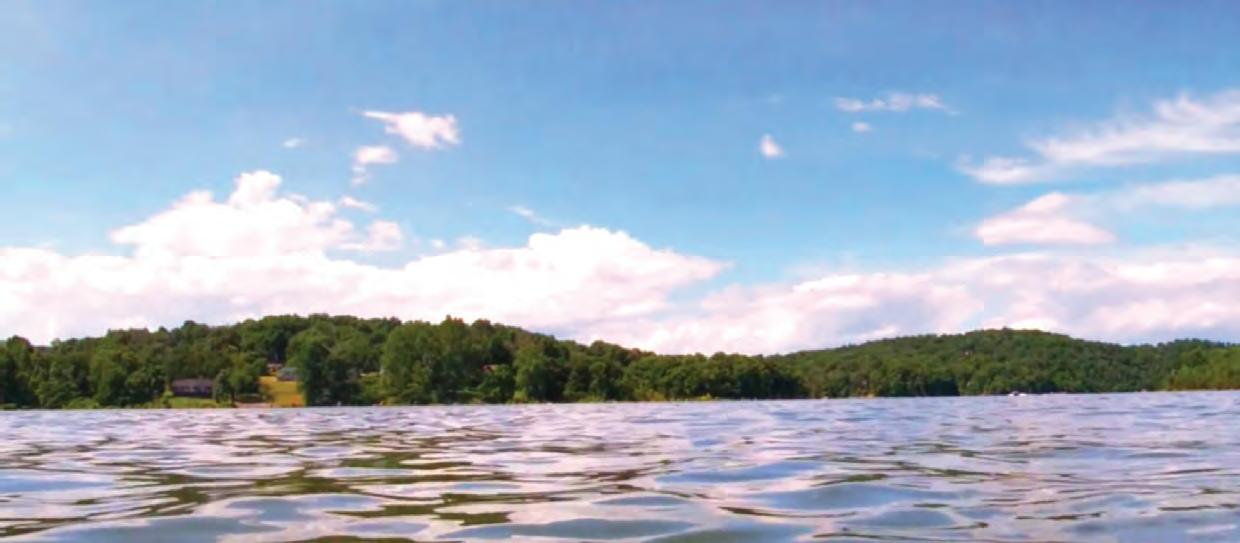
• If you don’t get any bites, try switching baits. If this doesn’t work, move to another hole.

• Wear polarized sunglasses so you’ll be able to see fish as well as submerged objects more clearly. (Your eyes will also be protected from the tackle.)
If you love outdoor sports—boating, hunting, fishing—and the natural world, or if you just like to observe wildlife, build birdhouses, maintain a bird feeder or are just curious about the critters in your backyard, the Tennessee Wildlife Resources Agency is here to help enrich your outdoor experience. Visit us at www.tn.gov/twra/



POPPER SEASON IS ON FIRE IN EAST TENNESSEE
By Capt. Bill Stranahan

This is a hard time of year for most Southern trout anglers. Water temperatures are warm all over, and most of our trout fishing has slowed way down or is just plain over for a bit.
Here in East Tennessee, we are currently bringing 5- and 6-weight fly rods and drift fishing topwater poppers for spotted and smallmouth bass on several local rivers. We are catching some nice fish, and we’re also catching very good numbers, all on top.
It’s like hopper fishing, just on the warm-water side of things. The bass are happy and should be looking up for the remainder of the summer through October, depending on water flows and weather.
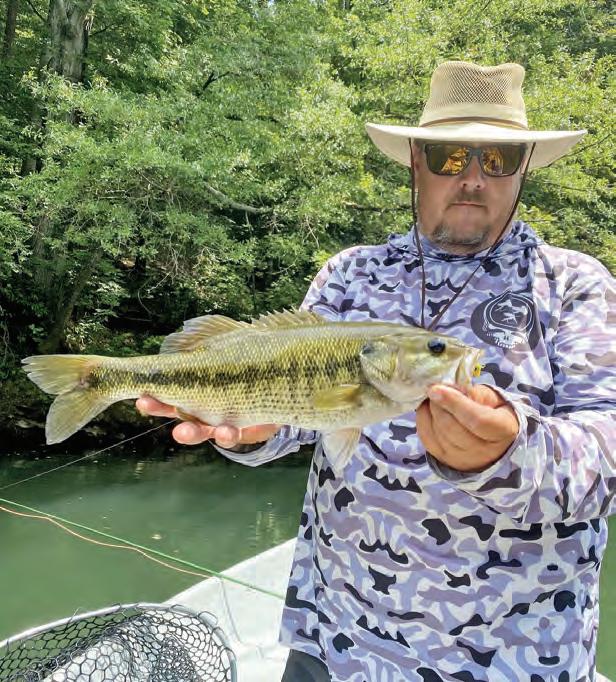

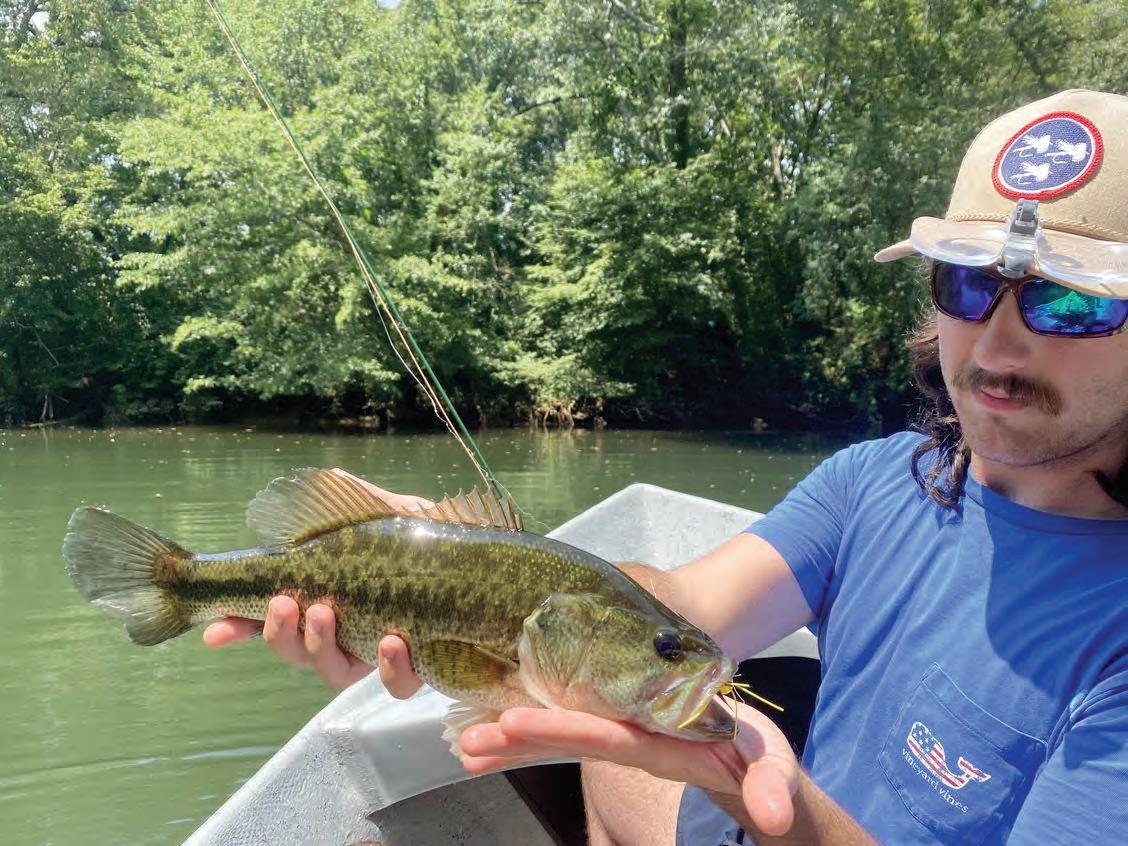
It’s a nice change of pace for a bit, with many fish being in the 15- to 16-inch range and averaging a pound and a half or two, with shots at larger fish on any given drift. Giant pumpkinseed bream will also come up and hammer a popper on occasion.
If you’re getting into the bassy side of things, I recommend 2x leaders, 5- and 6-weight rods and your favorite color poppers. The occasional pop and twitch is just a way to say hello to let them know it’s there and see who comes up.
If you want to catch some hard-fighting fish and have a fun day on the water, give us a call before it’s over.

Contact Hiawassee River Guides at (423) 208-8602. See their website at http://hiwasseeriverguides.blogspot.com/.
WATCH VIDEO
RODS
FISHING CUSTOM RODS JUST GOT EASIER.
FISHING CUSTOM RODS JUST GOT EASIER.
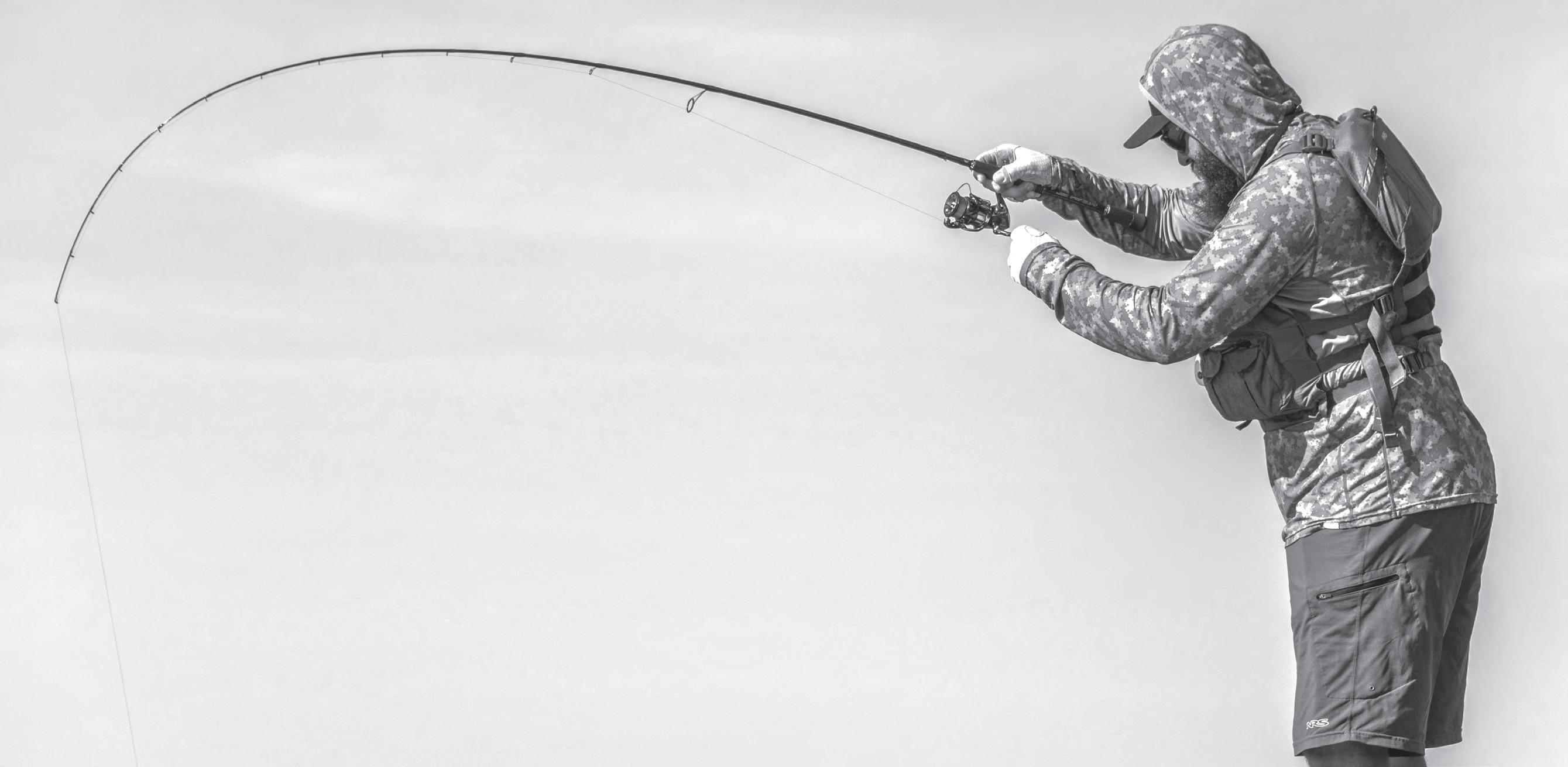


Any angler that spends enough time on the water becomes hyper-sensitive to the performance they get from their gear. The new Find a Rod Builder section at BatsonEnterprises.com has made it easier than ever to get rods made specifically to fish YOUR way.

Batson has combined the industry’s best line up of rod blanks and components with direct access to our network of professional rod builders that make awesome rods happen. Click this ad to visit us online and see why the best fishing rods start here.

performance
has
BatsonEnterprises.com
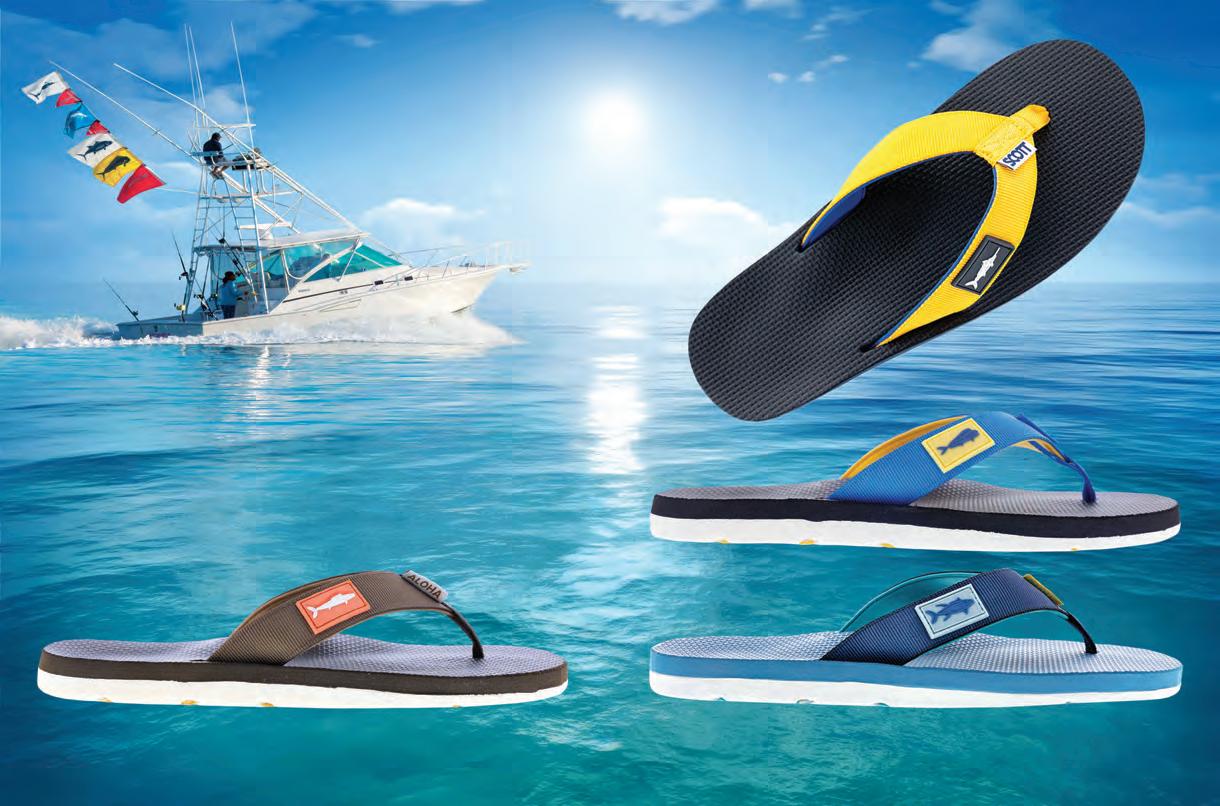


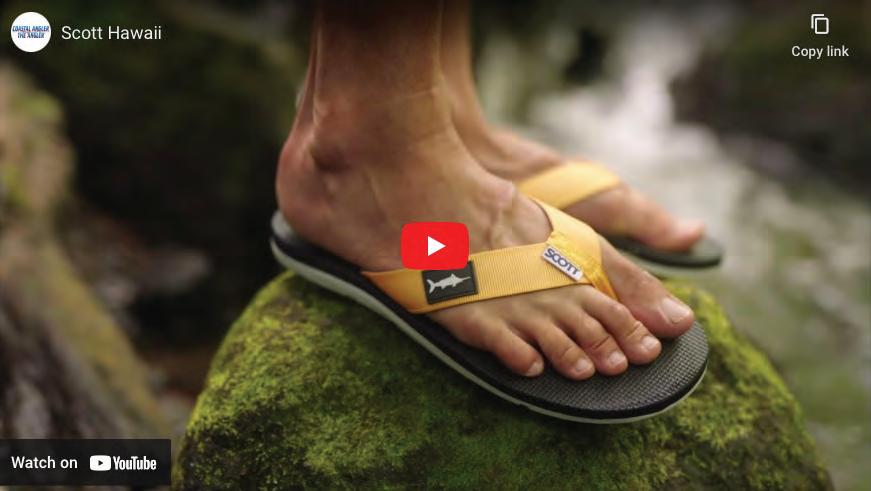
26 SEPTEMBER 2023 THE ANGLER VIDEO MAGAZINE Fishflagstellthestory! Catch all 4 Hanap‘a “slippahs” from Scott Hawaii scotthawaii.com FAMILY RUN IN HAWAII FOR 90 YEARS
Hanapa‘a - Mahi
-
Hanapa‘a
Ono
Hanapa‘a - Ahi
Hanapa‘a - Marlin
Fish flags inspired by Sun Dot Marine Flags.
@fishflags
By Capt. Quinlyn Haddon


Summer’s End CAN BE THE BEST!
With summer tourism starting to slow down, this month can be one of the better times to visit the Florida Keys. As demand for accommodations drop, so do prices around the Keys. Wait times are less, and charters have more availability for last-minute travelers.
Provided that the hurricanes are playing nice, September offers a nice opportunity to hit the end of mahi season, or to enjoy a reef that’s less crowded than normal.
All the snapper fishes are fired up this time of year, but the most notable are the mangrove snapper. Mangrove snapper are spawning and there are epic catching days to be had before and after the full moon. Knocker rigs or jig heads will snipe them off the bottom with just about any bait. Small live pinfish and ballyhoo are very effective. When using dead ballyhoo, the whole bait can be dropped, or cut in half. Break the beak off and hook through the head side, or cut the tail off ever so slightly, and hook them through that cut, making sure the hook loops around the spine.
Swordfishing is another great option
right now. There are still mahi to be found on your way to and from the swordgrounds, but not so many that you feel obligated to stop on every cluster of fired-up diving birds. Fishing for swordfish can be a large undertaking for time, tackle and fuel, with a high skunk-out risk rate involved, so it’s always nice to have the chance at some other species along the way. Unlike in the middle of summer, when the ocean is alive with feasting mahi, you can actually make it out there without stopping every mile along the way.
Snowy grouper is closed, but deep dropping offshore is still a viable way to fill the cooler with rosies, tilefish, yellowedge grouper and barrelfish.
As we transition into the autumn fishing season, many factors are at play for predicting our fishery this month. Call a local captain to find out the latest report, and come visit the Keys during the cheapest travel month of the year!
Capt. Quinlyn Haddon fishes with Sweet E’Nuf Charters out of Marathon, Florida Keys. Contact her at (504) 920-6342, check out her website Quinlynhaddon.com and her social @captainquinlyn.
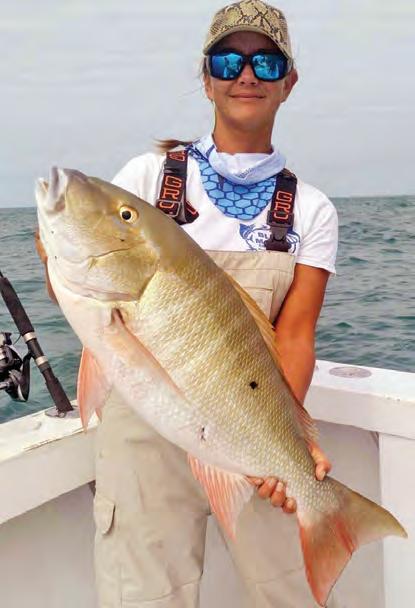

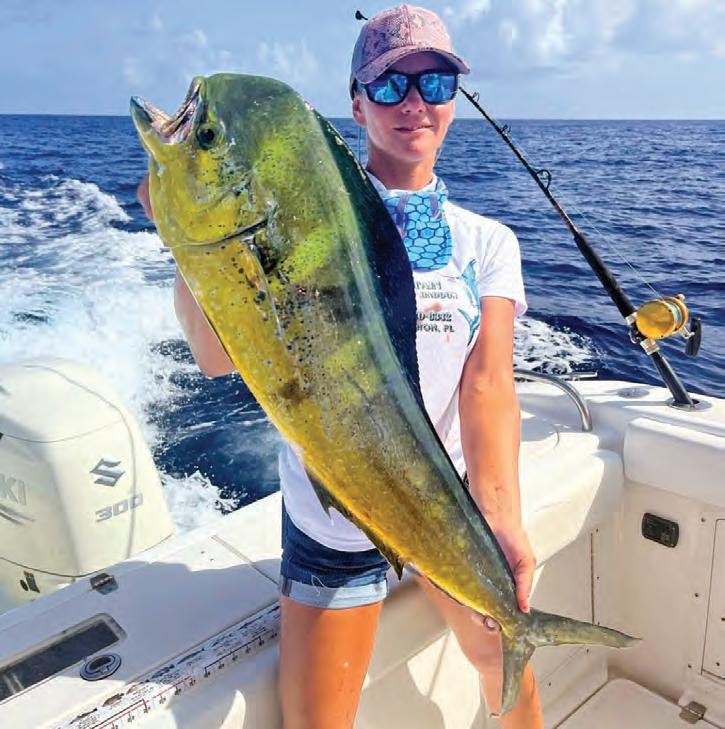
THE ANGLER VIDEO MAGAZINE SEPTEMBER 2023 27
WATCH VIDEO
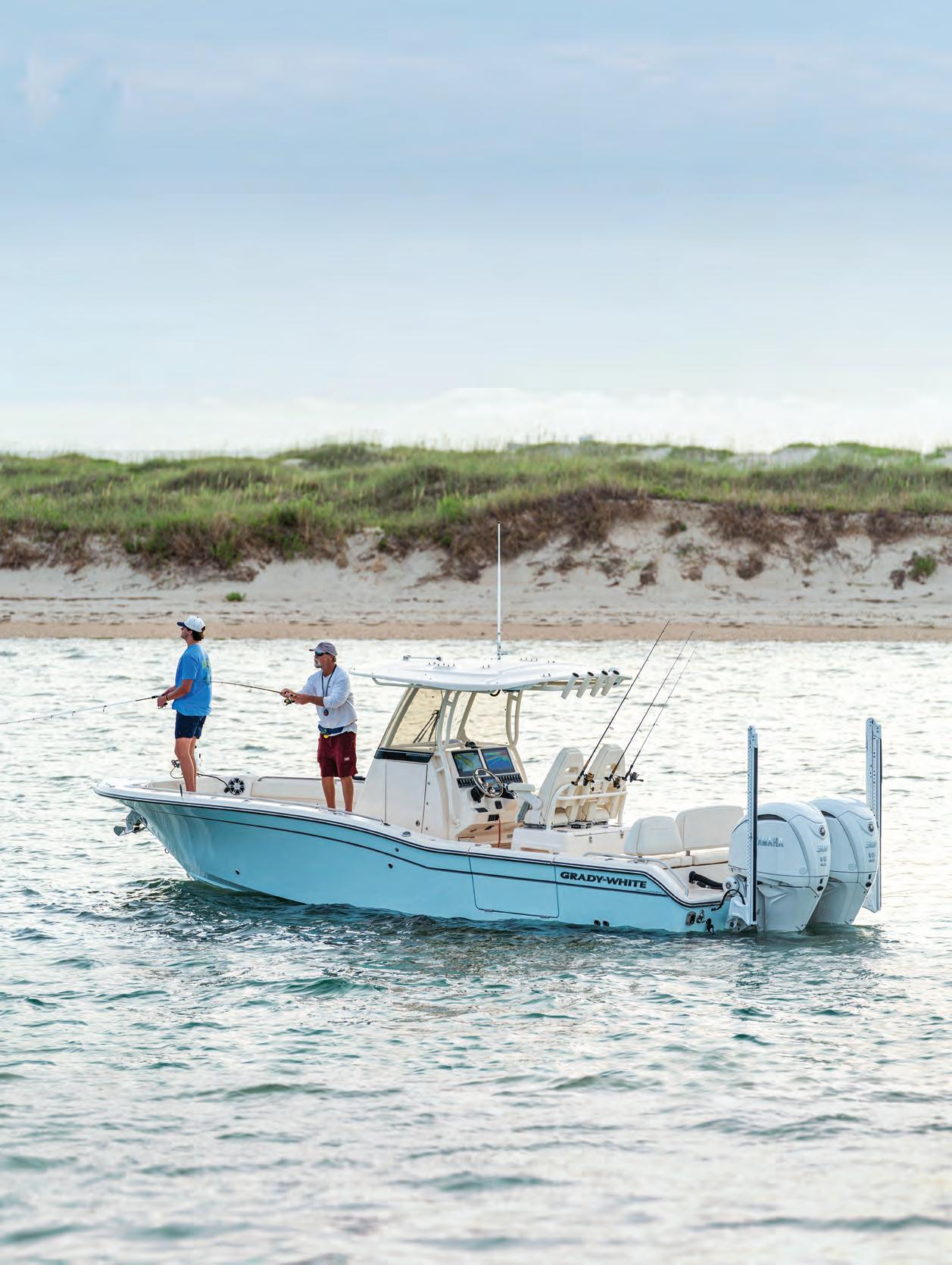




















gradywhite.com Uniquely Grady-White.
POWERED BY
281 CE Possibilities.
GRADY-WHITE BOATS INTRODUCES INNOVATIVE AND LUXURIOUS 281 COASTAL EXPLORER!
The newest edition to Grady-White Boats’ impressive Coastal Explorer Series, the 281 CE, made its debut at the Miami Boat Show. There, avid anglers got to check out the latest Grady-White innovations that make this boat primed for inshore and offshore fishing. Grady-White hit it out of the park with this unique new boat.
The innovation starts in the cockpit with a portside sport deck that is an electromechanically folding platform with an in-gunnel stowable ladder. An ingenious design at the transom adds to this boat’s versatility, allowing the area to transform from comfortable forward-facing seating, to casting platform, or lounge. Whether you’re riding to the fishing grounds, casting for trout, or spending the day at the sandbar, you have the right setup for the day’s activity. At the bow you’ve got incredible flexibility with a large casting platform that converts to a spacious sun pad with backrests that can be a table too. A lockable console with electric flush marine head and a 10-gallon holding tank adds to the amenities.
Loaded for fishing function, you’ve got two livewells, lots of rod storage, and abundant fish boxes–over 400 quarts! The deluxe lean bar also includes a rigging station, cutting board, and recessed freshwater shower.
From the plush helm seats with flip-up bolsters and footrest, to the full height scratch resistant acrylic windshield integrated into the
T-top, Grady thought of everything. You also get the choice of a single Yamaha 450 or dual 300 engine configuration, both with integrated digital electric steering. Other options include Helm Master EX® full maneuverability with autopilot, trolling motor pre-rigging with a swivel mounting bracket with quick release, a head stabilizer, 36V battery system and a 20-amp battery charger (trolling motor not included) and an outrigger kit.
All built on Grady’s superior SeaV2® hull

with capable wave cutting technology and continuously variable vee design means you get the ultimate ride wherever the fish are biting. But don’t be fooled by its fishability, this boat is equally luxurious, making it as comfortable for long rides to the fishing grounds, as it is for relaxing days at the sandbar with family and friends.
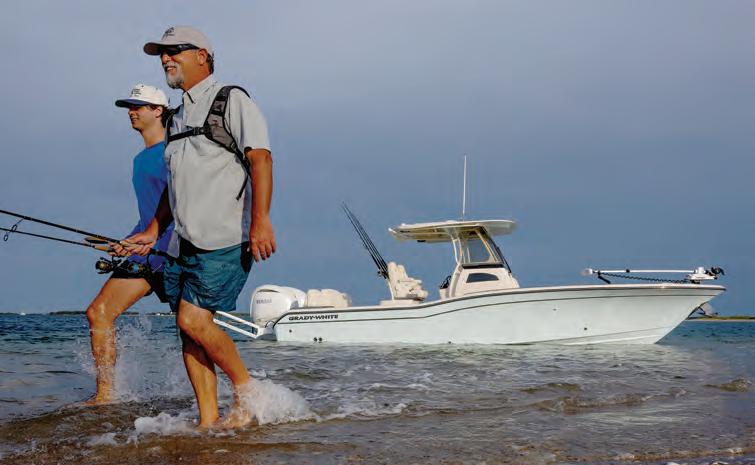
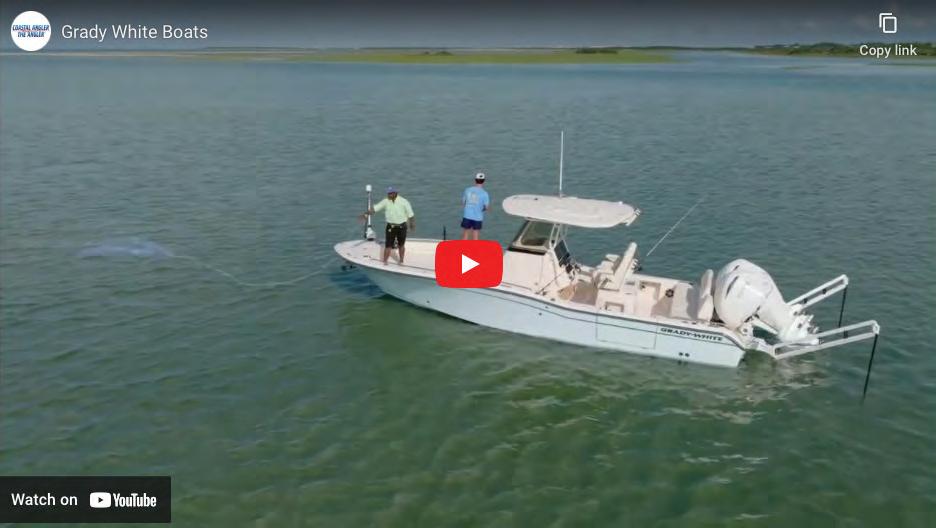
LEARN MORE AT gradywhite.com
By Tim Cutting
THE FALL CLASSIC… YOUR FISHING WORLD SERIES

For sheer numbers of fish, autumn is the time to be on the water. Just as we know what time our favorite greasy spoon stops serving breakfast, our finned adversaries know forage will become scarce with the coming of winter.
Creeks, rivers, lakes, sounds, bays and beachfronts will be littered with migrating baitfish, creating that huge last-chance buffet. The days become shorter, the water cools, and the Fall Classic begins.
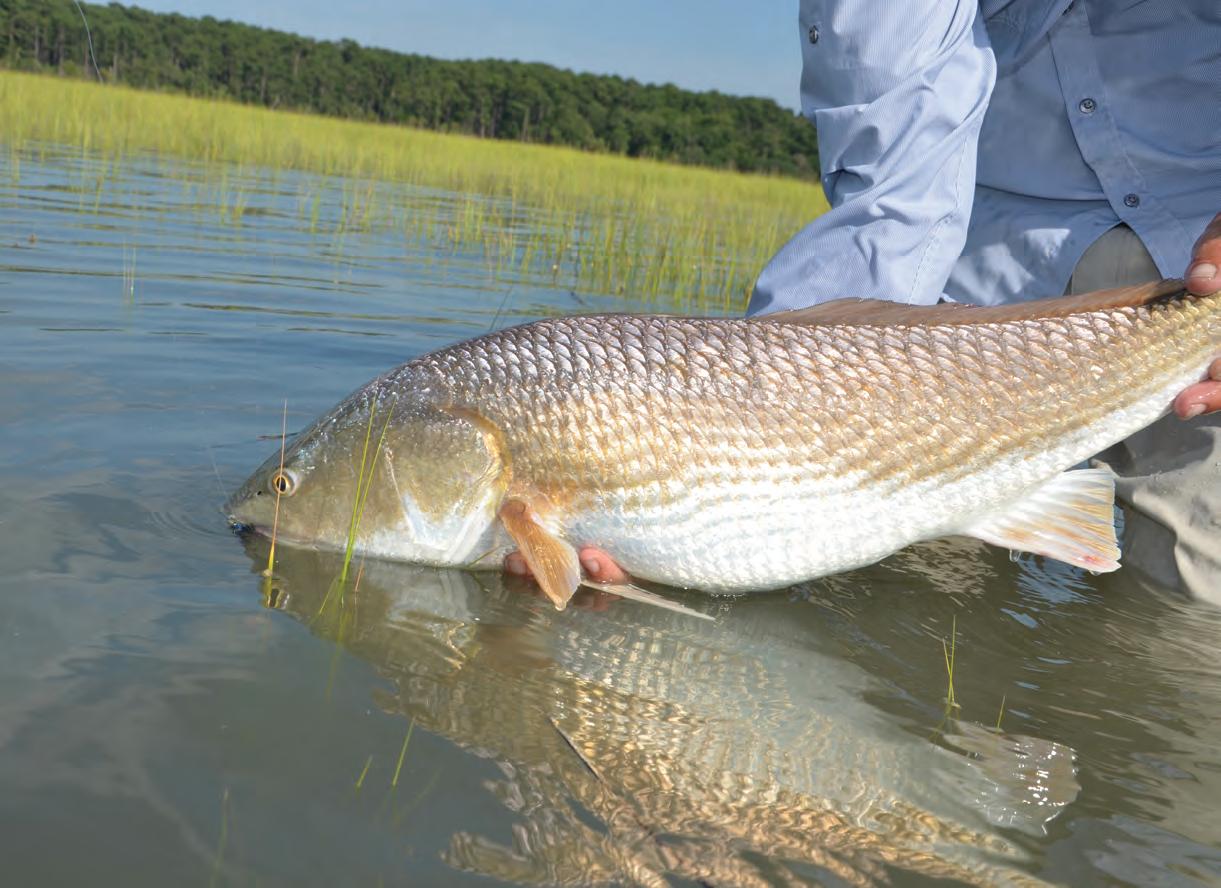
Just as big league ball clubs scramble for a veteran fireballer or slugger to get them to that final game, anglers arm their livewells and tackle boxes with a variety of baits to have that “epic day.” While conditions often set up well, they can also throw us that big breaking ball. Now is not the time to throw in the towel. There are a few things that go a long way toward getting on that great fall bite.
For live baiters and lure fisherman alike, there may not be a more important time to match the hatch. While shiners or shrimp may
be what usually gets the job done, fish now are keying on specific forage. When a certain species of bait becomes thick in the fall, fish become selective. Downsizing or upsizing your offering at different depths and water clarity will be necessary. While lure fishermen may have more of a selection in size and color, those using live or cut baits do have choices. Using adjustable floats or altering trolling depths can be the key for live baiters in the fall.
One of the main obstacles or advantages during the fall can be water color and depth. Forage fish are in survival mode, and will vary their highways across the water column. Baitfish will use stained water and structure to avoid predators. Throw in moving water, rain runoff, lake levels, tide and wind, finding these hard-feeding fish can become a task.

When the Fall Classic arrives, my starting rotation consists of three common artificial baits in various sizes. I rely on topwater plugs, jigs and lipped divers, especially the suspending models. For topwater baits, I like
a Rapala Skitterwalk. I’ll also use the Storm Chug Bug. More often than not, the topwater is my search bait. Once I catch a fish, I’ll use my other baits to work them over.
The choice on jigs can be fairly crazy, but I generally like those made with black nickel. I go as light as I can stand. A jig allows me to work the bottom in all depths and use a softplastic of almost any size. Depending on the forage, I may use as small as a 2-inch grub up to a 6-inch swimbait. A 5-inch soft-plastic jerkbait, like a Zoom Fluke, can be deadly all over the country when pegged to a ¼-ounce jig head. Finally, I rely heavily on the Suspending Pro Long A from Bomber. I typically give the jerkbait a couple of sharp twitches and pause, varying the length of the pause until I get bit.
With these three baits, I can work just about any structure at any depth. While it seems like a lot of info to process, usually it’s just a few tweaks on depth and bait size that will get the fish to eat. Once you dial them in, the fall truly can be Classic!
30 SEPTEMBER 2023 THE ANGLER VIDEO MAGAZINE
WATCH VIDEO
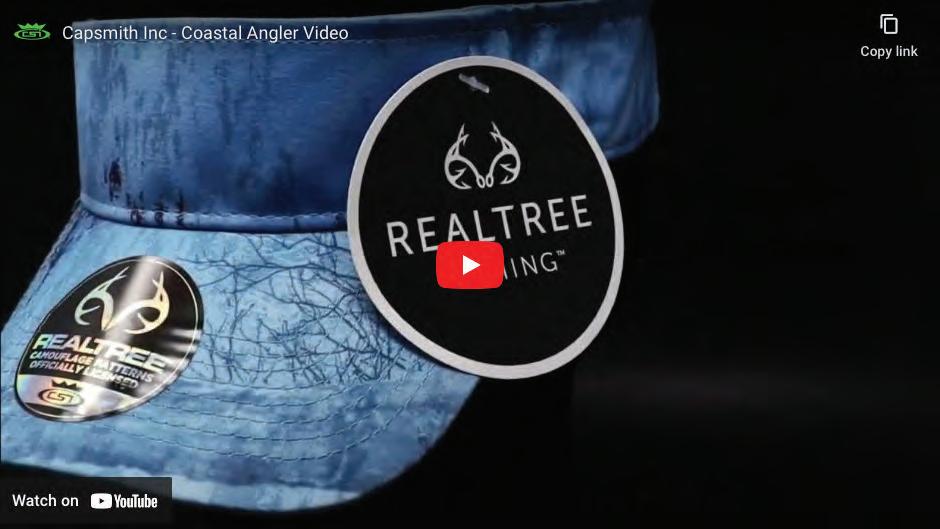

THE ANGLER VIDEO MAGAZINE SEPTEMBER 2023 31
Chinook are Running in the Pacific Northwest
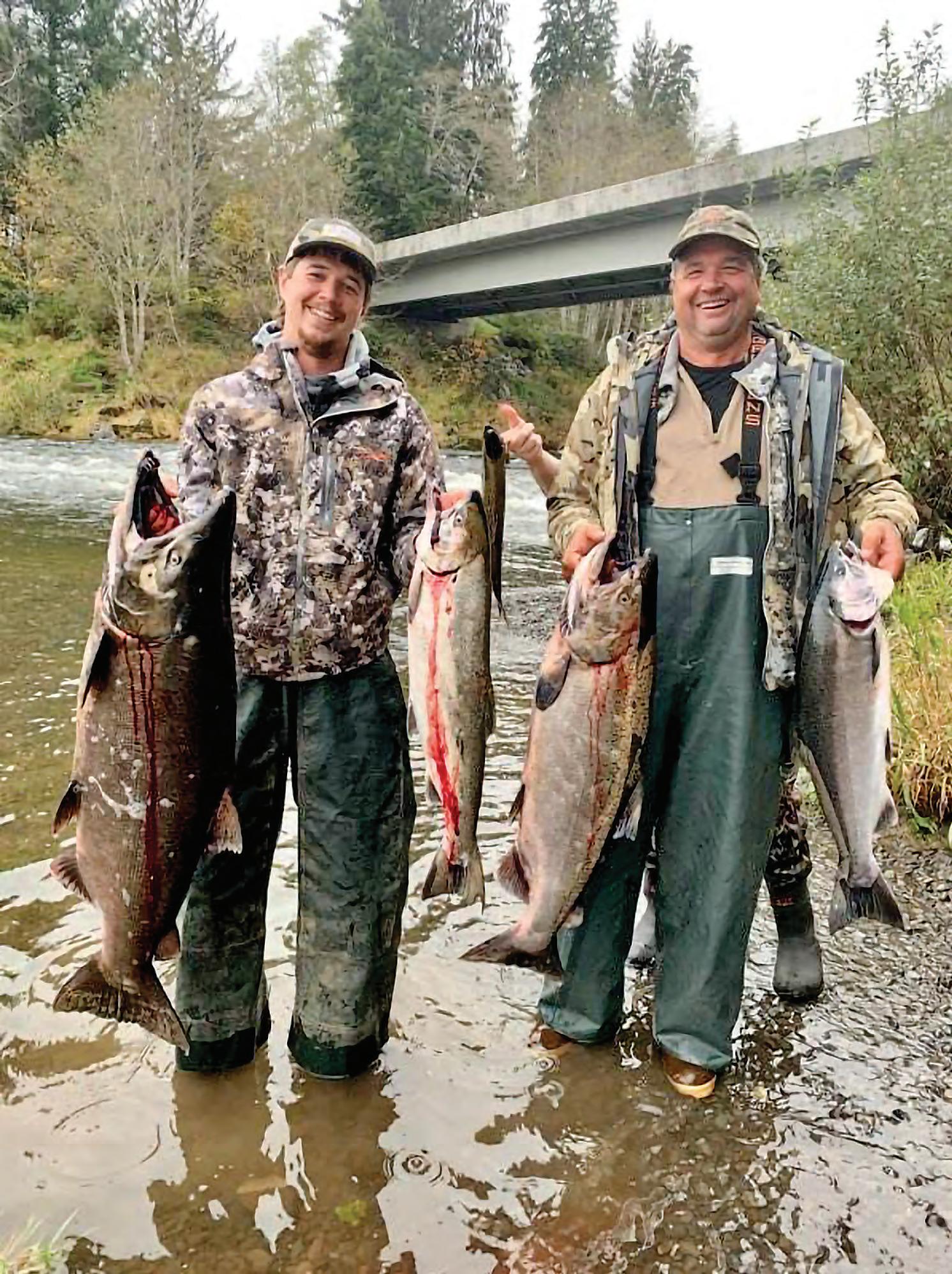 By Nick Carter
By Nick Carter

Right now, there’s a migration gearing up in the Pacific Northwest. Chinook salmon are staged to push up out of the cold Pacific and into the inlets and coastal rivers of Washington, Oregon and Northern California. Just like they do in the famed Alaskan runs, big king salmon are making a final return to the spawning grounds where they hatched to begin the next generation before they die.
With his father, Trevor Pelland, has fished these runs on the Hoh and Sol Duk rivers of Washington’s Olympic Peninsula since he was 8 or 9 years old. His dad was doing it before him. It’s an annual event with a time window that runs from August through December, depending on the particular drainage along this long stretch of coastline. The allure is large, hard fighting fish that are delicious seared, grilled or smoked. It’s a fishing tradition that existed since long before Europeans arrived on the continent.
Fall runs are famous in places like the Columbia, the rivers that feed Tillamook Bay and others. Chinook push into the main stems and larger tributaries of many coastal rivers and as far up them as the water will allow. Pelland said backtrolling plugs tempts these big
fish in the rivers. He’s caught 20-, 30- and 40-pound kings, which proves it works.
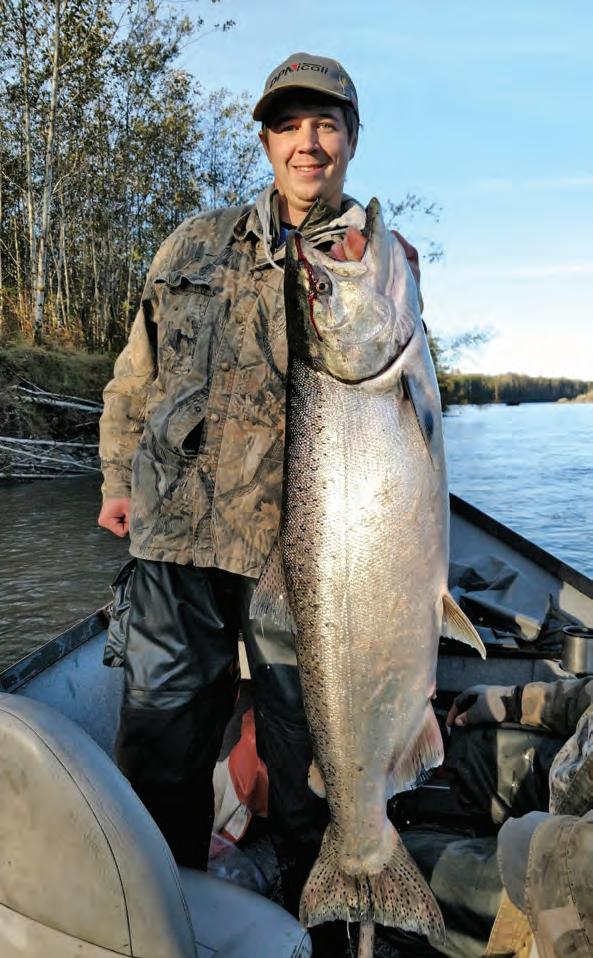
In Oregon, District Fish Biologist Robert Bradley has watched these runs dwindle in recent years. He said the fisheries are still worthwhile and draw anglers from all over, but that size and numbers of fish have been falling since at least 2015, due to ocean and environmental conditions. He said the projections for this fall are well below average.
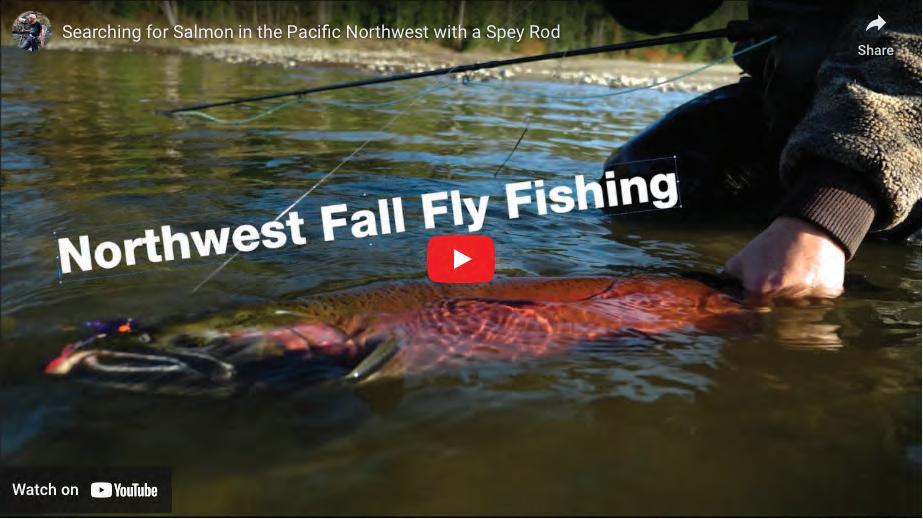
“The draw is the size of the fish,” he said. “Historically, you could see 60- and 70-pounders, but you could still reasonably expect to catch a 20- or 30-pound fish. An average is probably 10 to 15 pounds.”
The states have been hatching and releasing chinook salmon smolt for decades to coincide with the natural progression of fish moving out to sea. Bradley said chinook spend one to five years growing up in the Pacific off British Columbia and Alaska. The hatchery fish and wild fish return with similar survival rates, but not many of the stocked fish spawn with the wild group. He said most hatchery fish return to the hatchery.
The stocking does give anglers something else to fish for. Hatchery reared chinook have clipped adipose fins and don’t count toward a wild fish limit in most fisheries.
The seasons and regulations can be confusing and vary widely from place to place and year to year, but one wild chinook per person, per day is the norm. Check the regulations before you go or hire a guide who knows.
The runs ramp up when fall rains spur the fish to push upriver into the current, Bradley said. In some places, the coho salmon and chinook runs coincide. Make plans now, because runs on most rivers peak in mid-October.
For up-to-date information on Oregon’s salmon fisheries, go to myodfw.com.
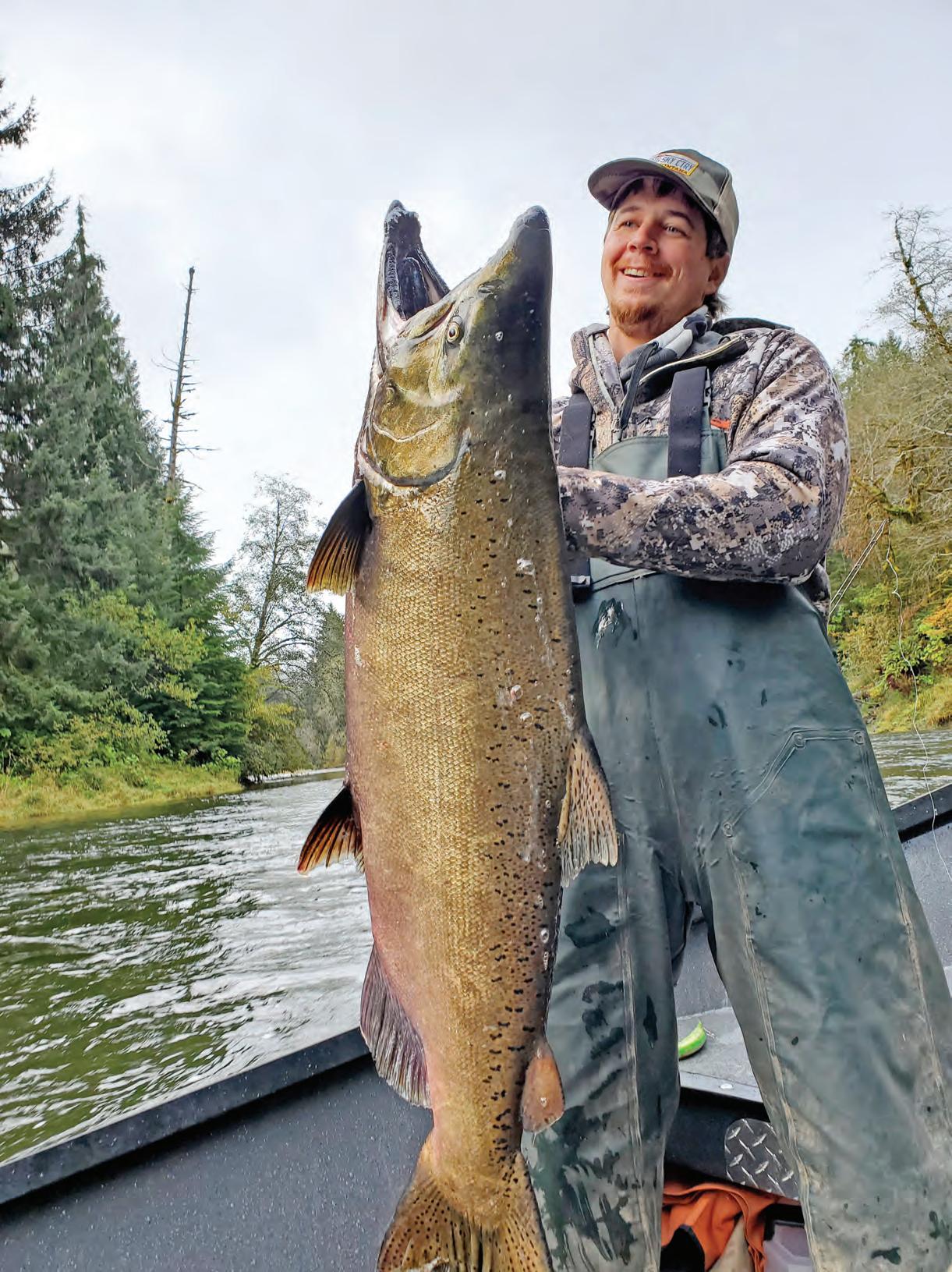



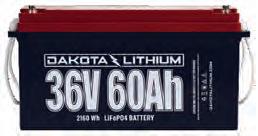
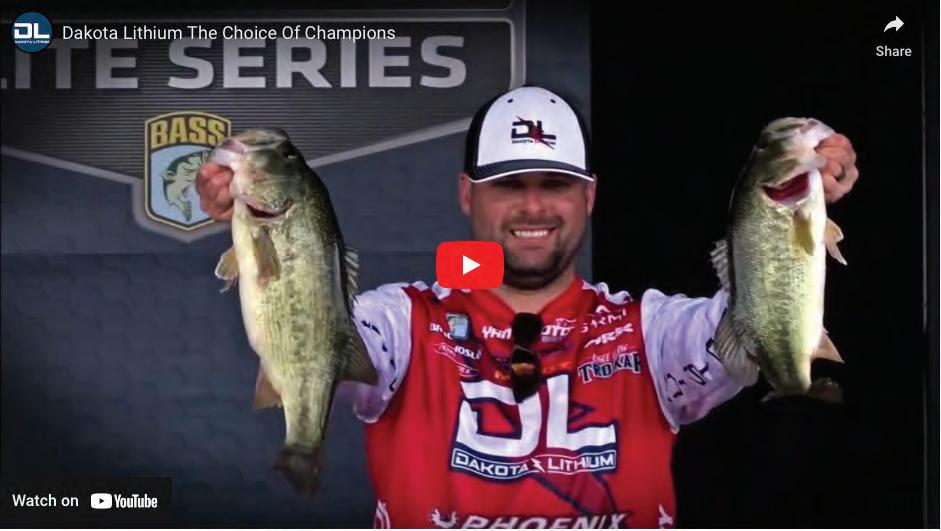
use code: coastalangler for 10% off your next purchase
trolling motor’s full potential unleash the official lithium battery of
your


ALASKA STATE RECORD OUTWEIGHS WORLD RECORD


Alaska’s new state record shortraker rockfish was caught in late July. On uncertified scales at a remote fishing lodge, it weighed 48 pounds, which would have crushed the existing IGFA world record by about 4 pounds. The angler, charter guide Keith DeGraff, however, chose to preserve the meat by bleeding the fish instead of waiting to get an official weight on certified scales.
Days later, when DeGraff finally got a certified weight in front of an Alaska Game and Fish representative, the fish weighed 42.4 pounds, which was good enough to set a new Alaska state record.
“It feels like the biggest accomplishment of my fishing career,” DeGraff said. “This species takes time and dedication to drop down to such huge depths, and I spent a whole lot of hours and reeled miles of line trying to break this record, and it finally came to fruition.”
DeGraff caught the fish from Prince William Sound on July 28 with his fiancée and some friends from a rented boat. DeGraff was fishing 1,000 feet deep with a conventional (non-electric) Avet 2-speed 30/2 reel, a custom-built Adventurous Custom rod built by Derwood Roberts, 3-pounds of weight, 80-pound braid and a circle hook baited with salmon and herring.
The previous Alaska state record shortraker rockfish weighed 39.1 pounds. It was caught by Henry Liebman in 2013. The IGFA all tackle world record weighed 44.1 pounds. It was caught in 2017 by Angelo Sciubba at Cross Sound, Alaska, but it’s not recognized in the Alaska Game and Fish list. For more information, see www.adfg.alaska.gov.
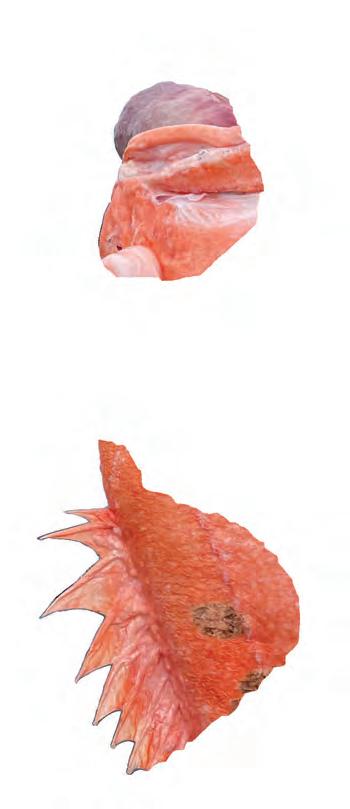

WATCH VIDEO
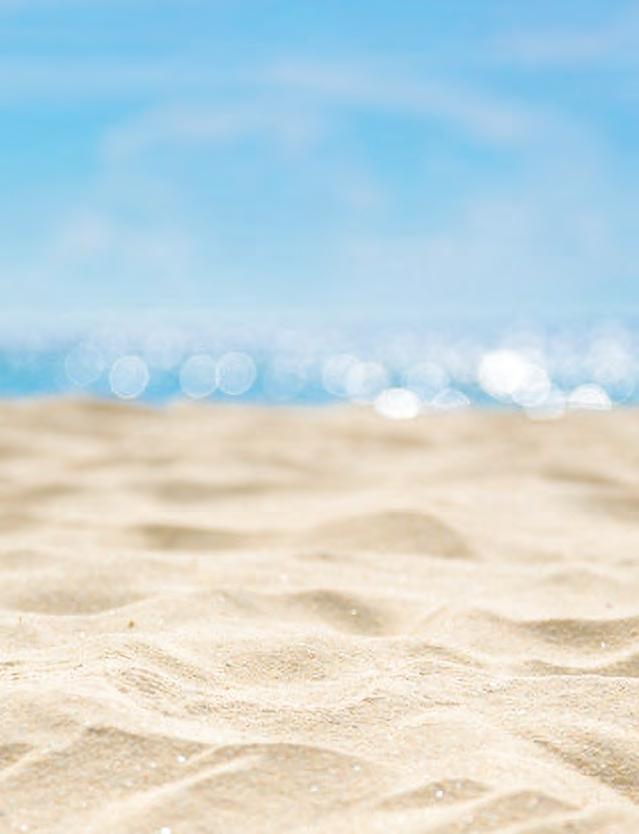



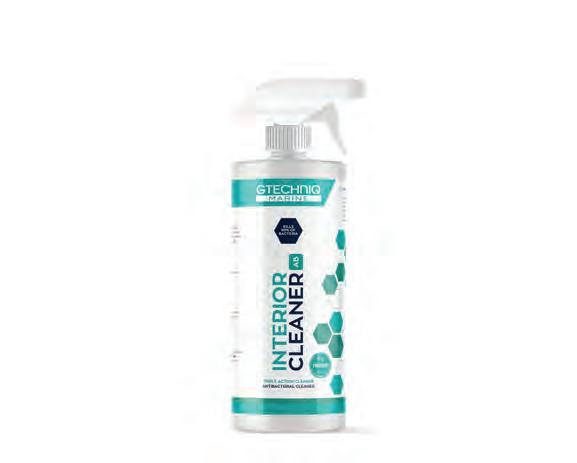
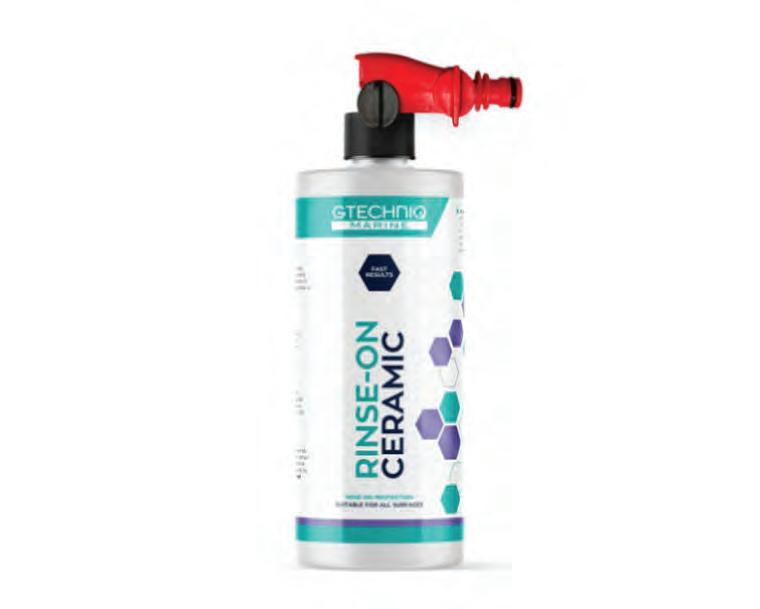

ENTER TO WIN Wash Kit Rinse-On Ceramic Kit Marine Black Camo Sun Protection Hoodie Interior Cleaner +++ PRIZE PACK! Total package value $175
September is supposed to be the beginning of fall, but the reality— at least in the South—is the month is just a continuation of summer. Bass can be pretty tricky, but there are ways to target fish in cooler, deeper water. Dragging a Carolina rig is one of my favorites.
DRAG A CAROLINA RIG TIPS FROM A PRO
If you aren’t familiar with it, a Carolina rig is when you put a bullet weight and then a bead on your line and then tie a swivel to the end. To the swivel, I use about a 2-foot section of leader and then a worm hook to put a bait on. This rig gets deep, and the leader with a weightless bait provides a more subtle presentation than a traditional Texas rig.

Obviously, you want to drag this rig around some sort of cover that bass are attracted to. I use it everywhere from Southern largemouth in deep grass to deep smallmouth on rock up in north. With the weight clicking against the bead and the free action of the bait, this old-school rig still dominates a lot of tournaments to this day.
There are two presentations I go for when choosing a soft plastic to Carolina rig. I like either a baitfish or a crawfish. If the available forage is baitfish, I use a fluke-style bait in a natural baitfish color. If the bass are eating crawfish, I
like a Zoom Speed Craw or a Strike King Menace grub in green pumpkin or some type of brown or orange color. These two baits have a lot of action and small bodies to keep the bait streamlined while dragging.
My go-to hook is a 4/0 Hayabusa WRM956 wide gap.
You can play around with the size of the weight and the diameter of your leader line. In shallower 5- to 10-foot depths, a lighter weight can help your bait look more natural. I’d suggest ¼ to ½ ounce in that depth range. If you’re fishing deeper water in 15 to 30 feet, fishing a heavier ¾ to 1 ounce weight gets you down more quickly and allows you to cover bottom more effectively.
I like the leader between my swivel and hook to be lighter than my main line because it’s less visible to the fish and allows better bait action. If I’m fishing 15-pound mainline, I’ll use a 10- to 12-pound leader.
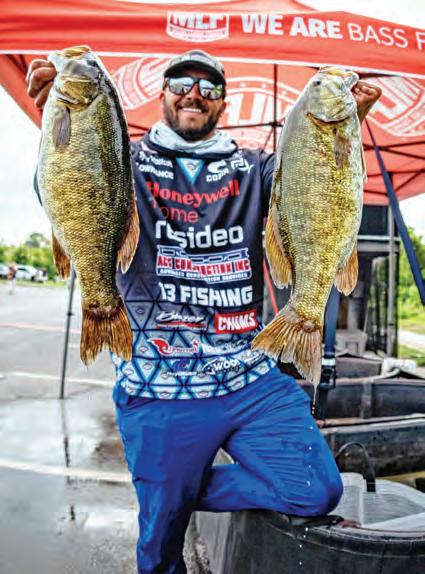
Carolina Rig Gear:
When using this rig, making long casts to cover water is a must, and being able to hook a fish at the end of a long cast is critical. For these reasons, I use a pretty long rod. My go to is a 13 Fishing 7’6” MH Omen Black Casting rod.
You’ll also need to pick line up fast with the reel to remove slack on the take. I use a 13 Fishing Concept A 8:3:1 reel, which eats up line quickly. Spool this reel with 15-pound Seaguar fluorocarbon, and grab a small spool of 10- or 12-pound line for leaders.

THE ANGLER VIDEO MAGAZINE SEPTEMBER 2023 39
Tyler Woolcott is a professional tournament angler and guide. Check out his website at www.tylerwoolcottfishing.com.
TYLER WOOLCOTT
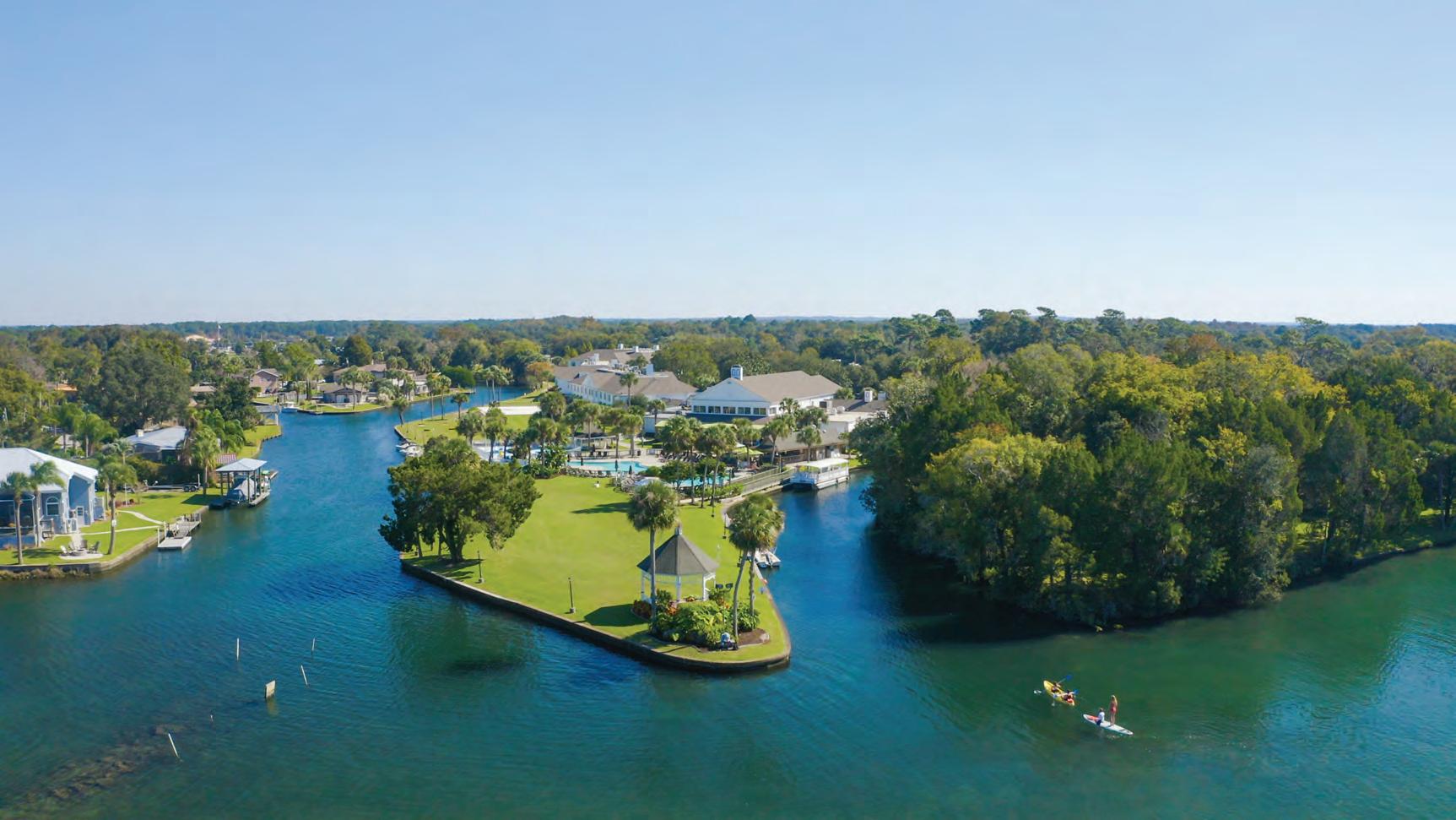
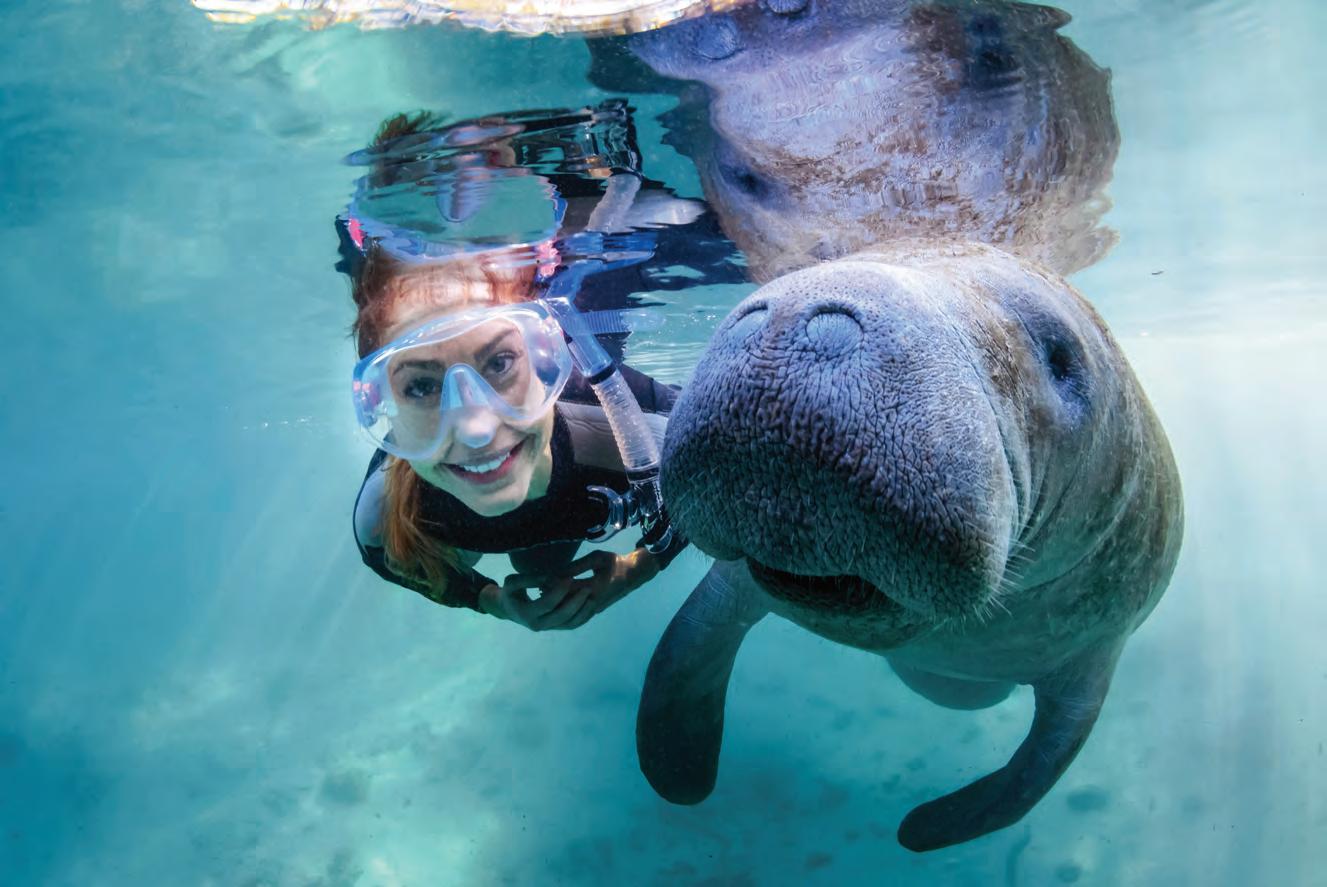
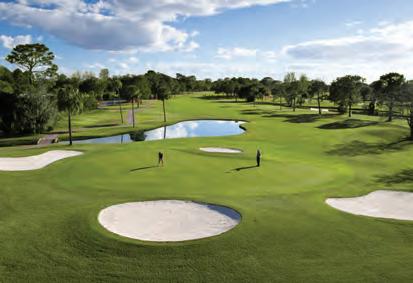













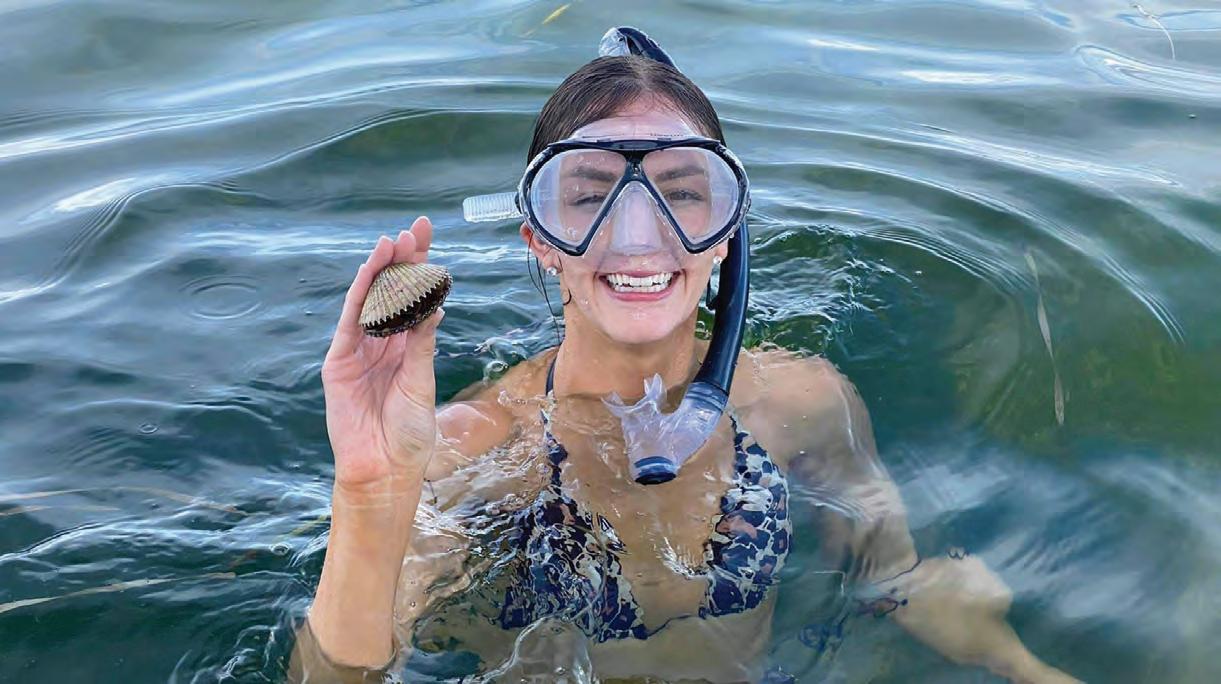
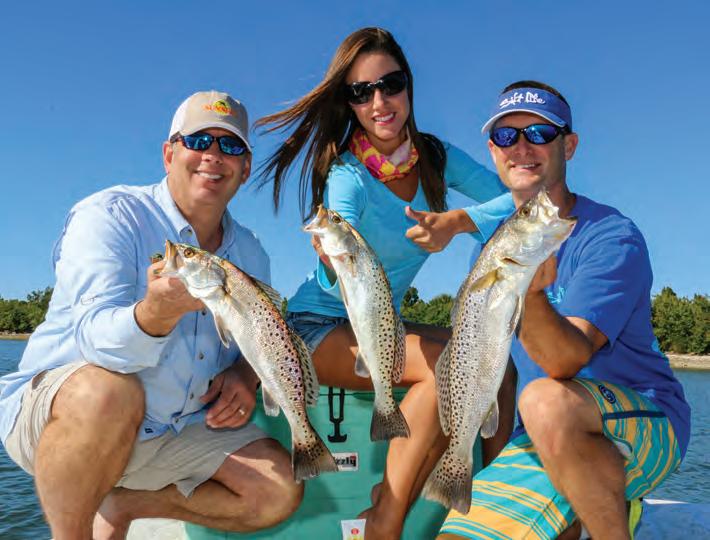
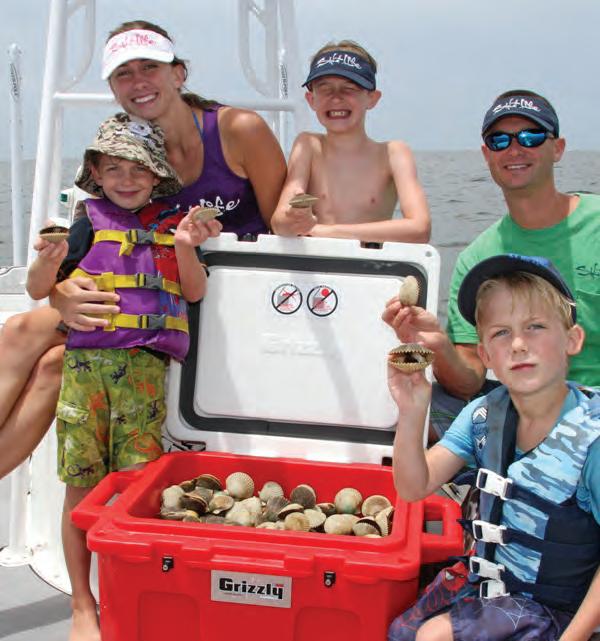
PlantationResortOnCrystalRiver.com Reservations (800) 632-6262 | Hotel (352) 795-4211 Family Adventures Begin Here! Wishing You Were Fishing?
BOWFIN An Overlooked Adversary:
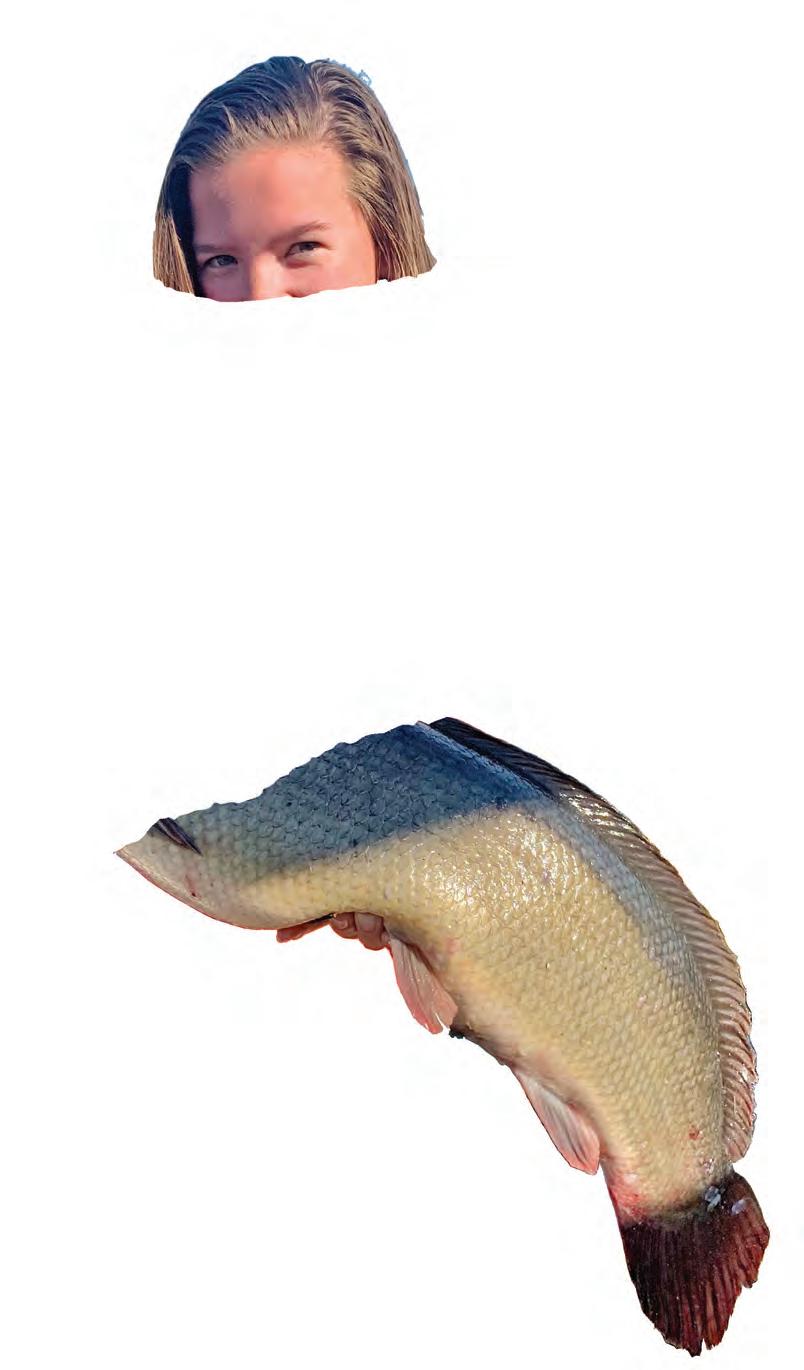 By Emily Hanzlik
By Emily Hanzlik
Bowfin, also known as mudfish, are an overlooked native species that freshwater anglers owe it to themselves to take a closer look at. From sight fishing to topwater to just leaving out a dead bait, bowfin are usually game and will always put up a fun, strong fight!
Bowfin were the first fish I targeted when I began seeking out IGFA records at the age of 12, and I have 10 current bowfin records in the book. They were an amazing fish to introduce me to fishing with light lines in search of line-class records. With bursts of energy and

42 SEPTEMBER 2023 THE ANGLER VIDEO MAGAZINE
predators. An average bowfin weighs between 5 and 7 pounds; however, they can grow up to 21 pounds.
Bowfin prefer the hottest and muckiest water they can find. They thrive in water with dense plant life, which helps them stalk prey and find hiding spots. The Everglades offer plenty of bowfin habitat, and they love swampy backwaters of bayous and canals.
In oxygen-poor, shallow, standing water, bowfin can breathe air from the surface. They have extra blood vessels in their swim bladder, which acts almost like a human lung.
There are many ways to go about fishing for bowfin. The most common method is to cast dead bait, like bluegills or sardines, and wait. Usually, no weight is needed since they live where there is little current. Just match the size of your hook to the size of the bait.
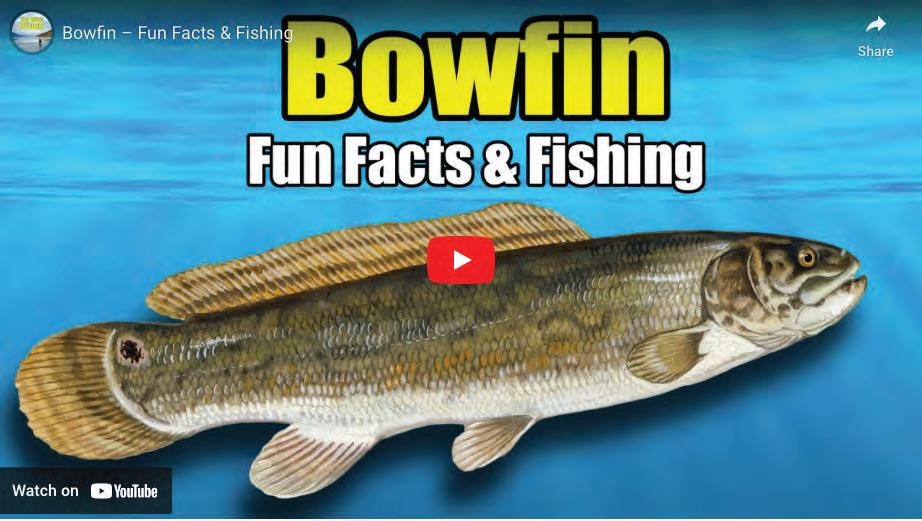
I also enjoy throwing lures for bowfin, and frogs and swimbaits will grab their attention. Savage Gear makes great bluegill and frog imitations. Fish lures around and on top of vegetation to draw bowfin out. Often, you’ll be surprised by other species like bass, gar and catfish.
My personal favorite method for bowfin is sight casting with a fly rod. They prefer slow-sinking white flies that you can drop right on their faces. I like to kayak into extremely shallow areas. Most of the time, they sit in the silt or in the weeds. They don’t spook easily, so you can mess around with them and convince them to bite.
The IGFA all-tackle world record bowfin weighed 21 pounds, 8 ounces. It was caught in South Carolina in 1980.
Emily Rose Hanzlik holds 62 IGFA world records in various categories. She hails from West Palm Beach, where she has a part time Bowfin Guide Service as well as fishing classes for Jr. Anglers. Find her on social media @emilyhanzlikoutdoors.
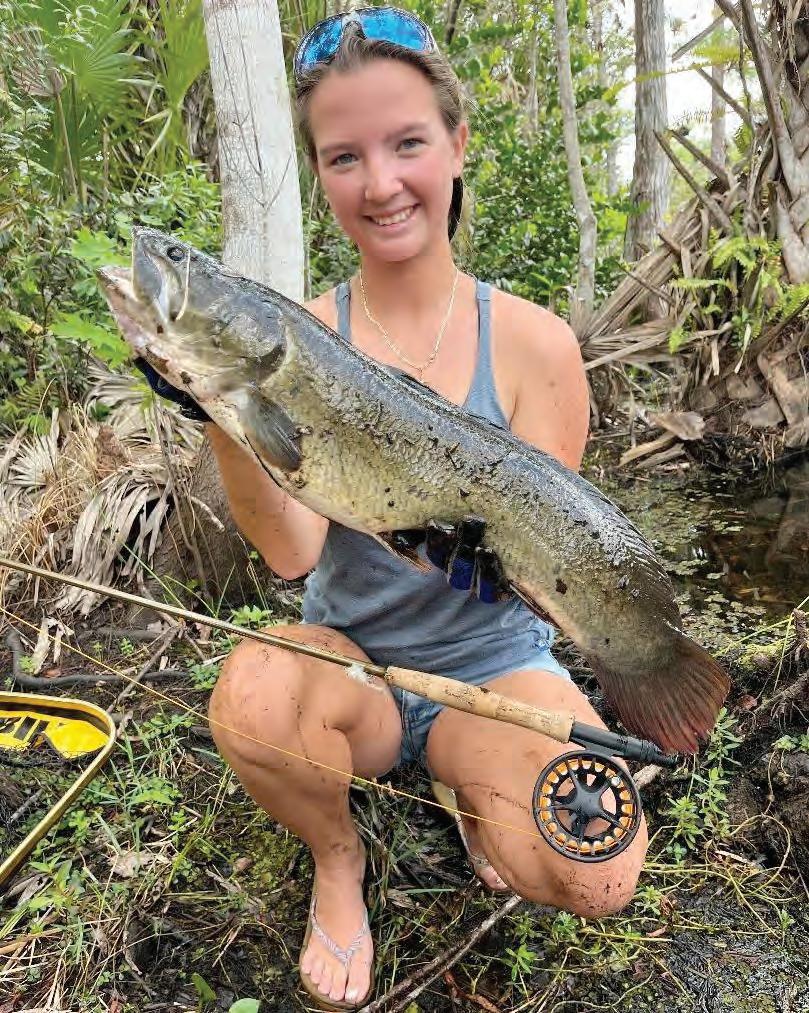
SEAKEEPER RIDE BRINGS MAJOR ATTITUDE TO
MARINE INDUSTRY
When Seakeeper Ride was introduced in August 2022, many wondered how it differed from Seakeeper gyroscopic stabilization systems. Seakeeper, the parent company of Seakeeper Ride has a strong reputation for bringing calmness to a rockin’ and rollin’ sea. But what exactly is Seakeeper Ride and how does it work? Seakeeper Ride is a Vessel Attitude Control System (adapted from the aerospace industry’s Attitude Control Systems) designed to control pitch, roll, and yaw. It can eliminate up to 70% of underway pitch and roll, providing an unparalleled feeling of comfort, control, and confidence. Not to be confused with trim tabs or interceptors which have linear actuators moving solely up and down, the VACS uses a rotary actuator that can move at speeds of 300mm per second to deploy the rotary blade up to one inch. This equates to 100 adjustments made per second to combat wave motions, based on proprietary software and sensors taking 1,000 measurements every second. The incomparable speed counteracts changes to both the running angle and list, immediately. Seakeeper Ride is completely automatic and predicts motion and responds automatically and instantaneously to eliminate them before they’re felt with no manual adjustments needed. The noticeable difference is not only felt by boaters but backed by real results published on the Seakeeper Ride website, based on five main benefits:
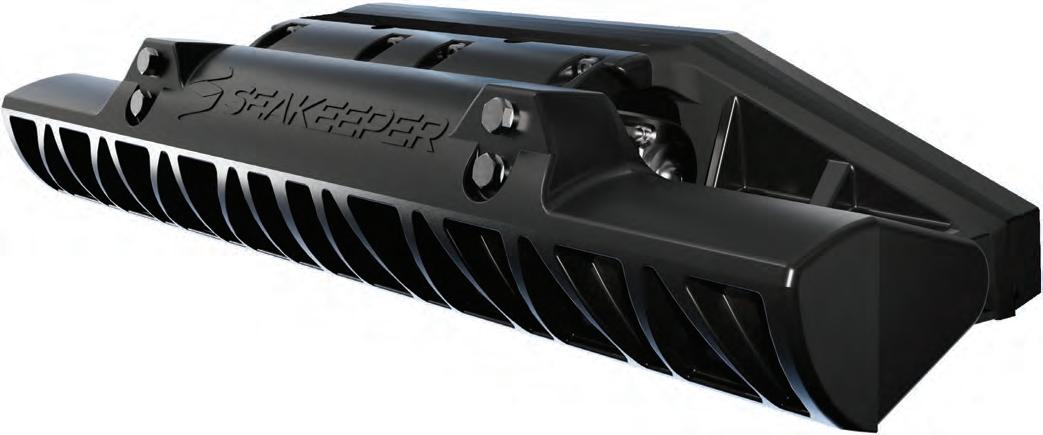
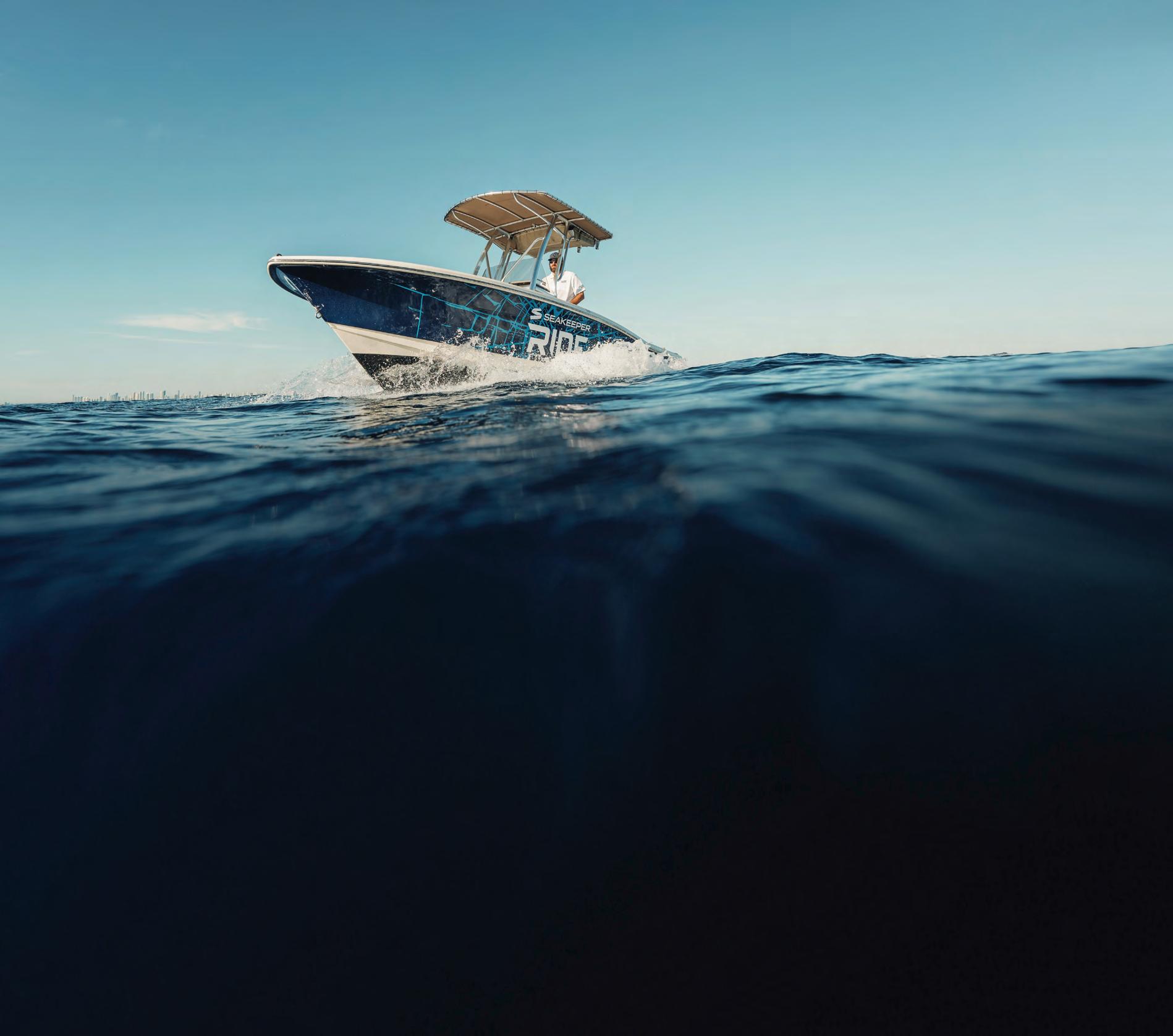
1. Pitch and Roll Elimination - Seakeeper Ride eliminates up to 70% of underway pitch and roll motion that often cause uncomfortable pounding or slamming.
2. List/Level Control - Seakeeper Ride never allows vessel list from movement onboard, wind, uneven load while underway, and/or prop torque.
3. Auto Trim - Seakeeper Ride uses a customized Trim Command Curve to automatically adjust the boat to match the optimal running angle at any given speed.
4. Hole Shot Control - Seakeeper Ride is optimized to allow for faster acceleration that gets the boat on plane more quickly which improves fuel economy during the transition to planing. The operator never loses sight of the horizon, increasing safety for all on board.
5. Coordinated Turn - Seakeeper Ride automatically adjusts the heeling angle of your boat during turns for more comfort and better performance.
Originally available as standard equipment on select models from Sportsman Boats, Scout Boats, Chris-Craft Boats, Jupiter Marine, and Dynamic Boats, Seakeeper Ride is now available for aftermarket installations on qualifying boats 19-35 feet through a dealer network.
Visit ride.seakeeper.com for more information or to locate a dealer near you.

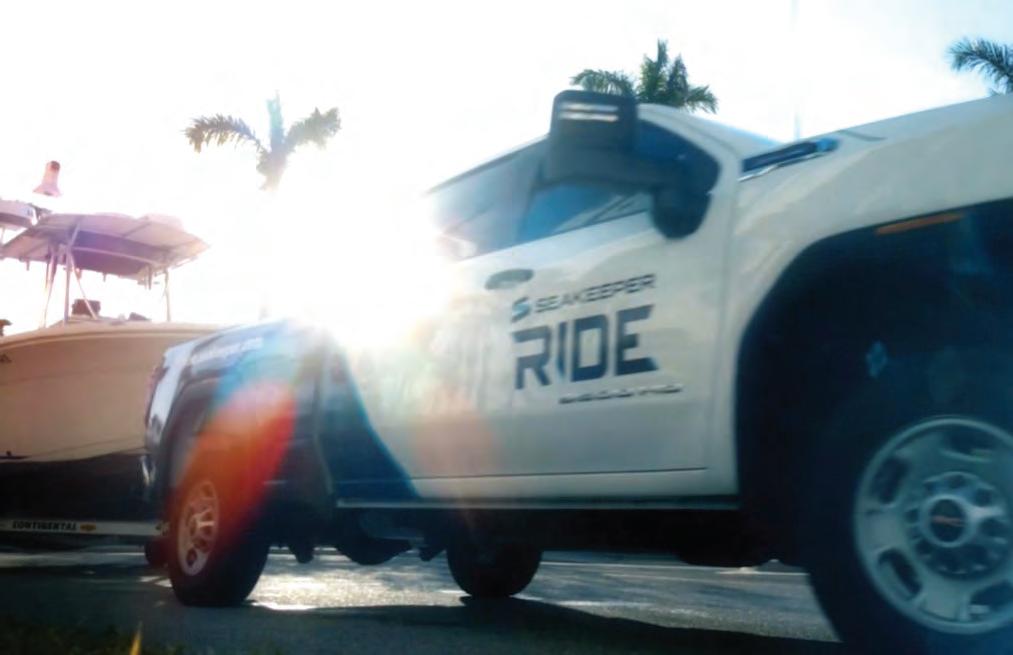

t OUIT YOUR PITCHIN’ GET READY FOR ONE HELL OF A RIDE ride.seakeeper.com
By Capt. David Hulsey
CARPIN’ WITH A FLY
Ilove trout. I love big trout, small trout, stocked trout and wild trout. Guiding folks for colorful trout in the mountains has been a full-time job for me for more than 20 years now, and I’ve enjoyed every minute of it. There is, however, another species of fish that lives up here in the hills of north Georgia that drives me bonkers. When I’m not on the river with folks, I love chasing carp on the fly rod. There… I said it. It’s out in the open
now. I’m a closet carper. The golden ghost or its cousins inhabit almost every river, lake and mud hole in North America. Disdained by most everyone, the lowly carp can put your 20-inch brown trout to shame in the wary, cunning, and plain-out aggravating category. As one of the greats of fly fishing once said, “Fly fishing for carp is a lot like fly fishing for bonefish, but harder.”
Stalking common carp on the mud flats in
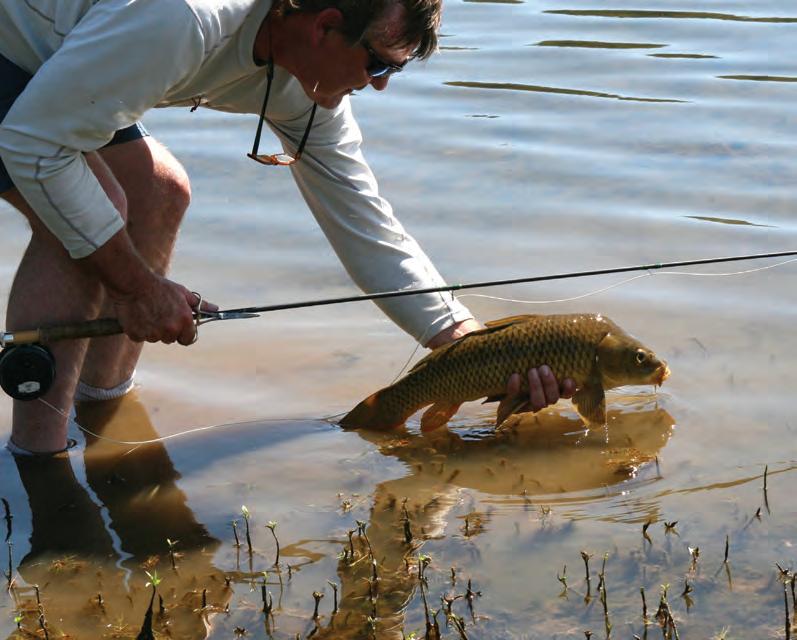

some of our mountain lakes is so close to being equivalent to the saltwater flats for redfish that sometimes you have to look up at the surrounding mountains to tell the difference. Wading or poling up on a flat on Lake Nottely or Lake Chatuge in the heat of summer, one should watch for muds or puffs or cloudy water surrounded by clear water. Almost without fail, if you look hard enough you’ll see old bugle lips going about his business picking up nymphs, crayfish or vegetation.
A spot-on careful presentation within the sight window of the feeding fish is extremely important. He has to notice your fly and get excited enough to stop what he’s doing and come eat your fly. Some days a carp will move 3 feet to pounce on your offering, and other days you’ll swear he’s blind. That’s the aggravating part!
Flies that mountain lake carp seem to like are brown Wooly Buggers, Rubber Legged Dragons in black, olive or brown and Swimming Nymphs all in about size 8 or 10. A five- or six-weight fly rod will suffice for the regular standard 5 pounders, but you may have to go a bit heavier if you find some doubledigit fish tailing for dinner. A 9 foot 3x leader is usually sufficient and is small enough to get by with if the water is gin clear, which is often the case on my home lake of Chatuge. A strip set is in order if he takes it, and get ready to see the backing on your reel on his first run. Get used to it, if you decide to chase the golden ghosts!
Contact Southern Highroads Outfitters in Blairsville, Ga. at 706-781-1414 for the latest information on fly fishing in north Georgia.
46 SEPTEMBER 2023 THE ANGLER VIDEO MAGAZINE



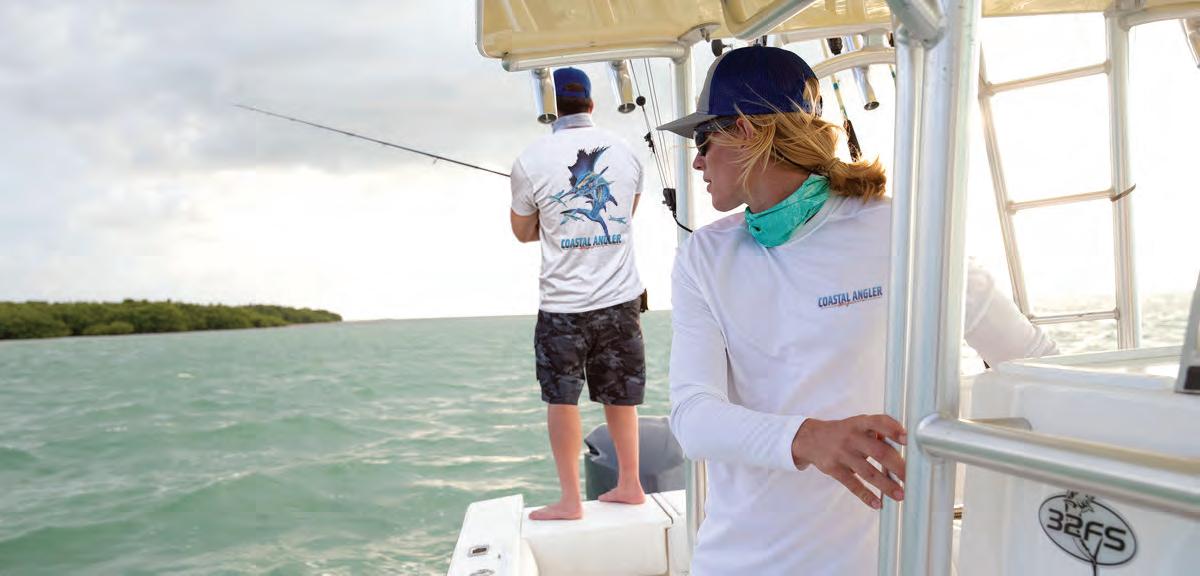

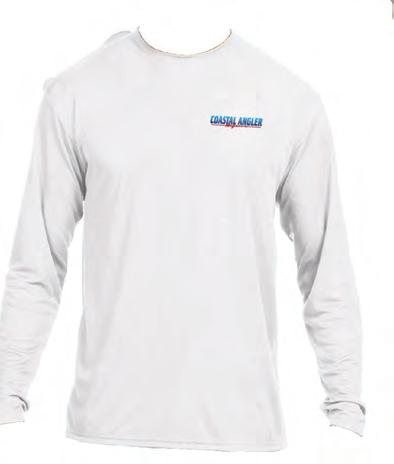



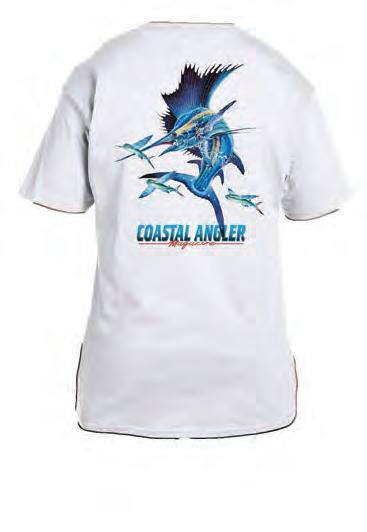
www.coastalanglermag.com/store APPAREL APPAREL SHORT SLEEVE 100% COTTON POCKET T-SHIRT COOLING PERFORMANCE LONG SLEEVE CREW $2538 $2952 100% polyester interlock, moisture wicking, stain release and odor resistant, ultra tight knit, reinforced shoulder seams, 40+UPF. Sailfish design printed on back, CAM logo on left chest, and “Protect Our Waters” on left sleeve.
MAINE BLUEFIN TUNA BITE IS ON FIRE!
The big tuna bite is on fire in the Atlantic off Maine. Unprecedented landings were recorded at the recent 2023 Casco Bay Bluefin Bonanza held out of South Portland, Maine. The annual four-day tournament brought 66 giant Atlantic bluefin tuna to the scales in the first week of August. All five placeholding fish weighed more than 700 pounds.
When the scales closed, Capt. Joseph Pinkham and the crew of My Three Blondes
secured the win with a 756-pound bluefin. The remaining four place-holding fish weighed 739, 737, 707 and 704 pounds.
“This year’s field and the fish they brought in blows away previous tournaments,” said Bluefin Bonanza president and tournament director Bob Humphrey.
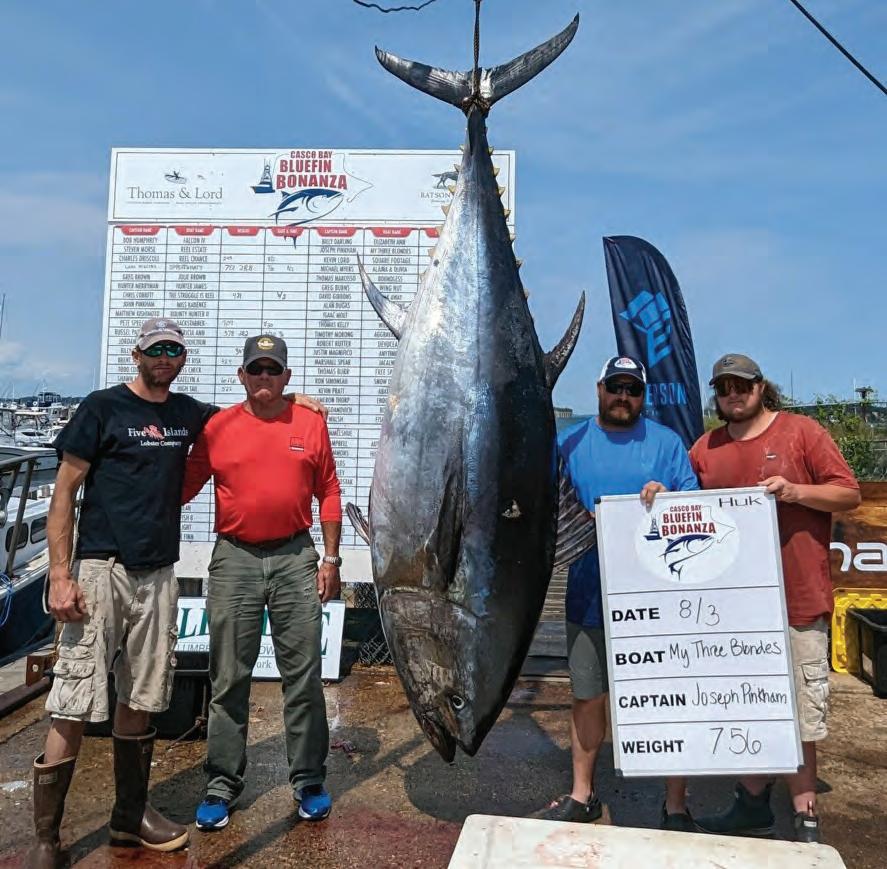
Of the 64 boats competing, 34 boats brought 66 fish to the tournament scales at Port Harbor Marine.
“That’s more than 50 percent of boats, and more than double the number of fish caught the previous year,” said weighmaster Brian Jones.
It’s also just 19 fish short of the total fish landed from the previous 4 years combined. Among those landing fish, 19 boats caught more than 1 fish, three boats caught four fish and five boats brought in three fish.
For more information, visit bluefinbonanza.org.


48 SEPTEMBER 2023 THE ANGLER VIDEO MAGAZINE WATCH VIDEO
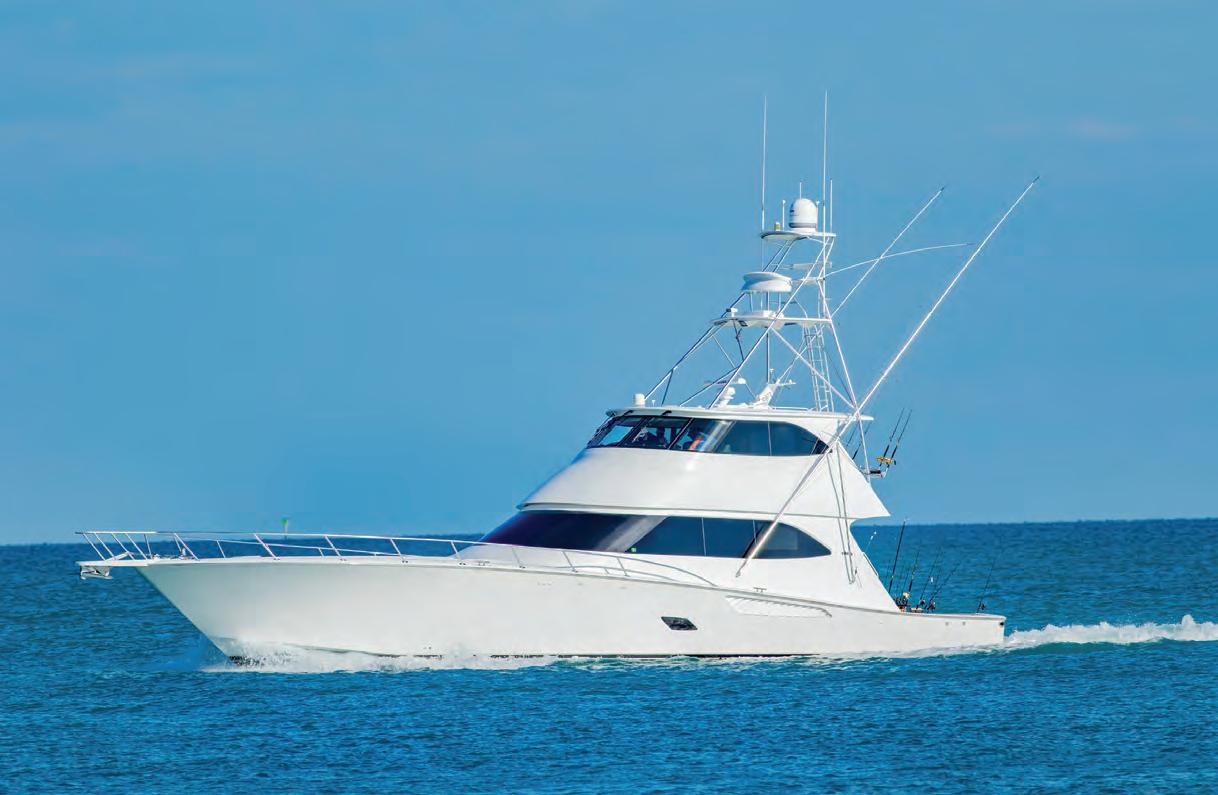
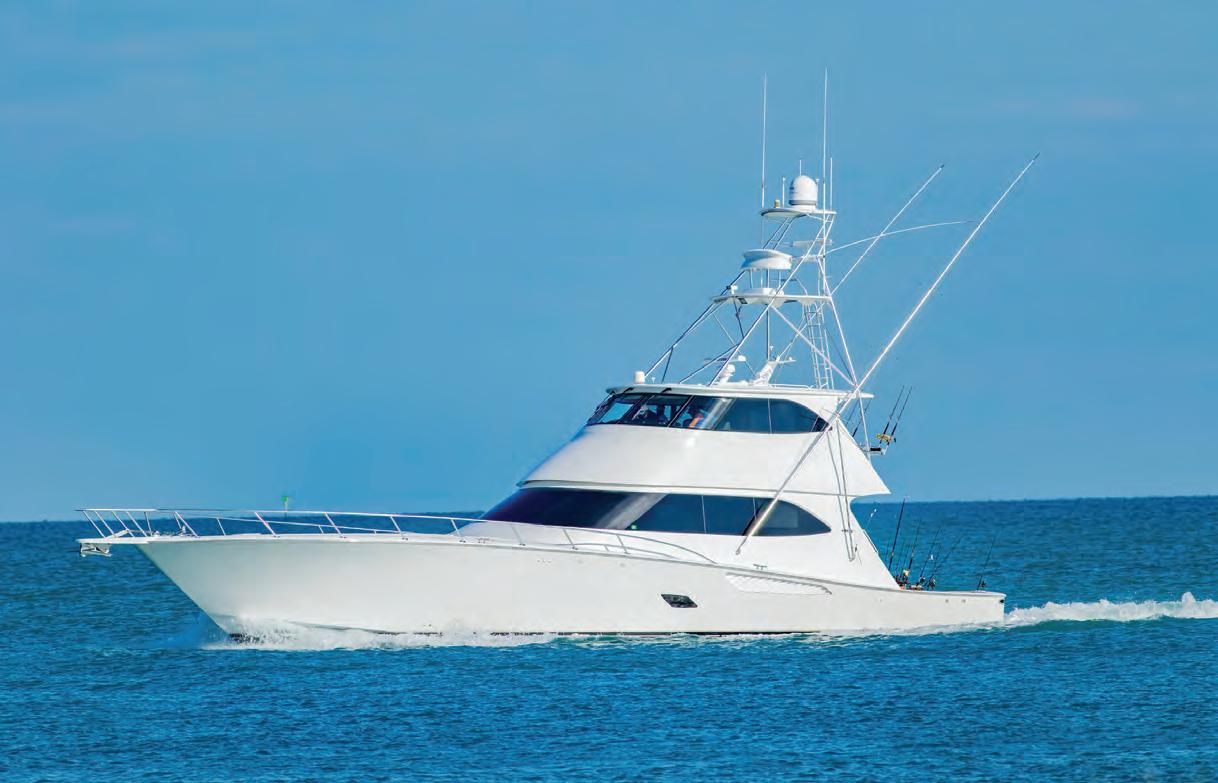






THE ANGLER VIDEO MAGAZINE SEPTEMBER 2023 49 Clean, Waxes & Protects Glass, Lexan, Isinglass, Metal, Gelcoat, Fiberglass, Paint, Plastic & Rubber Remove & Prevents Oxidation, Scuff Marks, Bird & Spider Poop, Fish Blood, Rust, Water & Exhaust Stains Restores Gelcoat, Fiberglass, Metal, Plastic Windows & Rubber www.koenigpolish.com • 1-877-843-9929 USE CODE BOAT10 FOR 10% 0FF CLEANS EVERYTHING. PERIOD.


 10’s of thousands of compact tractor
10’s of thousands of compact tractor
Offer ends 9/30/2023. See dealer for details.
Example parts shown are not on model pictured.
Scan He TO LEARN MORE
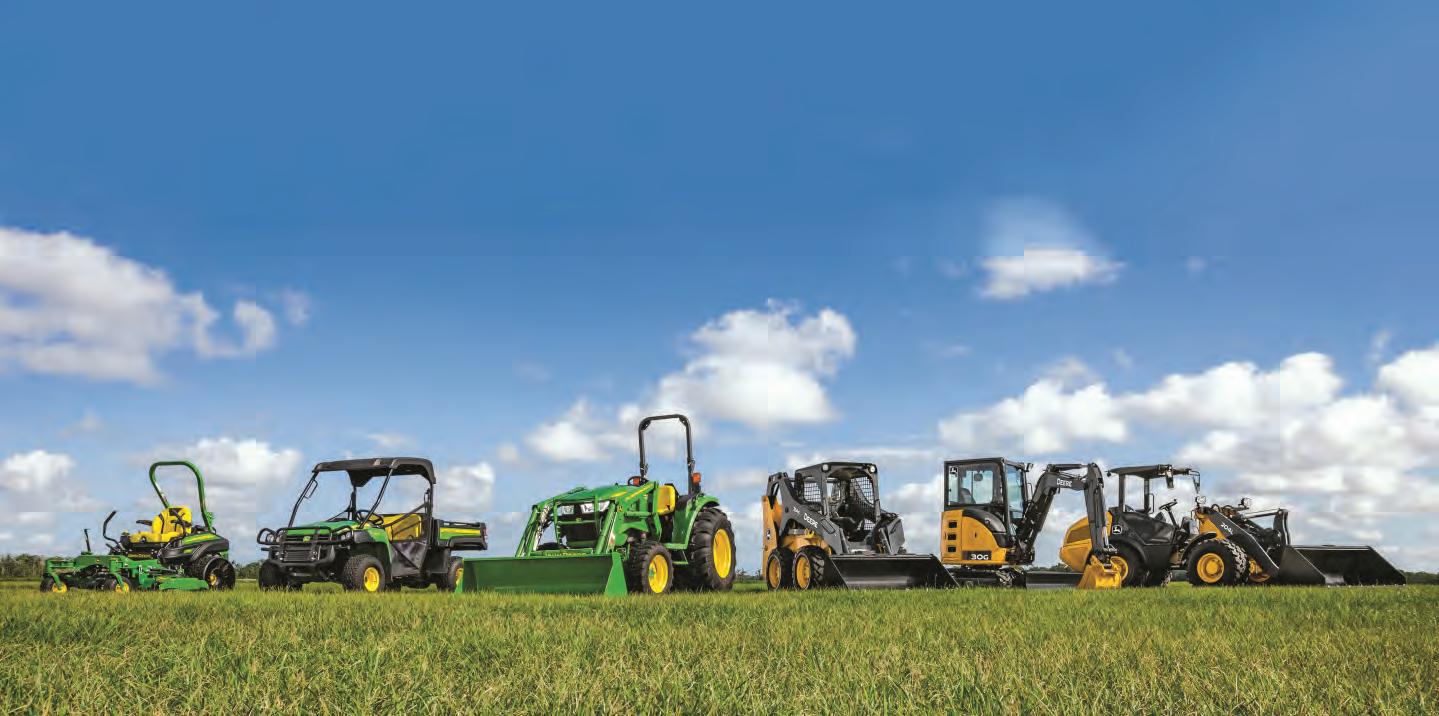



Belle Glade | Boynton Beach | Brooksville | Fort Myers | Fort Pierce Homestead | Immokalee | Largo | Leesburg | Loxahatchee Naples | North Port | Odessa | Okeechobee | Orlando Palmetto | Plant City | St. Cloud VISIT US AT: www. EFE1963 .com TEXT US TODAY! 866-991-3892 18 locations serving Central and South Florida!
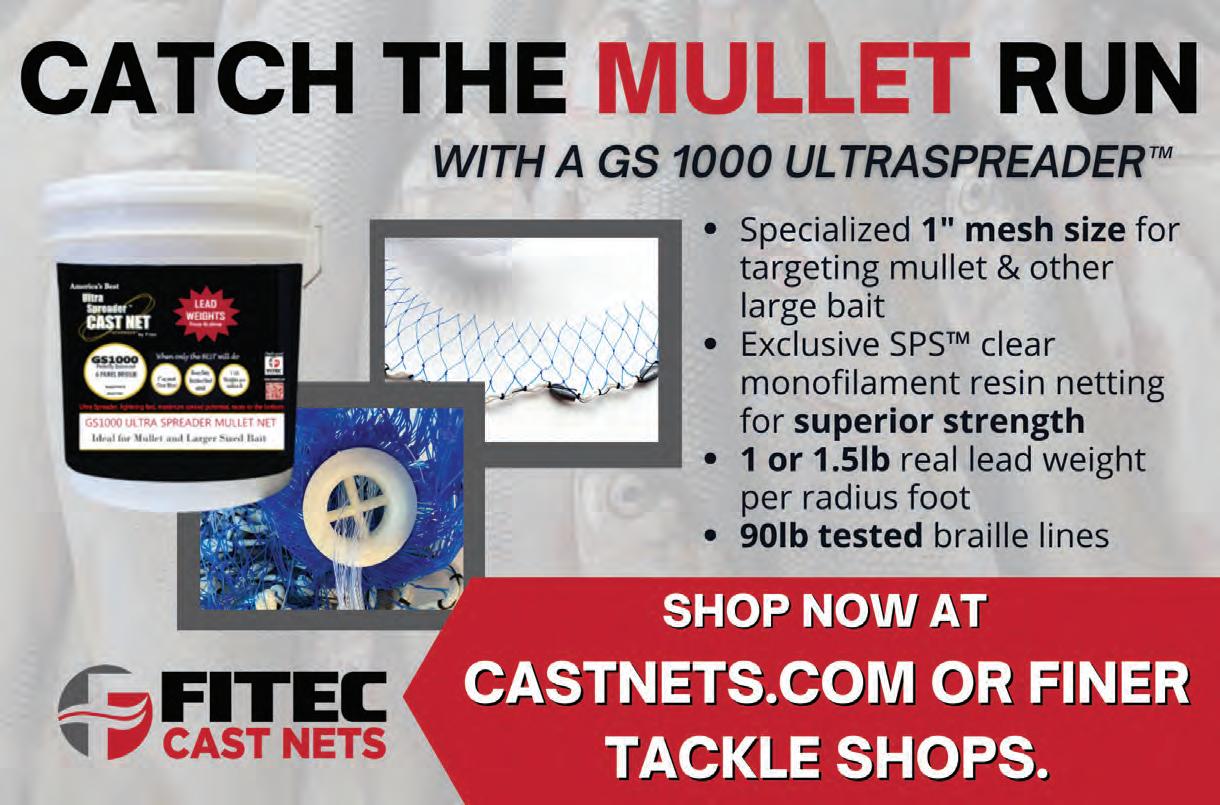
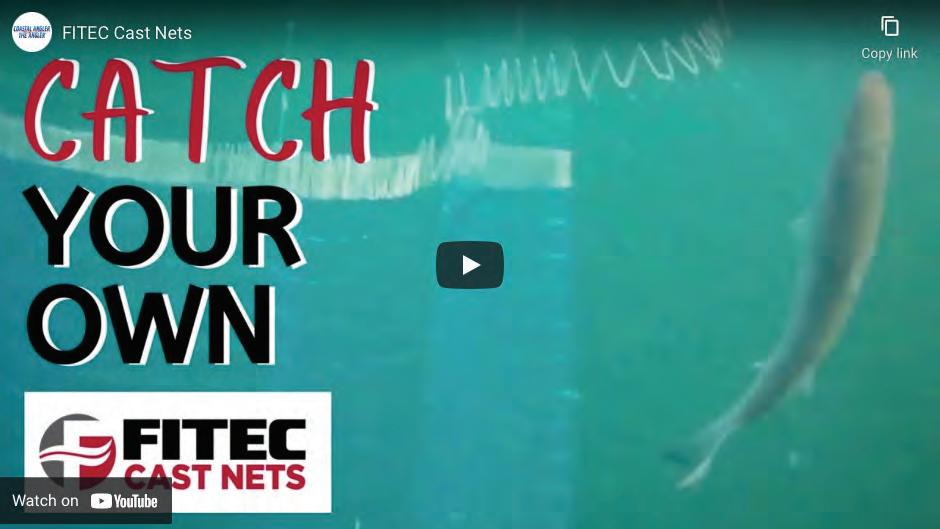
52 SEPTEMBER 2023 THE ANGLER VIDEO MAGAZINE
MOBILE BAY
ARE EASY PICKINGS








or most folks, a jubilee is an anniversary celebration, or maybe it’s a flambe dessert made with cherries. For people in the know on the Eastern Shore of Alabama’s Mobile Bay, a jubilee is a natural phenomenon that leads to ridiculously easy seafood. When weather, water and tidal conditions occasionally align just right, shrimp, crabs, flounder and more float to the surface in the shallows, where people just scoop them up.
In one of his weekly columns, David Rainer, with the Alabama Department of Conservation and Natural Resources explained these uncommon events:
The event starts with an incoming tide with very warm, still water, followed by organic load that creates a situation that depletes the oxygen in the water. Often, jubilees follow an afternoon rain shower and an easterly or northeasterly wind. The Mobile Bay National Estuary Program explains that phytoplankton also contributes to this phenomenon by consuming oxygen near the surface of the water. When the easterly breeze starts blowing, this creates a water current that causes the oxygen-poor water to migrate toward the shore. This has a corralling effect, herding the bottom-dwelling species into the shallows. There those species become so lethargic that people can just pick them up. These events usually lasts two to three hours.
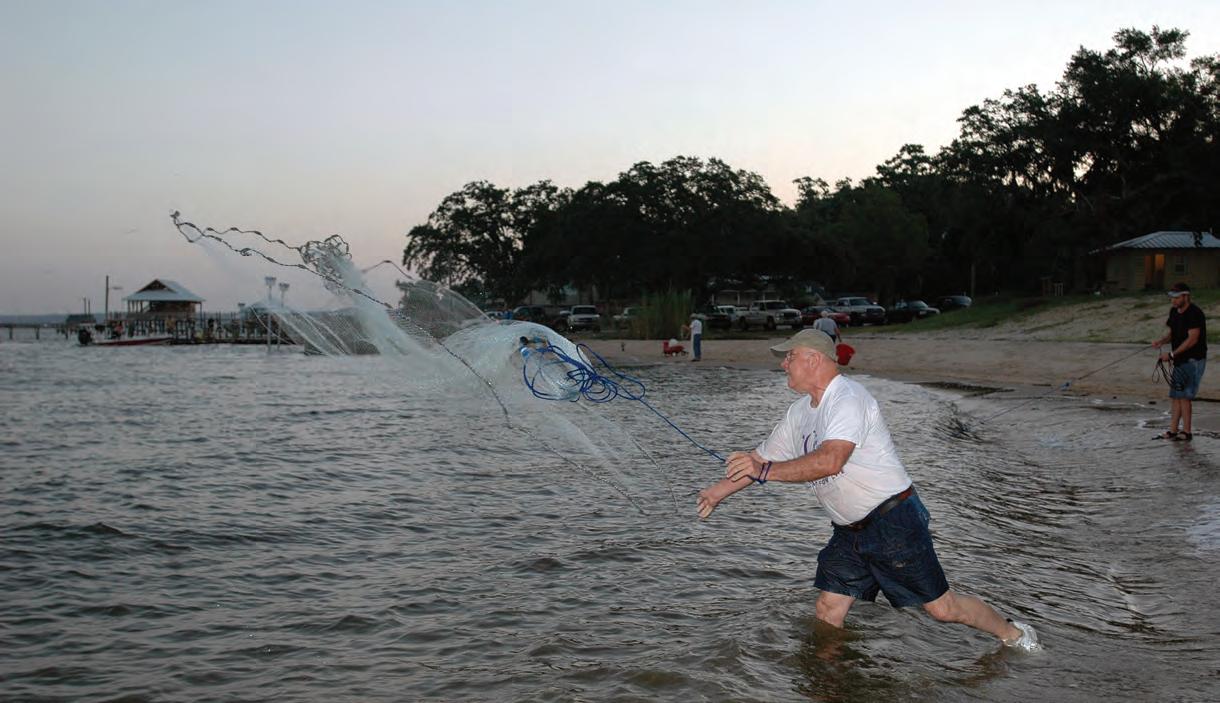
Because they are short lived and rare, jubilees are a source of excitement for some Mobile Bay families who send word out to friends and loved ones to drop what they’re doing and go collect some seafood. However, Rainer warned in his column that a jubilee is not a free-for-all. Normal size and creel limits remain in effect during the phenomenon. Alabama Marine Resources Division Director Scott Bannon said most species survive to swim or scuttle away when dissolved oxygen levels return to more normal levels.
In case you were wondering whether Mobile Bay’s jubilees are the result of climate change or pollution, know that they have a very long history going back to a time when bells would ring to sound the jubilee because locals were dependent on seafood to feed their families.
“Nowadays, it’s more of an interesting phenomenon that occurs in only two places in the world, Mobile Bay and Tokyo Bay in Japan,” Bannon said.

August and September are the best months
to encounter an Alabama jubilee, but it’s not the kind of thing you can predict. You just have to be there and hope to encounter it… or have friends in the know on social media.
For more information, see Rainer’s detailed article on jubilees at www.outdooralabama.com.

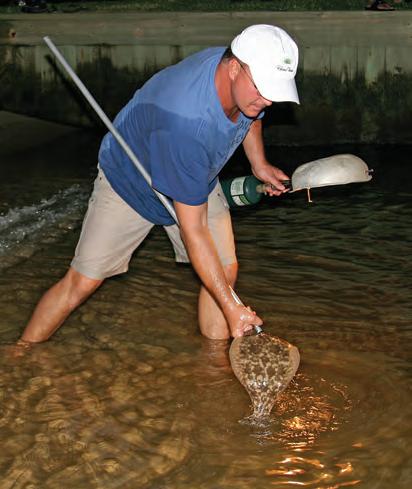

WATCH VIDEO
Experience


Watauga River
Home of world class fishing on the beautiful Watauga Lake, rugged Doe River and designated trophy trout stream, Watauga River
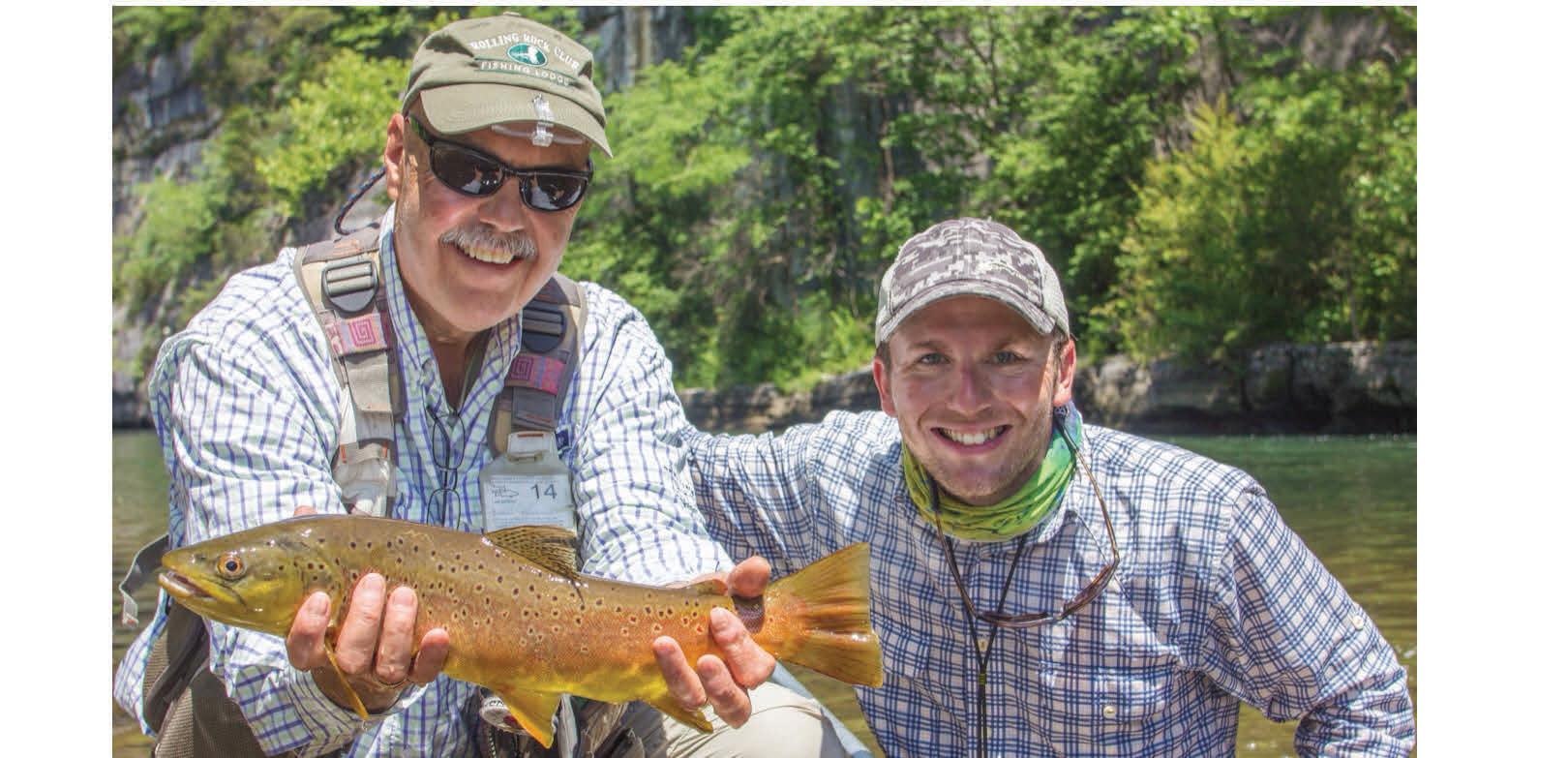
Watauga Lake
Doe River
PLAN YOUR TRIP AT TOURCARTERCOUNTY.COM

Tennessee’s Mountain Playground


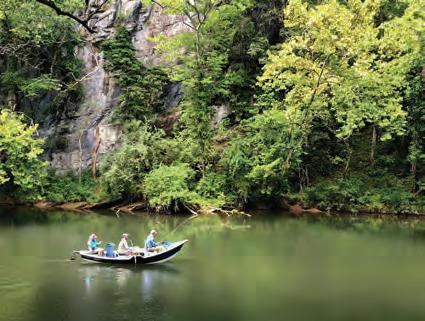
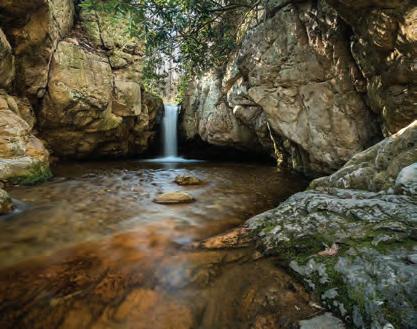












BEWARE THE INJURED FLY-FISHERMAN


Last summer, I hiked into my favorite lake high in the Rockies and hooked, and lost, four good-sized trout. Three days later, I went back loaded for bear with freshly tied leaders and 4X tippet to exact my revenge and get a photo as proof to the disbelievers at the campground that I was not making all this up.
I did land a nice brook trout, which I estimated to weigh 5.5 or 6 pounds. However, as luck would have it, my dropper was wrapped around the fish. I set my net on a steep bank so I could use both hands to unravel it. As I was hooking the dropper back on my rod, I looked down and thought: “Wow, one good flip of his tail and he’s free.” At that exact moment, I looked into his eye, and he at me, and sure enough he flipped, slapped me in the cheek with his tail, and fell back into the water.
I had finally landed one of the big ones, yet
he still got the last laugh. When I told the story back around the campfire, everyone was like, “Sure, Mike, sure…” Right then and there, I made up my mind to go back to the same lake next summer and redeem myself.
Then, last August, tragedy struck. I had a freak cycling accident. In addition to pulling several muscles and some ligament damage, I had fractured my pelvis. The recommendation was to bolt a plate onto my pelvis to allow it to heal. Not good. When I told the doctors I wanted to let it heal on its own, they told me I was “too old for that.” But I’m stubborn.
While laid-up in bed for six weeks last fall, I talked to my buddy Pete on the phone. He mentioned deer hunting, and I asked him for some deer tails to tie up some Clouser Minnows to catch a big brookie come summer. He mailed me eight big, beautiful
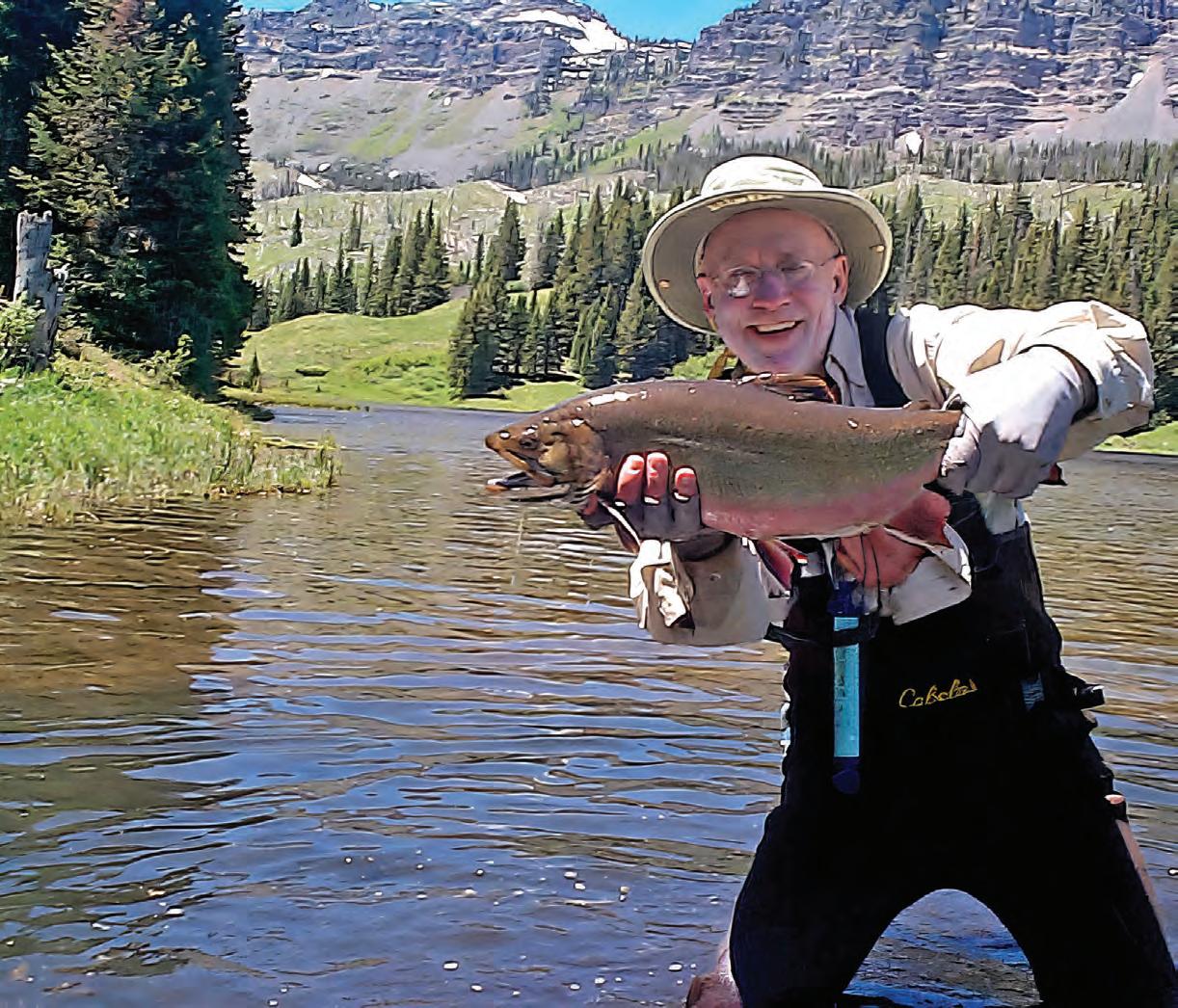 By Michael Fitzsimmons
By Michael Fitzsimmons
Upstate New York white-tail tails. I got busy tying flies and told him I’d send him a photo of a big brookie come summer. “Sure,” he said, “sure, Mike.
After three months on crutches, I learned to walk again … and then to hike again … and to then to hike with a full pack again. Returning to catch another big brookie served as my primary motivator. I knew if I could just make the 3.5-mile hike into the lake, I would catch a big brookie on a Clouser.
And I did. He wasn’t as big as the one that slapped my face, but he was big enough. The Fitzman was back!
56 SEPTEMBER 2023 THE ANGLER VIDEO MAGAZINE
This story is copyrighted by the author, Michael Fitzsimmons, whose book “Adventures of a DryFly Junkie” is available on Amazon. Contact the author at dry_fly_junkie@hotmail.com.
WATCH VIDEO
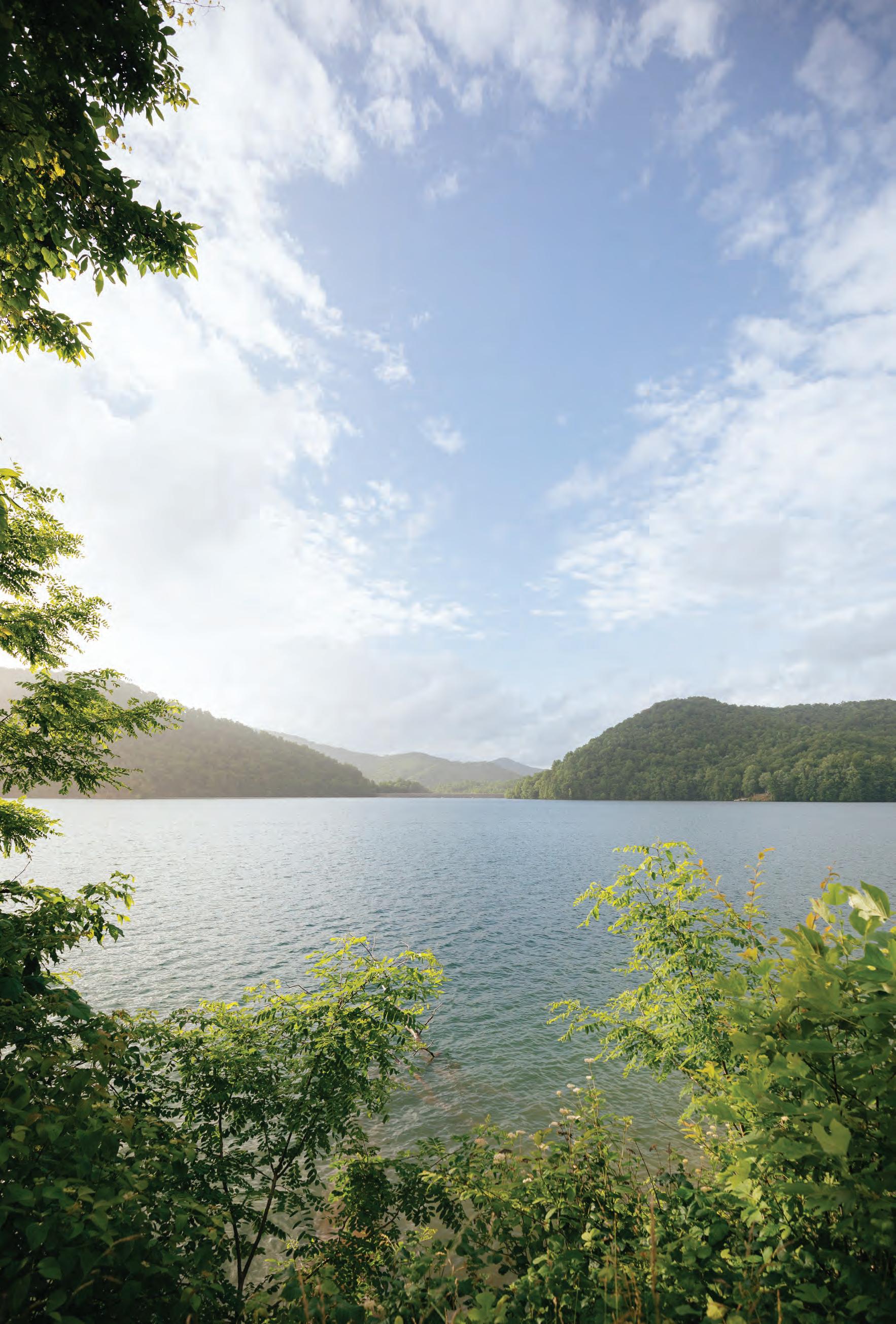

One can never get lost here visitcherokeecountync.com Visit Cherokee County


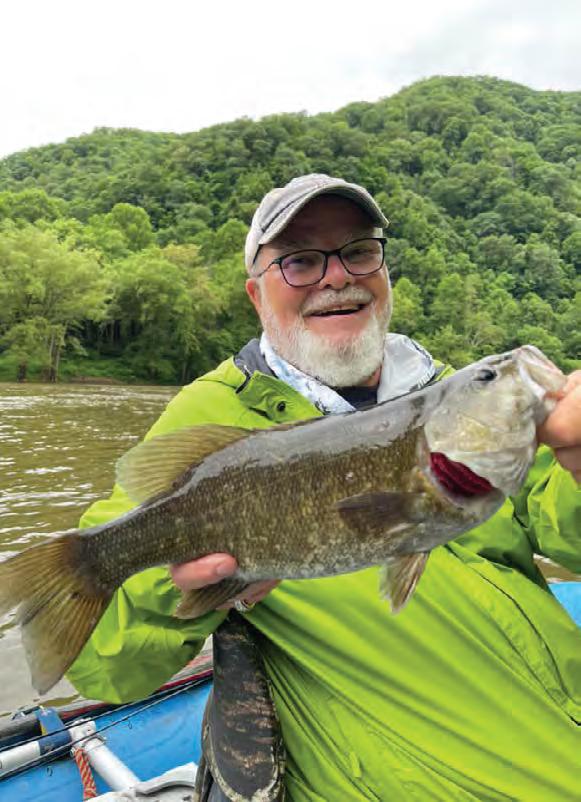
MONSTERS OF THE NEW RIVEr NewRiverGorgeCVB.com 800-927-0263 Request A Visitor Guide
Photo Courtesy: fishandhuntwv.com & WV Tourism
Touted as one of the best smallmouth fisheries in the east, the New River offers over 50 miles of fishable waters in the New River Gorge National Park and Preserve. The myriad river access points allow you to wet a line for smallmouth bass, walleye, muskie, and more. Local guide services float these water providing access to sections of the river that are not accessible by land. With plenty of hiking and biking trails, ziplines, paddleboarding tours, whitewater rafting trips and more, there are outdoor opportunities for the whole family.


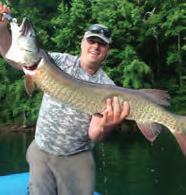
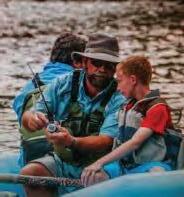






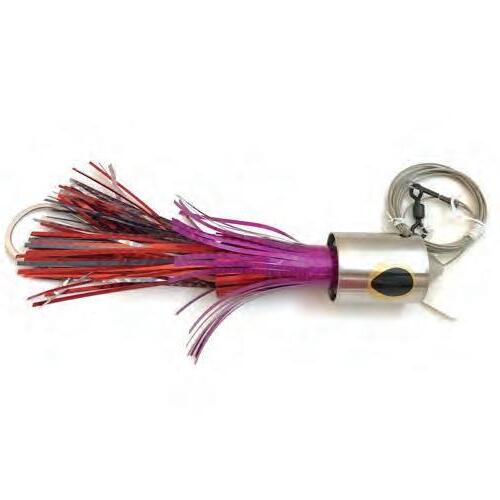
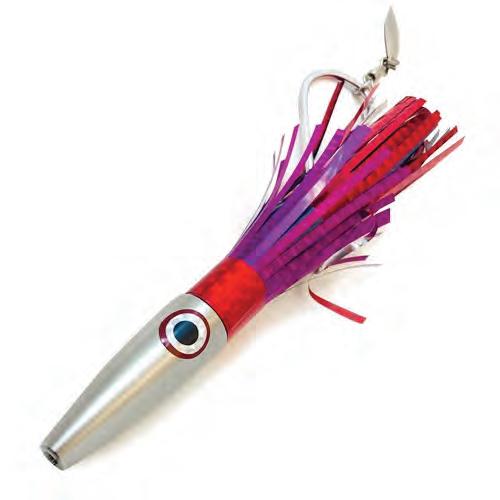





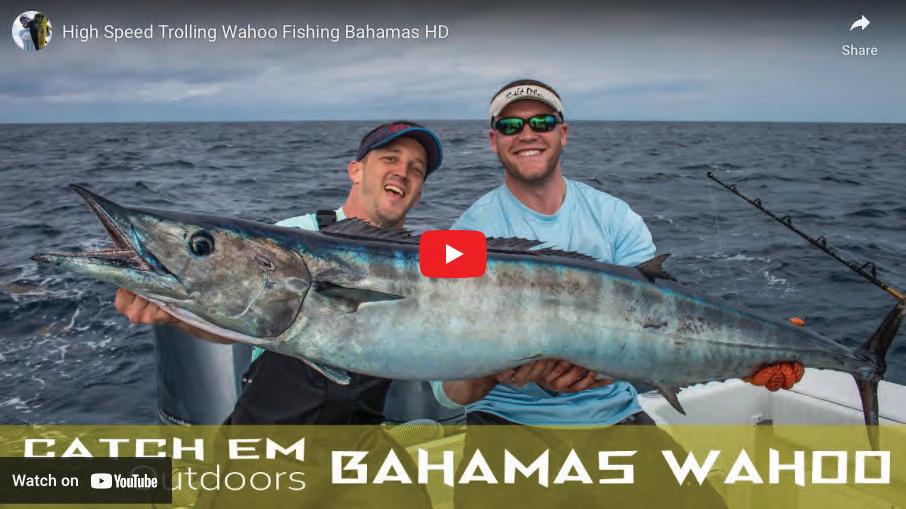
62 SEPTEMBER 2023 THE ANGLER VIDEO MAGAZINE WELL-ESTABLISHED LURE BUSINESS FOR SALE FOR SALE Owner Retiring After 23 Years! • 100K-125K Yearly Profit • 350K of Inventory • 1600 SF of Shop Space • 90% of Sales Online • 80% of Products Sold in FL • All Lures Rigged & Ready Full Training Provided! Can Move Shop Anywhere! BALLYHOOD WWW.BALLYHOOD.COM WWW.BALLYHOOD.COM ASKING $650K 714.545.0196 SERIOUS INQUIRIES ONLY Contact Darrell Primrose, Owner sales@ballyhood.com
Lefty’s Deceiver
By Carlos Hidalgo
Although he would deny it, Lefty Kreh is a legend. With great knowledge (he has authored or co-authored over 30 books and hundreds of magazine articles), boundless energy (he has performed countless lectures and casting demonstrations over the last 60+ years), down-home humor (a dumb person would “pick up a snake to kill a stick”), and showmanship (at casting demos, he finds a pretty woman and makes a cast that curls the fly line around her neck), Lefty has done more to popularize fly fishing than any other person in the last century. He has fished with Fidel Castro, Ted Williams and Ernest Hemmingway, but he hasn’t just witnessed fly fishing history, he has created it. His innovative fly casting techniques are used by millions of us today.
Oh yeah, he also developed Lefty’s Deceiver, the best fly pattern ever devised. Lefty tied the first Deceiver during the late 1950s. He wanted a fly that was easy to cast, didn’t foul, looked like a baitfish and had great action in the water. The pattern can be easily described: a tail made up of several matching hackle or saddle feathers with a bucktail collar. Add flash material to either or both, eyes to
the head and some type of red material for the throat, as needed. The hook shank beneath the collar (the body) can be wrapped with the tying thread or a flashy material, like mylar tinsel or Diamond Braid.
By the way, Lefty says the key to the pattern is to tie the collar at least as long as the rear of the hook, which keeps the hackle tail from wrapping around the hook.
In appropriate sizes and colors, Lefty’s pattern has deceived just about every fish that swims, from four-inch bream to 400-pound billfish. Lefty’s Deceiver has even graced a U.S. Postal stamp.
Lefty’s favorite Deceiver colors are chartreuse/white and yellow/chartreuse. I tie them in many sizes and colors, and my favorite is tied in a Firetiger color scheme. This color works very well for many saltwater fish in sizes 1/0 to 3/0. It has also been very successful for me for peacock bass and largemouth bass in south Florida in size 2. I imagine smallies would jump all over it, too.
Contact Carlos at cah6620@gmail.com to order his book, “South Florida’s Peacock Bass.”
Lefty's Deceiver (Firetiger)
Lefty Kreh
HOOK – Mustad 34007 or similar, size 2 to 3/0


THREAD – fluorescent yellow
TAIL – two yellow and one yellow grizzly hackle on each side, topped with yellow Krystal Flash
BODY – yellow thread or Diamond Braid
COLLAR – yellow bucktail with yellow Krystal flash and a small yellow grizzly hackle on each side, topped with green Krystal Flash and green bucktail
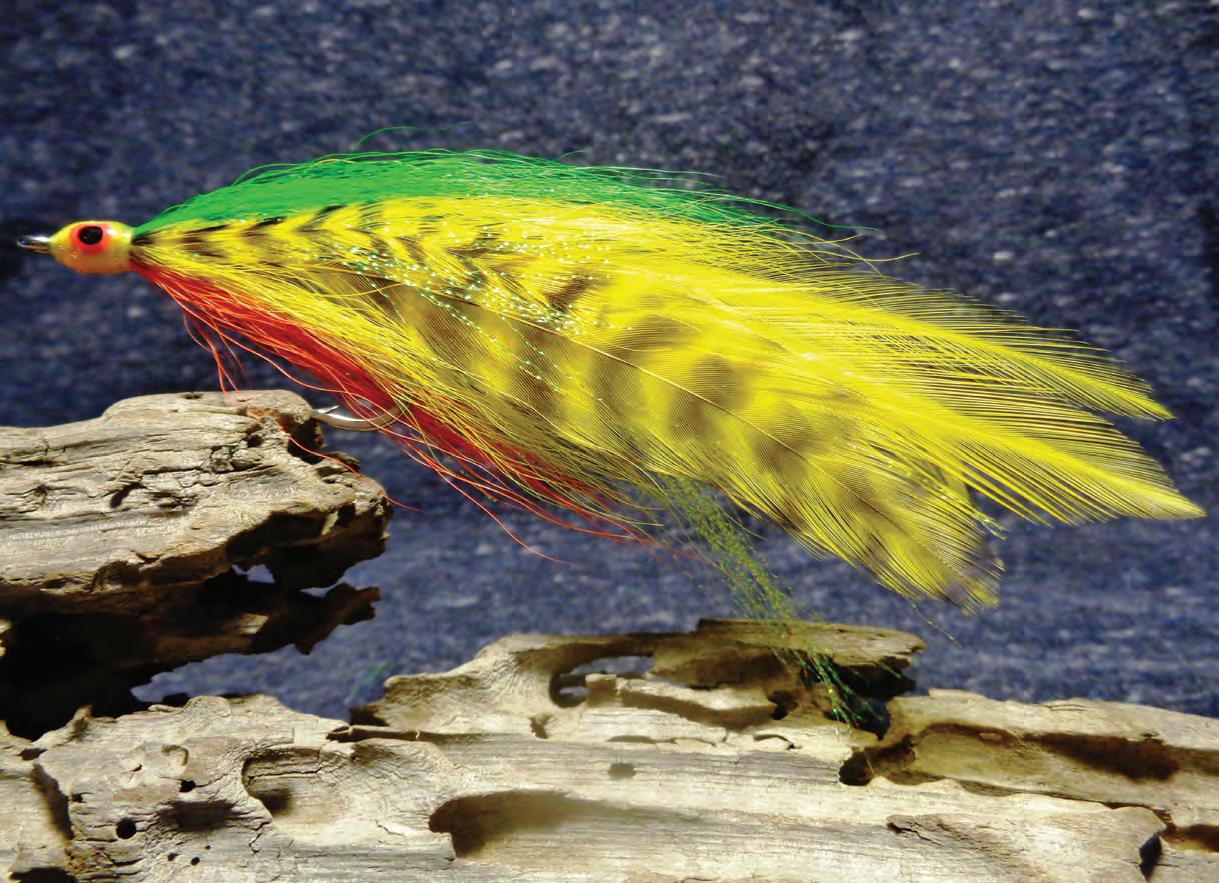
THROAT – orange bucktail, as long as the collar
HEAD – fluorescent yellow, with painted orange/black eye, covered with five-minute epox y
THE ANGLER VIDEO MAGAZINE SEPTEMBER 2023 63 WATCH VIDEO
WITH EXTENDED RANGE FOR OPEN WATER




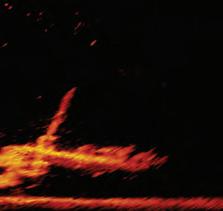
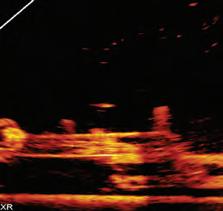



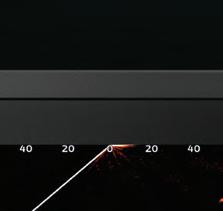


LIVESCOPE XR
© 2023 Garmin Ltd. or its subsidiaries.
GARMIN® LIVESCOPE XR SYSTEM: THE BEST OF THE BEST JUST GOT DEEPER

With an optimized design for deeper water, the new XR transducer has extended range elements so anglers can see up to 500’ in freshwater and 350’ in saltwater. It also includes the Reverse Range feature, allowing them to utilize more of the screen. To see detail closer to the boat, the Compress Range aspect displays a real-time look in sharp detail up close, while still letting the angler keep an eye on their further-away target.
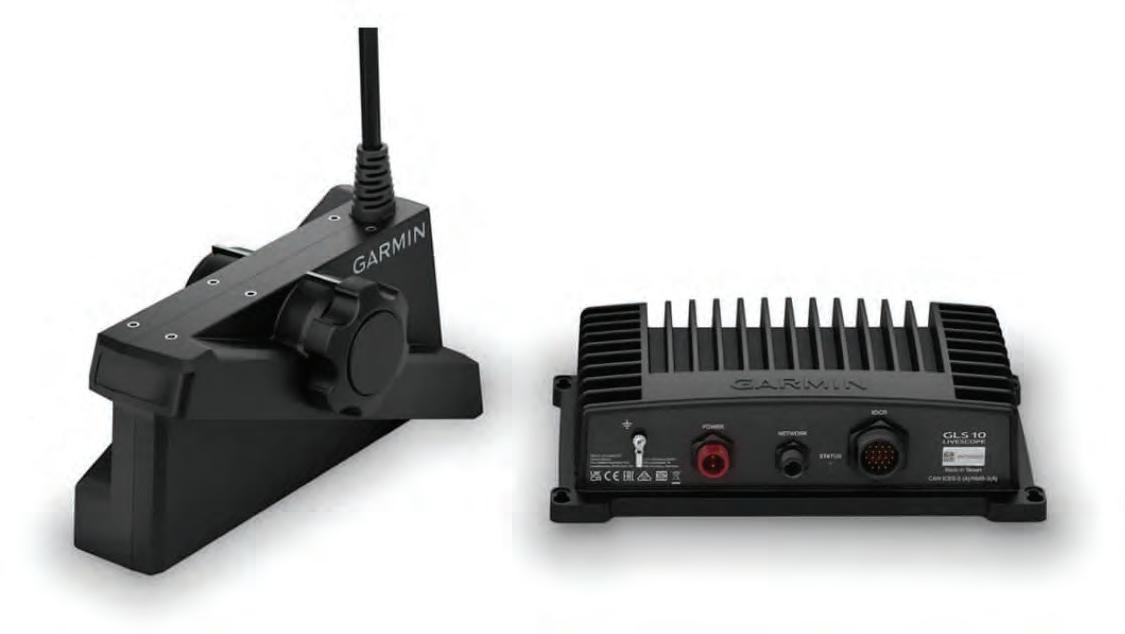

The LiveScope XR displays seven different color palettes to view fish and structure in vivid contrast and clarity. In keeping up with previous
constantly adjust the sonar beams to compensate for boat motion, so even in rough waters, anglers will still see a steady image, even at an extended range.
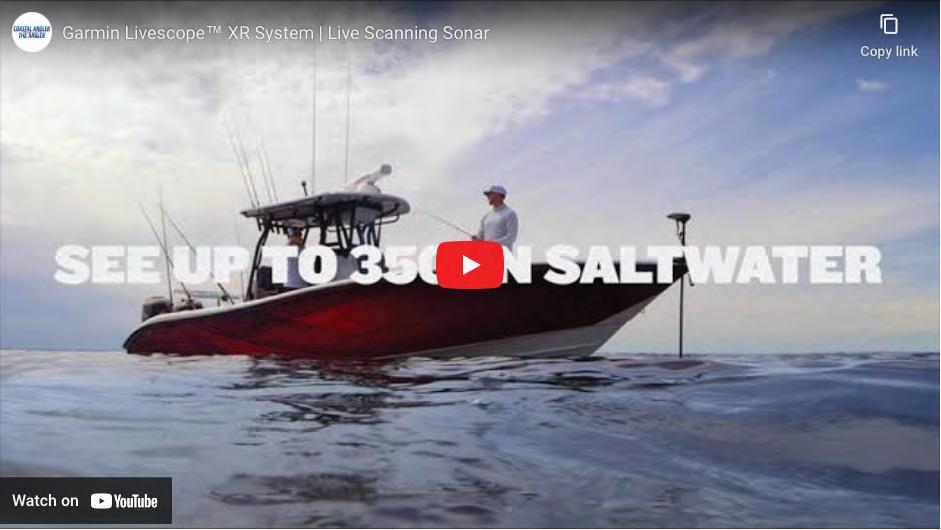
The XR System delivers three unique vantage points with one mount that can easily be adjusted to fit different fishing techniques and preferences, without needing additional tools. Simply turn the transducer forward for a live look at what’s out in front of the boat, or point it down to see directly beneath the boat, or even turn it sideways with
products, visit Garmin.com/marine, or connect with @garminmarine on social media.



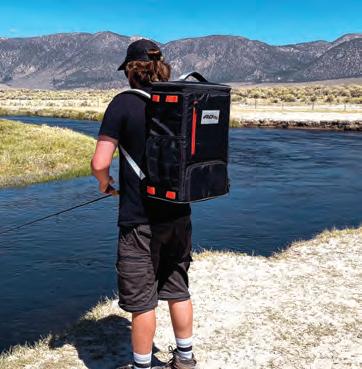
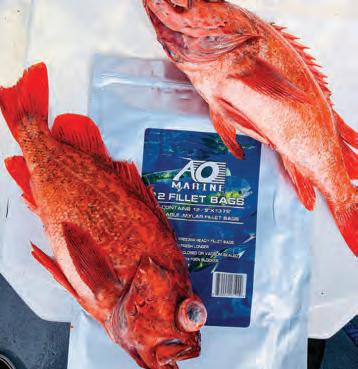
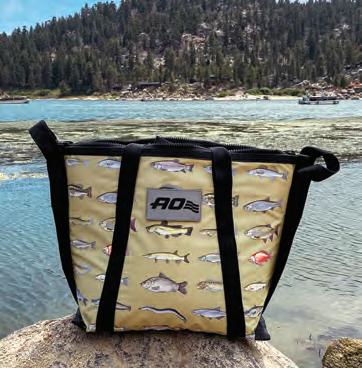

WWW.AOCOOLERS.COM
COOLERS
, the leader in high-performance soft-sided coolers, is hitting the water this year with new, upgraded fishing products. Our fishing team partners told us what they needed, and we listened!

Products are in stock and ready to ship; The Fishing Cooler Backpack, 2, 4 & 6ft Fish bags, Fillet bags, Boat fenders, EVA Traction pads, Inflatable Docks, ISUPs, and of course, our high-performance coolers specifically designed for use on boats, guaranteed not to leak, and to keep ice cold for up to 24 hours.
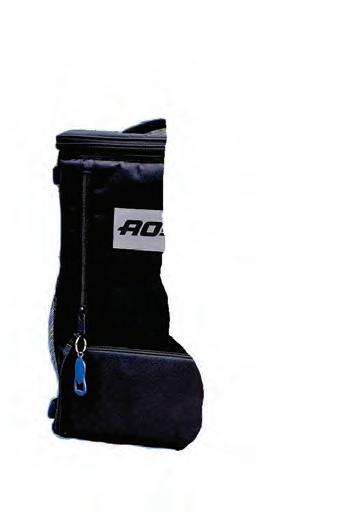

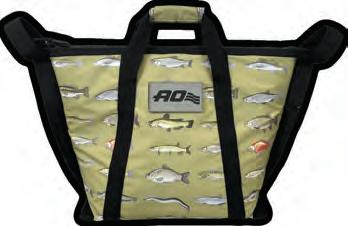
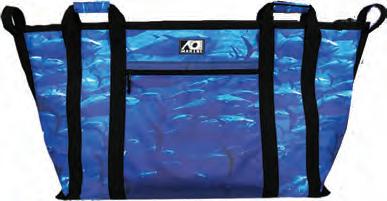
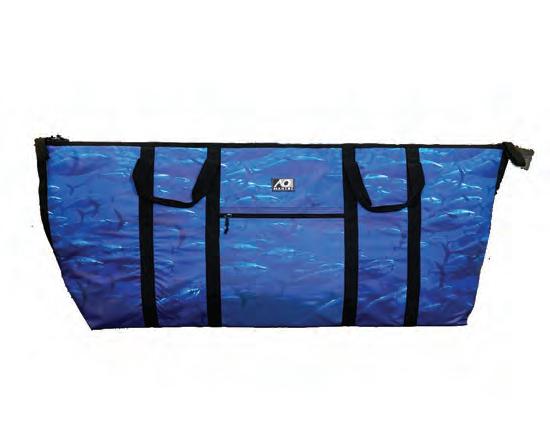
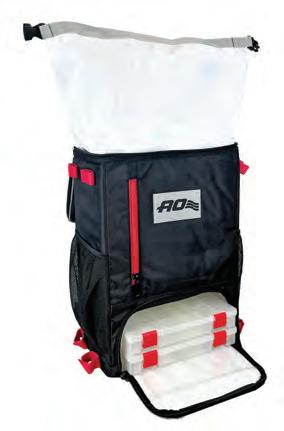
Thirty years ago, AO was launched to provide active, hard-core people with quality products at a reasonable price. We started selling our soft-sided coolers to the hard-core, go-fast boaters and fishermen in Lake Havasu. We aimed to keep ice in our coolers for up to 24 hours in 120-degree Havasu heat. That goal was accomplished 30 years ago, and we’re still at it.


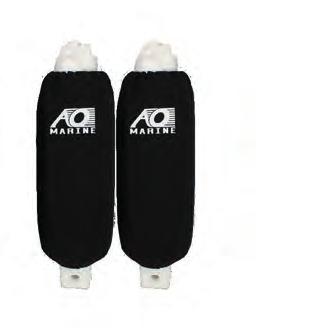
We know our customers; they fish and boat in the summer and ride the dunes or trails in the winter. AO products give those high-octane souls greater freedom to embark on and enjoy what’s important to them.
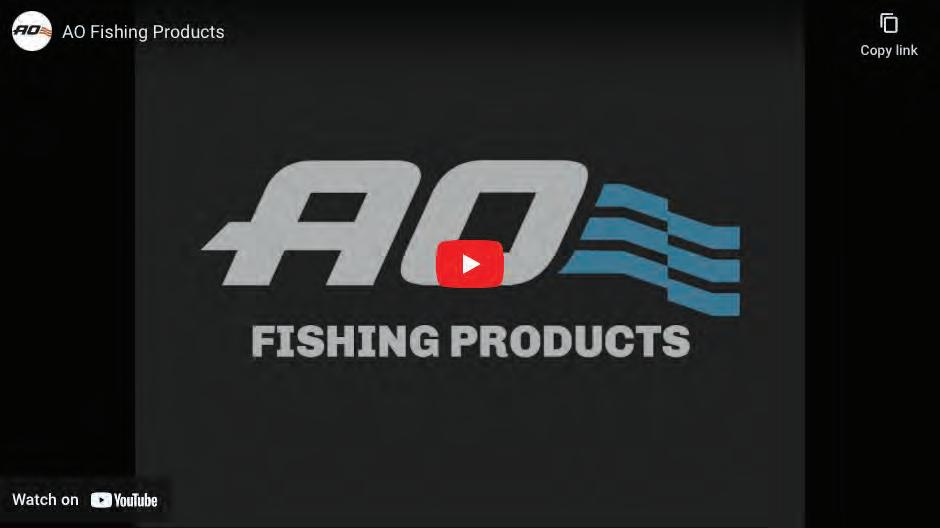
Make sure that your gear does not hold you back from doing what you love. AO products are built to handle whatever offshore adventure is coming next.
AO is flexibly rugged, seriously fun, and honestly real!
We’re looking for active, adventurous folks that demand quality and performance from their gear. Share your adventure and send us your fish story or photo.

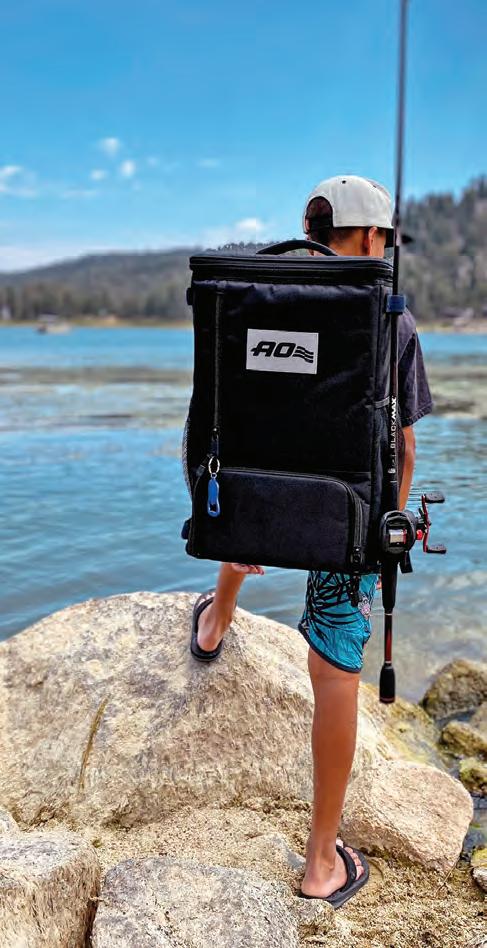
www.aocoolers.com
BEGINNERS LUCK: Novice Lands World Record Opah
Opah, also known as moonfish, are a relatiely rare incidental catch for anglers tuna fishing in the Pacific off California. A potential world record opah caught on an overnight trip out of San Diego in early August is even more amazing because it was landed by an angler on his first-ever trip offshore.
According to FTW Outdoors, Angler Beau Leaman, of Santa Clarita, Cali., hooked and landed a 188.6-pound opah while fishing aboard the Horizon out of
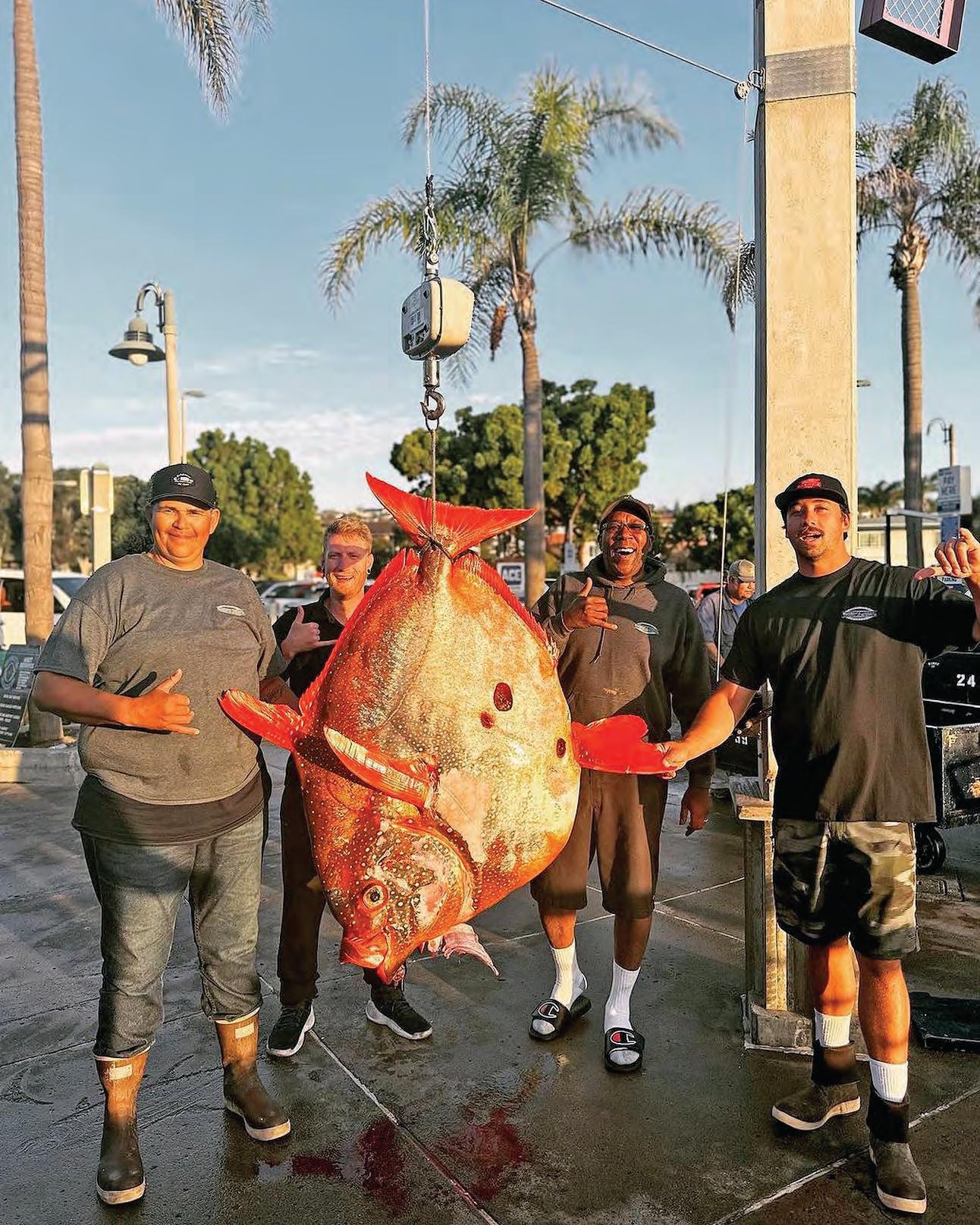
H&M Landing. The fish ate a jig in 300 feet of water, and Leaman subdued it during a 45-minute battle before the crew of the Horizon gaffed it and brought it onboard.
“Once it was on the boat, I think most of us were in dismay,” Leaman told FTW Outdoors. “From the shark bites on its side, to its blend of orange and red, its tail fin slapping the deck, its massive eyes and fins that don’t seem to do much work… It did not look real.”
On Facebook, Capt. Bill Wilkerson, of


the Horizon, said Leaman’s fish is “kind of like a unicorn.” He’s only seen opah caught three times in 40 years.
The current IGFA all-tackle world record Opah weighed 180 pounds, 12 ounces. It was caught out of San Quintin, Mexico in 2014 by Joe Ludlow. Leaman’s fish has been submitted to IGFA for certification.
For more information, visit horizoncharters.com.
PHOTO WATCH VIDEO
HORIZON CHARTERS
smaller chicken dolphins. If lures are your thing I prefer Yozuri Crystal Minnows and honestly color doesn’t matter. Pitch around the weed lines or patches and look deeper down for the bigger Mahi. As for Tuna with all the chumming going on, I like to send down a vertical jig on 60#-80# test at least 100’ below the boat. Working your jig through the water column is a good way to fire up any kind of fish that may be lurking around in the shadows. If you have a large diamond jig I’d put some heavy wire in front of it for a chance at a wahoo. Triple Tail are amazing fish on light tackle and I recommend 15#-20# fluorocarbon and #2 Owner hook. Live
If bottom fishing is your go to joy Vermillion snappers, Groupers, and Rock salmon is my target. For Vermillion snappers I like using a 2-3 hook chicken rig mixed with cut squid and Boston mackerel. Let your weight sit right on the bottom and wait for those 2-3 light bites. Rock salmon and Groupers like to hide out in the rocks and caves, so a slip lead is what I like to use. Heavier leader line for Groupers and larger baits close to the bottom. Feel the bite and start cranking. The first 20’-30’ are the most
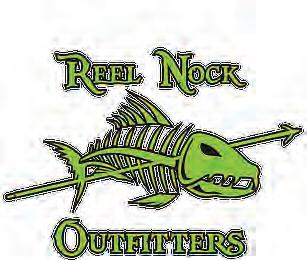
When it comes to offshore fishing don’t give up. There’s a lot of trial and error. Figure out what works best for you and as always keep your lines out and keep them tight.
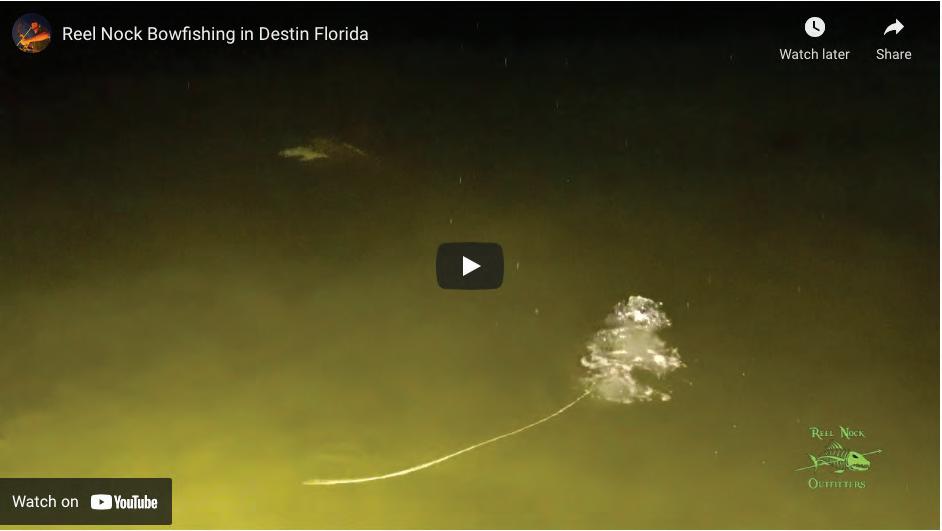
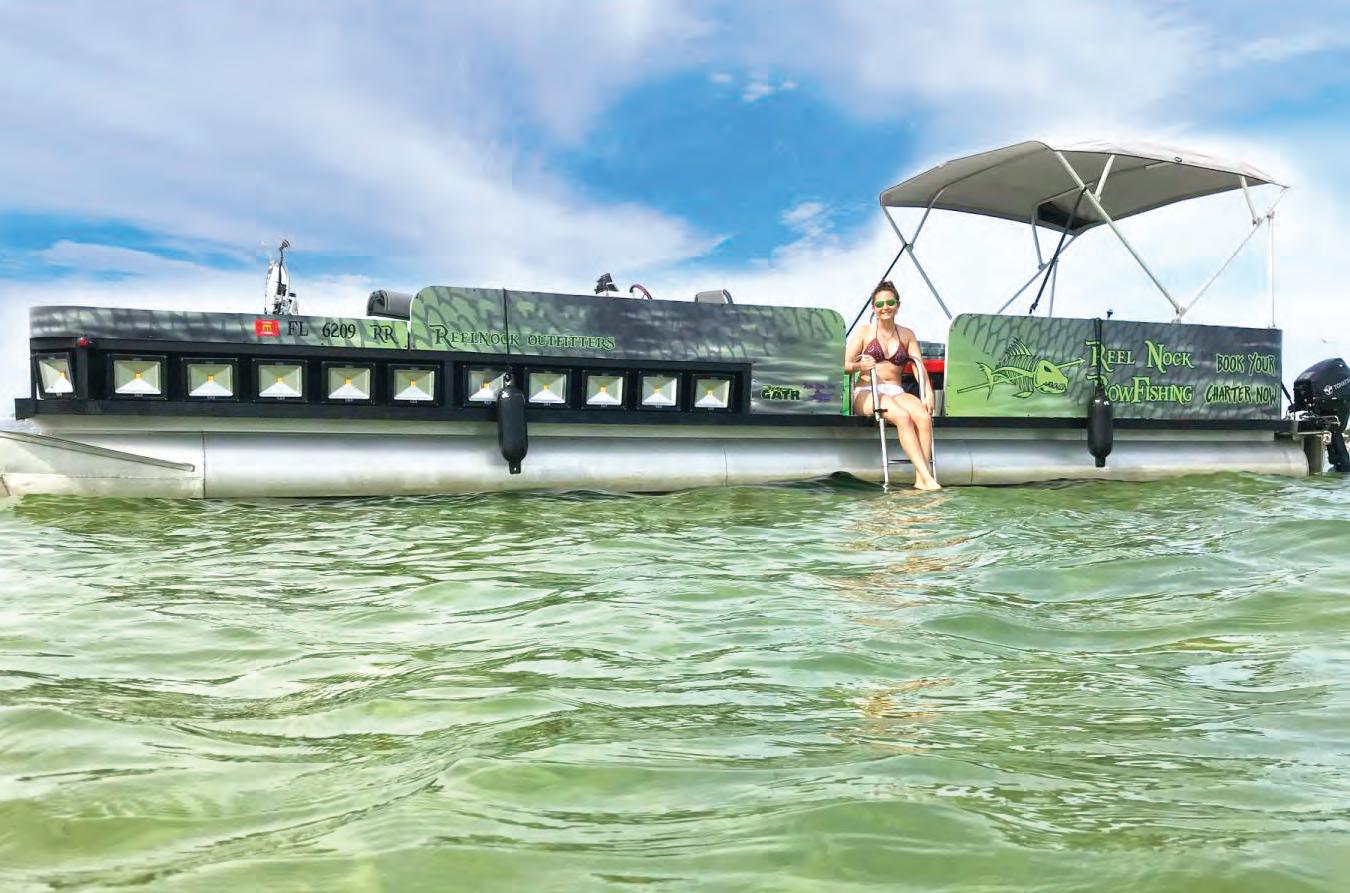
THE ANGLER VIDEO MAGAZINE SEPTEMBER 2023 69 COASTALANGLERMAG.COM • THEANGLERMAG.COM september 2021 pensacola 3 The Wahoo bite has already been crazy this season and is only going to get better. Trolling
Bowfishing rod and reel fishing • trips to craB island plan your next fishing adventure in Beautiful destin, florida! Call or text 850-528-9212 www.reelnockoutfitters.org www.facebook.com/reelnockoutfitters
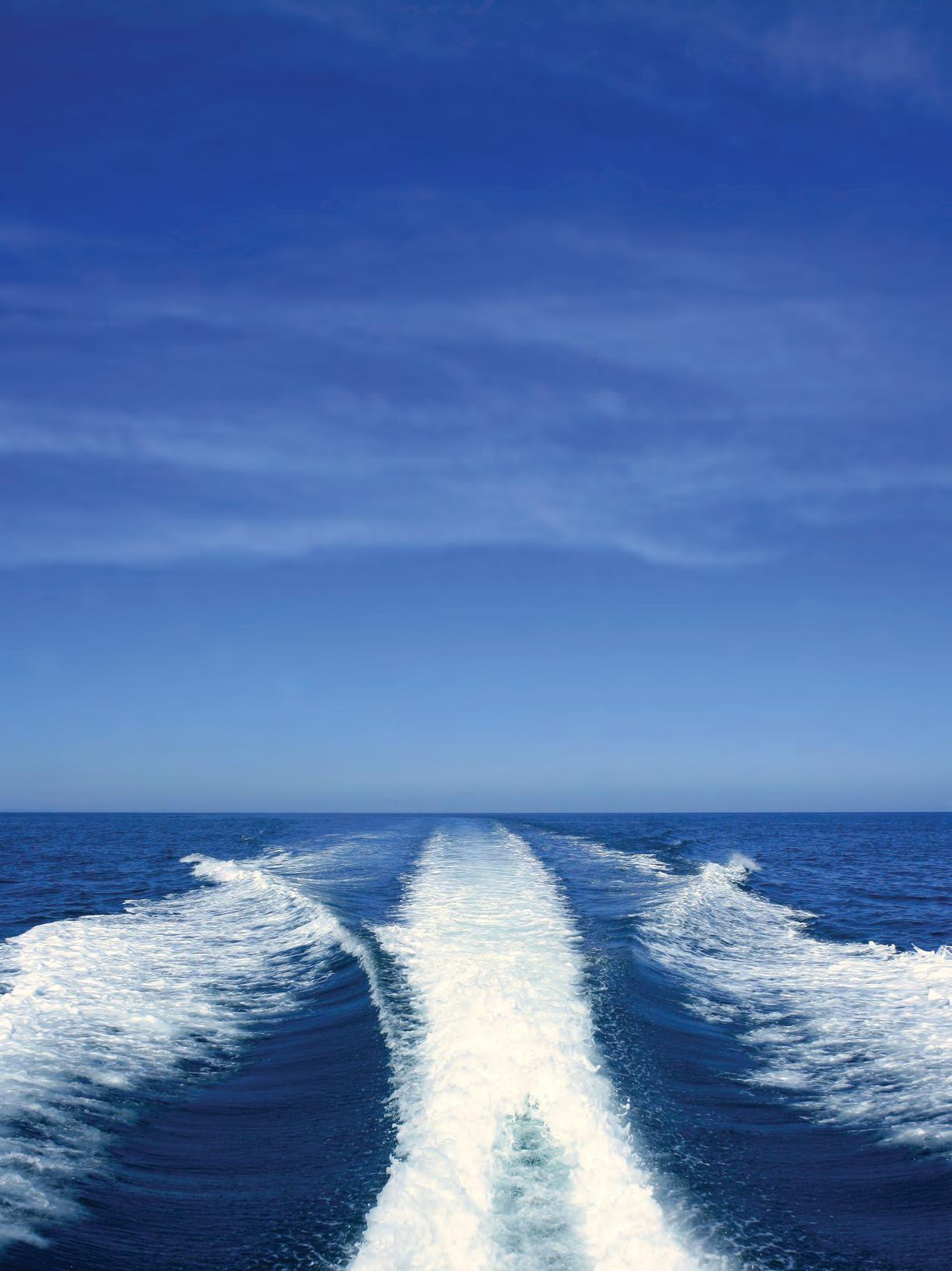
888-800-9794 | info@vidmag.com www.VidMag.com SHARE • SUBSCRIBE • ADVERTISE
The Angler Video Magazine connects fishing and boating enthusiasts with industry news and shared community interests in a unique, industry-first format — a video magazine. Sent to over 3.2 MILLION licensed anglers, The Angler Video Magazine is provided to its readers for FREE. No subscriptions or payments are required for viewing. Support The Angler Video Magazine’s mission to provide FREE content to the recreational fishing and boating communities and industries throughout the world by sharing, subscribing and advertising.



































 Capt. Michael Okruhlik is the inventor of Knockin Tail Lures®, and the owner of www.MyCoastOutdoors.com.
Capt. Michael Okruhlik is the inventor of Knockin Tail Lures®, and the owner of www.MyCoastOutdoors.com.




































 Will
Will




















































 By Nick Carter
By Nick Carter










































 By Emily Hanzlik
By Emily Hanzlik



























 10’s of thousands of compact tractor
10’s of thousands of compact tractor




























 By Michael Fitzsimmons
By Michael Fitzsimmons

























































